

How to Write a Landscaping Business Plan: Complete Guide
- January 30, 2023

👇 Check all our resources on landscaping businesses 👇
Whether you’re looking to raise funding from private investors or to get a loan from a bank (like a SBA loan) for your landscaping business, you will need to prepare a solid business plan.
In this article we go through, step-by-step, all the different sections you need in your landscaping business plan. Use this template to create a complete, clear and solid business plan that get you funded.
1. Executive Summary
This is the first part and the most important section of your business plan. This is the first thing lenders and/or investors will have a look at.
Before we dive into the specifics, keep in mind the executive summary is a summary: keep it to 2 pages maximum. Indeed, your executive summary should briefly sum up the key sections of your business plan as well as presenting the funding ask.
Why do you need a business plan for your landscaping business?
The funding ask (or funding requirement), as explained below, is the reason why any business would have a business plan. Business plans are prepared for one of the 3 following objectives:
- Obtain financing from a bank or any other lender (a SBA loan for example)
- Obtain financing from private investors (business angels, investment funds, etc.)
- Get approval for a private or public grant
How to write an executive summary for a landscaping business plan?
The executive summary of your landscaping business plan should include the following important information:
- Business overview : the name of your company, its legal structure, the business model (franchise vs. independent landscaping business), the type of services you will offer (lawn maintenance, hardscaping, design, etc.), the customers you target (individuals or businesses, etc.)
- Market analysis : how big is the landscaping industry in your area? How many competitors are there? What services do they offer? etc.
- People : who is the management team? what is your/their experience in the landscaping industry?
- Financial plan : what is your expected revenue and profitability for the next 5 years? When do you expect to break-even? Simply include here a chart of your key financials (e.g. revenue, gross Profit, net profit , cash flow)
- Funding ask : what loan/investment/grant are you seeking? How much do you need? How long will this last?

2. Landscaping Business Overview
The business overview section of your landscaping business plan highlights what services your landscaping company offers, to whom as well as how your business is structured legally.
Ideally, this section should include the following details about your business;
- The history of the project: why do you want to start this business today?
- The services you offer and their price range
- Your target customers: who are your customers (businesses or individuals?)
- Your company legal structure
a) History of the Project
Why did you decide to start your own landscaping business? Here a brief company history comes in handy if you want to outshine your competitors in the eyes of an investor (or a lender).
Use this section to mention 2 vital things about your landscaping business, including;
- Your interest and passion for getting into the landscaping business
- The rationale behind you starting a landscaping business today
For example, you might be an experienced landscaping worker and found out there was no company offering landscaping services to businesses in the area where you’re from.
b) Services
Landscaping companies have a number of services they offer to local customers, businesses or individuals. Ultimately, you should prioritize what suits your target audience depending on your market analysis. There are 2 main types of services for landscaping companies:
- Lawn maintenance: one of the most common services. It includes cleanups, pruning, fertilizing, aeration, lime application, mowing, and weed control
- Landscaping services instead include planting, mulching, landscape designing, hardscaping and foundation planting, to mention a few
Of course, there’s nothing wrong with offering both services if you have enough resources. You can also offer your landscaping services individually or as comprehensive packages based on your clients’ needs and budget.

c) Pricing Strategy
It’s crucial to outline your pricing list when writing a landscaping business plan. Focus on the most important details about your pricing structure without going overboard. For example, whilst lawn mowing costs on average $45 per week in the US, the cost of lawn care services ranges from $48 to $211 for homeowners .
Similarly, the cost of landscaping services may vary from one location to another, depending on the target audience. On an hourly basis, average landscaping services cost $50 to $100 per hour on average.
A clear pricing strategy can give you the upper hand when seeking financial support from potential investors and lenders, making it an important part of your landscaping business plan.
Also, it’s important to outline your pricing strategy in your business plan so investors can tie it into your financial projections later on (see more on that below).
d) Target Audience
What’s your target market ? Knowing your consumers will always play a key role in the success of your landscaping business. It also gives you a competitive advantage by helping you identify the existing market gap.
Are you targeting homeowners, commercial property managers, or businesses offices and headquarters? Understanding your target market will help you better define your marketing strategy and retain customers.
e) Legal Structure
Finally, your business overview section should specify what type of business structure you opt for. Is this a corporation or a partnership (LLC)? Who are the investors? How much equity percentage do they own? Is there a Board of Directors? If so, whom? Do they have experience in the industry?
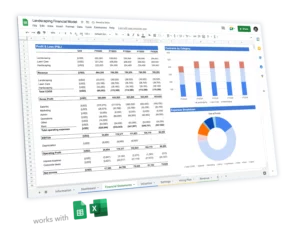
Landscaping Financial Model
Download an expert-built 5-year Excel financial model for your business plan
3. Landscaping Market Analysis
Now that we have covered all about your business, let’s now look at your industry, and more precisely the landscaping industry in your area, your competitors and target audience.
Indeed, before you reach out to lenders or investors, you must prove to them that you understand your market. This helps earn their trust and can make the difference fo them to invest in your business.
a) Landscaping Business Market Overview
You should present in this section the status quo of the landscaping industry in the US, as well as in your city / area. You must address 2 main points here:
How big is the landscaping industry in your area?
- How fast the market is growing?
How big is the landscaping industry in the US?
Before diving into your specific city or area, it’s always good to get a clear overview of the US market first. Indeed, getting national data will help you address all the factors that could affect your business, such as demographics, market demand, and environmental activities.
The landscaping industry has grown at a steady rate of 2.5% per year in the last few years, up to $105 billion in 2021 .
After the US, assess the status of the landscaping market in your city or area. Focus on the zone where you plan to offer your landscaping services.
Naturally, you might not be able to get the data for your specific city or region. Instead, you can estimate the size of your market, for more information on how to do it, read our article on how to estimate TAM, SAM and SOM for your startup . To give you an example, let’s assume you plan to operate in a radius where there are 40 competitors:
As we know the US landscaping industry is worth $105 billion today, and there are about 604,000 landscaping businesses (small and large) in the US in total, we can deduct that the average annual revenue per landscaping company is $175,000.
So we can safely assume the landscaping industry is worth $7,000,000 in the area where you plan to operate. Now, assuming there are 30,000 houses, this means each household that owns a house spend $195 per month in landscaping services, pretty close to the national average.
How fast is the landscaping industry growing in your area?
Growth is an important metric for assessing the status of the landscaping industry in your region.
Here if you don’t find information online or via your research, you can calculate growth using the total number of landscaping businesses in your area.
For instance, if there were 40 landscaping businesses in the region in 2019, which increased to 45 in 2022, it’s safe to assume that the market is growing at 4% per year.

b) Landscaping Competitor Analysis
At the very least, your competitor analysis should answer all or some of these questions:
- How many landscaping businesses are in your region?
- What services do your competitors offer? What’s their average price?
- How many employees do they have on the payroll?
- What’s the approximate number of customers/contracts they serve per month?
After answering these questions, it will be easier to tailor your services and prices to suit the target market.
c) Landscaping Business Customer Analysis
We presented in the Business Overview section who were your target customers. Here instead instead you must show in your business plan that these target customers actually live in the area and need the services you offer.
Indeed, it would be pointless to start a landscaping business in your region when nobody needs your services in the first place.
And having competitors doesn’t necessarily mean your target customers are there. For example, you might not focus on the same customer segment (e.g. individuals homeowners vs. businesses).
There are here a few important questions you must answer:
- What landscaping services do your target customers need?
- How many potential customers are there in the area (for example, if you focus on homeowners, you can use the number of houses in the area as a proxy)?
- How much does the average customer spend on landscaping in the area (if you can’t find the information for your city, use the national average instead)?
4. Sales & Marketing Strategy
The next section of your landscaping business plan gives you a chance to highlight your strategic plan for acquiring new clients.
Start by exploring your unique selling point, the suitability of the proposed marketing strategies, and the overall marketing budget.
a) Landscaping Marketing Channels
Here are a few examples of marketing channels landscaping businesses use:
- Email marketing
- Social media
- Website
- Local advertising (newspapers)
- Register with the online business directories (Yelp, Yellow Pages, etc.)
- Google Business profile and ratings
- Word-of-mouth recommendations

b) What are Your Unique Selling Points (USPs)?
A unique selling point makes you stand out in a competitive market. When getting started, it is the easiest way to win over multiple customers and one of the best strategies for edging out your biggest competitors. You can build your USPs around the following aspects;
- Price : affordable services will most likely appeal to most customers
- Specialization : choosing a specific service helps you stand out (for example, you might focus on landscape design and hardscaping)
- Additional services : you can provide extra services not available in the area
5. Management & People
The 5th section of your landscaping business plan should be about people. It should include 2 main elements:
- The management team and their experience / track record
- The organizational structure: what are the different teams and who reports to whom?
a) Management
Here you should list all the management roles in your company.
Of course, the amount of details you need to include here varies depending on the size of your company. For example, a landscaping business with a number of vehicles and teams would need more detail vs. a small landscaping business run by 1 or 2 persons.
If you plan on running your business independently, you may write a short paragraph explaining who are the co-founders and/or senior managers (if there are any in addition to yourself). It’s important to highlight their experience in the industry and previous relevant professional experiences.

b) Organizational structure
No matter how many leadership roles there are, you should now explain how you intend to run the company from a management standpoint.
What are the different teams (management, sales, operations, mechanics, finance, etc.)? Note that you should include these details even if you haven’t hired anyone yet. It will show lenders and investors that you have a solid hiring and management plan to run the business successfully.
A great addition here is to add an organizational chart that list all the roles, from Directors to managers, key supervisory roles, employees and contractors. Make sure to highlight with reporting lines who manages/supervises whom.

6. Financial Plan
The financial plan is perhaps, with the executive summary, the most important section of any business plan.
Indeed, a solid financial plan tells lenders that your business is viable and can repay the loan you need from them. If you’re looking to raise equity from private investors instead, a solid financial plan will prove them your landscaping business is an attractive investment.
There should be 3 sections to your financial plan section:
- Your historical financials (only if you already operate the business and have financial accounts to show)
- The startup costs of your project (if you start a new landscaping business or if you plan to purchase new equipment and vehicles, etc.)
- Your 5-year financial projections
a) Historical Financials (optional)
In the scenario where you already have some historical financials (a few quarters or a few years), include them. A summary of your financial statements in the form of charts e.g. revenue, gross profit and net profit is enough, save the rest for the appendix.
If you don’t have any, don’t worry, most new businesses don’t have any historical financials and that’s ok. If so, jump to Startup Costs instead.
b) Landscaping Startup Costs
Starting a small one-person landscaping business can cost as little as $500 , but most large-scale landscaping businesses need to spend more on equipment, marketing and staff. That’s why most landscaping businesses typically cost between $15,000 and $50,000 to start (excluding the cost of a vehicle).
As you can see, startup costs vary significantly according to factors like the size of your business, the number of employees, the quality of equipment, the services you offer and the tools needed, etc.
So, we have given you a clear overview below of all the essential costs you can expect to start a small landscaping business with 4 employees. There are 2 types of costs: startup costs and operating costs . For more information on how much it costs to start and run a landscaping business, read our complete guide here .
Note that these costs are for illustrative purposes and depend on several factors which might not fully apply to you.
| Operating cost | Amount (per month) |
|---|---|
| Office / Warehouse | $12,000 |
| Equipment Costs | $5,000 – $8,000 |
| Vehicles (x2) | $20,000 (loan deposit) |
| Licenses & Legal Costs | $2,500 – $3,500 |
c) Landscaping 5-Year Financial Projections
In addition to startup costs, you will now need to build a solid 5-year financial model as part of your business plan for your landscaping business.
Your financial projections should be built using a spreadsheet (e.g. Excel or Google Sheets) and presented in the form of tables and charts in your business plan.
As usual, keep it concise here and save details (for example detailed financial statements, financial metrics, key assumptions used for the projections) for the appendix instead.
Your financial projections should answer at least the following questions:
- How much revenue do you expect to generate over the next 5 years?
- When do you expect to break even?
- How much cash will you burn until you get there?
- What’s the impact of a change in pricing (say 20%) on your margins?
- What is your average customer acquisition cost?
You should include here your 3 financial statements (income statement, balance sheet and cash flow statement). This means you must forecast:
- The number of contracts (customers) you will win over time ;
- Your expected revenue ;
- Operating costs to run the business ;
- Any other cash flow items (e.g. capex, debt repayment, etc.).
When projecting your revenue, make sure to sensitize pricing and the number of contracts as a small change in these assumptions will have a big impact on your revenues.

7. Funding Ask
This is the last section of the business plan of your landscaping business. Now that we have explained what type of landscaping services your company offers and to whom, at what price, but also what’s your marketing strategy, where you go and how you get there, this section must answer the following questions:
- How much funding do you need?
- What financial instrument(s) do you need: is this equity or debt, or even a free-money public grant?
- How long will this funding last?
- Where else does the money come from? If you apply for a SBA loan for example, where does the other part of the investment come from (your own capital, private investors?)
If you raise debt:
- What percentage of the total funding the loan represents?
- What is the corresponding Debt Service Coverage Ratio ?
If you raise equity
- What percentage ownership are you selling as part of this funding round?
- What is the corresponding valuation of your business?
Use of Funds
Any business plan should include a clear use of funds section. This is where you explain how the money will be spent.
Will you spend most of the loan / investment to acquire the cost for the vehicles, tools and equipment? Or will it cover mostly the cost of the salaries of your employees the first few months?
Those are very important questions you should be able to answer in the blink of an eye. Don’t worry, this should come straight from your financial projections. If you’ve built solid projections like in our landscaping financial model template , you won’t have any issues answering these questions.
For the use of funds, we recommend using a pie chart like the one we have in our financial model template where we outline the main expenses categories as shown below.
Related Posts

How Profitable is a Landscaping Business? Profits Analysis
- May 7, 2023

How to Build a Financial Model for a Landscaping Business

Starting a Landscaping Business Costs $39,500 to $43,500
Privacy overview.
| Cookie | Duration | Description |
|---|---|---|
| BIGipServerwww_ou_edu_cms_servers | session | This cookie is associated with a computer network load balancer by the website host to ensure requests are routed to the correct endpoint and required sessions are managed. |
| cookielawinfo-checkbox-advertisement | 1 year | Set by the GDPR Cookie Consent plugin, this cookie is used to record the user consent for the cookies in the "Advertisement" category . |
| cookielawinfo-checkbox-analytics | 11 months | This cookie is set by GDPR Cookie Consent plugin. The cookie is used to store the user consent for the cookies in the category "Analytics". |
| cookielawinfo-checkbox-functional | 11 months | The cookie is set by GDPR cookie consent to record the user consent for the cookies in the category "Functional". |
| cookielawinfo-checkbox-necessary | 11 months | This cookie is set by GDPR Cookie Consent plugin. The cookies is used to store the user consent for the cookies in the category "Necessary". |
| cookielawinfo-checkbox-others | 11 months | This cookie is set by GDPR Cookie Consent plugin. The cookie is used to store the user consent for the cookies in the category "Other. |
| cookielawinfo-checkbox-performance | 11 months | This cookie is set by GDPR Cookie Consent plugin. The cookie is used to store the user consent for the cookies in the category "Performance". |
| CookieLawInfoConsent | 1 year | Records the default button state of the corresponding category & the status of CCPA. It works only in coordination with the primary cookie. |
| elementor | never | This cookie is used by the website's WordPress theme. It allows the website owner to implement or change the website's content in real-time. |
| viewed_cookie_policy | 11 months | The cookie is set by the GDPR Cookie Consent plugin and is used to store whether or not user has consented to the use of cookies. It does not store any personal data. |
| Cookie | Duration | Description |
|---|---|---|
| __cf_bm | 30 minutes | This cookie, set by Cloudflare, is used to support Cloudflare Bot Management. |
| language | session | This cookie is used to store the language preference of the user. |
| Cookie | Duration | Description |
|---|---|---|
| _ga | 2 years | The _ga cookie, installed by Google Analytics, calculates visitor, session and campaign data and also keeps track of site usage for the site's analytics report. The cookie stores information anonymously and assigns a randomly generated number to recognize unique visitors. |
| _ga_QP2X5FY328 | 2 years | This cookie is installed by Google Analytics. |
| _gat_UA-189374473-1 | 1 minute | A variation of the _gat cookie set by Google Analytics and Google Tag Manager to allow website owners to track visitor behaviour and measure site performance. The pattern element in the name contains the unique identity number of the account or website it relates to. |
| _gid | 1 day | Installed by Google Analytics, _gid cookie stores information on how visitors use a website, while also creating an analytics report of the website's performance. Some of the data that are collected include the number of visitors, their source, and the pages they visit anonymously. |
| browser_id | 5 years | This cookie is used for identifying the visitor browser on re-visit to the website. |
| WMF-Last-Access | 1 month 18 hours 11 minutes | This cookie is used to calculate unique devices accessing the website. |
Landscaping Company Business Plan Template
Written by Dave Lavinsky
Landscaping Business Plan
You’ve come to the right place to create your landscaping business plan.
We have helped over 10,000 entrepreneurs and business owners create business plans and many have used them to start or grow their landscaping companies.
Landscaping Business Plan Example
Below is a sample landscaping business plan and template to help you create each section of your landscaping business plan.
Executive Summary
Business overview.
Beautiful Gardens Landscaping Service is a startup landscaping business located in Dallas, Texas. The company is founded by John Martinez, an experienced entrepreneur who has gained valuable knowledge on how to manage a landscaping business during the past five years while working as the manager at Lake Landscaping & Lawn Care. Now that John has experienced managing a landscaping business, he is ready to start his own company, Beautiful Gardens Landscaping Service. John is confident that his landscaping skills, combined with his understanding of business management, will enable him to run a profitable landscaping company of his own. John is recruiting a team of highly qualified professionals to help manage the day-to-day complexities of residential landscaping – sales and marketing, scheduling, customer service, financial management, and landscaper training and support.
Beautiful Gardens Landscaping Service will provide a variety of professional landscaping and lawn care services for residential customers in Dallas, Texas. Beautiful Gardens will be the go-to landscaping business in Dallas for high quality landscaping services of all kinds. The company will be the ultimate choice for prompt, reliable, and courteous customer service that goes above and beyond the competitors.
Product Offering
The following are the services that Beautiful Gardens Landscaping Service will provide:
- Lawn Care and Chemical Application
- Landscape Maintenance
- Landscape Design
- Landscape Construction
- Trimming and Pruning
- Trees and Ornamental Planting and Care
- Perimeter Pest Control
- Vegetation Management
- Gardening and Plant Care Consulting Services
Customer Focus
Beautiful Gardens Landscaping Service will target homeowners in Dallas. The company will also target owners of multi-family residential buildings such as apartment complexes and condominiums. No matter the customer, Beautiful Gardens Landscaping Service will deliver the best communication, service, and high quality landscaping.
Management Team
Beautiful Gardens Landscaping Service will be owned and operated by John Martinez. John is a graduate of Texas University with a Bachelor’s degree in Business Management. He has over five years of experience working as a manager for another local landscaping business. John will be the company’s Chief Executive Officer. He will steer the vision of the business and provide direction for the other managers and executives of the company.
John has recruited a landscaping expert, Lisa Smith, to be the company’s Chief Operating Officer and help oversee the business operations. Lisa will handle the day-to-day operations, including training the landscape personnel, providing consultation services, and overseeing the landscape design process. Lisa is a graduate of California University with a degree in Landscaping Design.
John and Lisa have recruited an experienced marketing director, Robert Johnson, to become a member of the Beautiful Gardens Landscaping Service management team. Robert is a graduate of the University of Maine with a Master’s degree in Sales and Marketing. John and Lisa rely on Robert’s expertise to execute the company’s marketing plan and advertising strategies.
Success Factors
Beautiful Gardens Landscaping Service will be able to achieve success by offering the following competitive advantages:
- Skilled team of landscaping experts who will oversee the process and conduct inspections regularly to ensure all landscapers are adhering to stringent quality standards.
- Beautiful Gardens Landscaping Service makes it easy for customers to obtain its services. The company uses a proprietary software application to engage with customers and ensure transparency throughout the process. Customers can use the app to schedule service, pay their bill, monitor the work being done, leave feedback, and receive customer support. For customers who prefer to communicate in person or over the phone, the company maintains an office space with a customer support representative available during regular business hours every day of the week.
- The company offers competitive pricing and discounts for regular customers.
Financial Highlights
Beautiful Gardens Landscaping Service is seeking $350,000 in debt financing to launch its landscaping business. The funding will be dedicated towards securing the office space and purchasing landscaping equipment and supplies. Funding will also be dedicated towards three months of overhead costs to include payroll of the staff and marketing expenses. The breakout of the funding is below:
- Office space build-out: $120,000
- Landscaping equipment, supplies, and materials: $80,000
- Three months of overhead expenses (payroll, utilities): $130,000
- Marketing costs: $10,000
- Working capital: $10,000

Company Overview
Who is beautiful gardens landscaping service.
Beautiful Gardens Landscaping Service is a newly established landscaping company in Dallas, Texas. Beautiful Gardens will be the go-to landscaping business in Dallas for high quality landscaping services performed by expertly trained professionals. The company will be the ultimate choice for prompt, reliable, and courteous customer service that goes above and beyond its competitors. Beautiful Gardens Landscaping Service will be able to provide a wide variety of landscaping and lawn care services for homeowners who value high quality, reliable service and easy-to-use communication systems.
Beautiful Gardens Landscaping Service will be able to guarantee the quality of its services thanks to the latest and most innovative landscaping project management technology and stringent quality control standards. The company’s team of highly qualified professionals are experienced in landscaping, lawn care, and gardening, thus will be able to provide exceptional results for a wide variety of services from routine maintenance to new landscape design and build-out. Beautiful Gardens also provides consulting services in the areas of landscaping, gardening, and lawn care.
Beautiful Gardens Landscaping Service History
Beautiful Gardens Landscaping Service is owned and operated by John Martinez, an experienced entrepreneur who has gained valuable knowledge on how to manage a landscaping business during the past five years while working as the manager at Lake Landscaping & Lawn Care. Now that John has experienced managing a landscaping business, he is ready to start his own company, Beautiful Gardens Landscaping Service. John is confident that his landscaping skills, combined with his understanding of business management, will enable him to run a profitable landscaping company of his own. John is recruiting a team of highly qualified professionals to help manage the day-to-day complexities of residential landscaping – sales and marketing, scheduling, customer service, financial management, and landscaper training and support.
Since incorporation, Beautiful Gardens Landscaping Service has achieved the following milestones:
- Registered Beautiful Gardens Landscaping Service, LLC to transact business in the state of Texas.
- Has signed a lease to rent the office space.
- Reached out to numerous contacts to include previous employees, landscapers, friends, family, and professional networks to inform them of the new business.
- Began recruiting a staff of accountants, landscapers, and sales personnel to work at Beautiful Gardens Landscaping Service.
Beautiful Gardens Landscaping Service Services
Industry analysis.
The United States Landscaping Services industry is valued at $128.8B and is expected to increase by 2.3% this year. There are more than 600,000 businesses and over 1M people working in the industry nationwide. The states of Florida, California, and New York have the most landscaping businesses of all the states, while Texans spend the most on landscaping services of all states.
Households with higher than average levels of disposable incomes (over $100,000 per year) spend the most on landscaping services for their homes. While these households reduce their spending on non-essential items during times of economic downturns, they are still more consistently spending on landscaping during these times versus lower income households. The number of households in the U.S. in this higher income bracket is expected to increase this year, resulting in growth opportunities for operators in the landscaping industry. Additionally, there is a rising demand for residential landscaping services from millenials and Gen Z consumers as more of them are participating in gardening activities.
The industry faces several challenges including shortage of quality labor, numerous price-based competitors, economic downturns, and high insurance costs. Industry operators can overcome these challenges and find success by researching their competitors, providing quality service by capable personnel, implementing a targeted marketing campaign, and charging fair prices for customers and employees.
Customer Analysis
Demographic profile of target market.
The precise demographics for Dallas, Texas are:
| Total | Percent | |
|---|---|---|
| Total population | 1,680,988 | 100% |
| Male | 838,675 | 49.9% |
| Female | 842,313 | 50.1% |
| 20 to 24 years | 114,872 | 6.8% |
| 25 to 34 years | 273,588 | 16.3% |
| 35 to 44 years | 235,946 | 14.0% |
| 45 to 54 years | 210,256 | 12.5% |
| 55 to 59 years | 105,057 | 6.2% |
| 60 to 64 years | 87,484 | 5.2% |
| 65 to 74 years | 116,878 | 7.0% |
| 75 to 84 years | 52,524 | 3.1% |
Customer Segmentation
Beautiful Gardens will primarily target the following customer profiles:
- Homeowners with annual household incomes of $100,000 or more
- Owners of multi-family residential properties such as apartment complexes and condominiums
- Millennials and Gen Z homeowners who need help starting their own gardens
Competitive Analysis
Direct and indirect competitors.
Beautiful Gardens Landscaping Service will face competition from other companies with similar business profiles. A description of each competitor company is below.
Leif’s Lovely Landscaping Service
Leif’s Lovely Landscaping Service has been operating in the Dallas area for over ten years and has gained a loyal customer base for its excellent service and low prices. Leif’s provides residential homeowners with general landscaping and lawn care services. The company is a small operation and the founder does most of the landscaping work himself. Customers come to Leif’s for reliable, friendly service and the lowest prices in Dallas. The company offers lawn care and chemical application, mulching, tree trimming, and debris cleanup services.
Lake Landscaping & Lawn Care
Founded in 1990 by Henry Lake, Lake Landscaping & Lawn Care is a well-known landscaping and lawn care business that serves all of Dallas-Fort Worth and surrounding areas. The company offers a wide variety of landscaping services for residential homeowners. Services include regular lawn care, trimming, and maintenance, design, construction, and maintenance of landscaping features, and pool service. Lake Landscaping & Lawn Care is owned and operated by Henry Lake, an experienced contractor who designed some of the most prominent outdoor spaces in the area before starting his own business over 30 years ago.
Pete’s Perfect Landscaping
Pete’s Perfect Landscaping is a new Dallas-Texas based company providing landscaping services to customers throughout the city. The company was founded by Peter Smith, an experienced gardener who has been working in the landscaping industry for over 20 years before deciding to start his own landscaping company. Pete’s Perfect Landscaping provides a variety of landscaping services including pruning, trimming, planting, mulching, debris removal, and lawn maintenance.
Competitive Advantage
Beautiful Gardens Landscaping Service will be able to offer the following advantages over its competition:
- Beautiful Gardens Landscaping Service uses a proprietary software application to engage with customers and ensure transparency throughout the process. Customers can use the app to schedule service, pay their bill, monitor the work being done, leave feedback, and receive customer support.
Marketing Plan
Brand & value proposition.
Beautiful Gardens Landscaping Service will offer the unique value proposition to its clientele:
- Beautiful Gardens Landscaping Service makes it easy for customers to obtain its services. The company uses a proprietary software application to engage with customers and ensure transparency throughout the process. Customers can use the app to schedule service, pay their bill, monitor the work being done, leave feedback, and receive customer support.
- For customers who prefer to communicate in person or over the phone, the company maintains an office space with a customer support representative available during regular business hours every day of the week.
Promotions Strategy
The promotions strategy for Beautiful Gardens Landscaping Service is as follows:
Social Media Marketing
The company’s marketing director will create accounts on social media platforms such as LinkedIn, Twitter, Instagram, Facebook, TikTok, and YouTube. He will ensure Beautiful Gardens maintains an active social media presence with regular updates and fun content to get customers excited about the company’s landscaping services.
Professional Associations and Networking
Beautiful Gardens Landscaping Service will become a member of professional associations such as the Landscaping Association, American Gardening Society, and the Texas Lawn Care Association. The leadership team will focus their networking efforts on expanding the company’s vendor and client network.
Print Advertising
Beautiful Gardens Landscaping Service will invest in professionally designed print ads to display in programs or flyers at industry networking events. The company will also invest in ads to display in industry publications and local newspapers.
Website/SEO Marketing
Beautiful Gardens Landscaping Service will utilize the in-house marketing director that designed the print ads to also design the company website. The website will be well organized, informative, and list all the services that Beautiful Gardens is able to provide. The website will also list information on the company’s events and testimonials from satisfied clients.
The marketing director will manage Beautiful Gardens’s website presence with SEO marketing tactics so that when someone types in a search engine “Beautiful Gardens” or “landscaping business near me”, Beautiful Gardens Landscaping Service will be listed at the top of the search results.
The pricing of Beautiful Gardens Landscaping Service will be moderate, but higher than low-end competitors so customers feel they receive value when purchasing the Company’s services.
Operations Plan
The following will be the operations plan for Beautiful Gardens Landscaping Service.
Operation Functions:
- John Martinez will be the CEO of the company. He will oversee the management team and lead the direction of the business. John has spent the past year recruiting the following staff:
- Lisa Smith – Chief Operating Officer who will manage the design and build process, train landscapers, and oversee the activities of the staff.
- Sam Garcia – Bookkeeper who will provide all accounting, tax payments, and monthly financial reporting.
- Robert Johnson – Marketing Director who will oversee all marketing strategies for the company and manage the website, social media, and outreach.
- Joe Williams – Quality Control Manager who will oversee all inspections of the landscapers to ensure stringent compliance with quality standards are met.
Milestones:
Beautiful Gardens Landscaping Service will have the following milestones complete in the next six months.
11/1/2022 – Finalize lease on office space.
11/15/2022 – Finalize employment contracts for the Beautiful Gardens Landscaping Service management team.
12/1/2022 – Begin build-out of the office and purchase equipment.
12/15/2022 – Begin networking at industry events and implement the marketing plan.
1/15/2023 – Finalize contracts for initial landscaping product suppliers and employment contracts for landscapers.
2/15/2023 – Beautiful Gardens Landscaping Service officially opens its office up to customers and starts taking appointments.
Financial Plan
Key revenue & costs.
The revenue drivers for Beautiful Gardens Landscaping Service are the fees charged to customers in exchange for the company’s services. When it comes to pricing, the business will monitor operational costs, average prices charged by competitors, and local market demand to ensure its prices will generate a healthy profit margin.
The cost drivers will be the overhead costs required in order to staff a landscaping business. The expenses will be the payroll cost, utilities, landscaping equipment and supplies, and marketing materials.
Funding Requirements and Use of Funds
Key assumptions.
The following outlines the key assumptions required in order to achieve the revenue and cost numbers in the financials and in order to pay off the startup business loan.
- Average number of appointments per month: 600
- Average fees per month: $15,000
- Overhead costs per year: $400,000
Financial Projections
Income statement.
| FY 1 | FY 2 | FY 3 | FY 4 | FY 5 | ||
|---|---|---|---|---|---|---|
| Revenues | ||||||
| Total Revenues | $360,000 | $793,728 | $875,006 | $964,606 | $1,063,382 | |
| Expenses & Costs | ||||||
| Cost of goods sold | $64,800 | $142,871 | $157,501 | $173,629 | $191,409 | |
| Lease | $50,000 | $51,250 | $52,531 | $53,845 | $55,191 | |
| Marketing | $10,000 | $8,000 | $8,000 | $8,000 | $8,000 | |
| Salaries | $157,015 | $214,030 | $235,968 | $247,766 | $260,155 | |
| Initial expenditure | $10,000 | $0 | $0 | $0 | $0 | |
| Total Expenses & Costs | $291,815 | $416,151 | $454,000 | $483,240 | $514,754 | |
| EBITDA | $68,185 | $377,577 | $421,005 | $481,366 | $548,628 | |
| Depreciation | $27,160 | $27,160 | $27,160 | $27,160 | $27,160 | |
| EBIT | $41,025 | $350,417 | $393,845 | $454,206 | $521,468 | |
| Interest | $23,462 | $20,529 | $17,596 | $14,664 | $11,731 | |
| PRETAX INCOME | $17,563 | $329,888 | $376,249 | $439,543 | $509,737 | |
| Net Operating Loss | $0 | $0 | $0 | $0 | $0 | |
| Use of Net Operating Loss | $0 | $0 | $0 | $0 | $0 | |
| Taxable Income | $17,563 | $329,888 | $376,249 | $439,543 | $509,737 | |
| Income Tax Expense | $6,147 | $115,461 | $131,687 | $153,840 | $178,408 | |
| NET INCOME | $11,416 | $214,427 | $244,562 | $285,703 | $331,329 |
Balance Sheet
| FY 1 | FY 2 | FY 3 | FY 4 | FY 5 | ||
|---|---|---|---|---|---|---|
| ASSETS | ||||||
| Cash | $154,257 | $348,760 | $573,195 | $838,550 | $1,149,286 | |
| Accounts receivable | $0 | $0 | $0 | $0 | $0 | |
| Inventory | $30,000 | $33,072 | $36,459 | $40,192 | $44,308 | |
| Total Current Assets | $184,257 | $381,832 | $609,654 | $878,742 | $1,193,594 | |
| Fixed assets | $180,950 | $180,950 | $180,950 | $180,950 | $180,950 | |
| Depreciation | $27,160 | $54,320 | $81,480 | $108,640 | $135,800 | |
| Net fixed assets | $153,790 | $126,630 | $99,470 | $72,310 | $45,150 | |
| TOTAL ASSETS | $338,047 | $508,462 | $709,124 | $951,052 | $1,238,744 | |
| LIABILITIES & EQUITY | ||||||
| Debt | $315,831 | $270,713 | $225,594 | $180,475 | $135,356 | |
| Accounts payable | $10,800 | $11,906 | $13,125 | $14,469 | $15,951 | |
| Total Liability | $326,631 | $282,618 | $238,719 | $194,944 | $151,307 | |
| Share Capital | $0 | $0 | $0 | $0 | $0 | |
| Retained earnings | $11,416 | $225,843 | $470,405 | $756,108 | $1,087,437 | |
| Total Equity | $11,416 | $225,843 | $470,405 | $756,108 | $1,087,437 | |
| TOTAL LIABILITIES & EQUITY | $338,047 | $508,462 | $709,124 | $951,052 | $1,238,744 |
Cash Flow Statement
| FY 1 | FY 2 | FY 3 | FY 4 | FY 5 | ||
|---|---|---|---|---|---|---|
| CASH FLOW FROM OPERATIONS | ||||||
| Net Income (Loss) | $11,416 | $214,427 | $244,562 | $285,703 | $331,329 | |
| Change in working capital | ($19,200) | ($1,966) | ($2,167) | ($2,389) | ($2,634) | |
| Depreciation | $27,160 | $27,160 | $27,160 | $27,160 | $27,160 | |
| Net Cash Flow from Operations | $19,376 | $239,621 | $269,554 | $310,473 | $355,855 | |
| CASH FLOW FROM INVESTMENTS | ||||||
| Investment | ($180,950) | $0 | $0 | $0 | $0 | |
| Net Cash Flow from Investments | ($180,950) | $0 | $0 | $0 | $0 | |
| CASH FLOW FROM FINANCING | ||||||
| Cash from equity | $0 | $0 | $0 | $0 | $0 | |
| Cash from debt | $315,831 | ($45,119) | ($45,119) | ($45,119) | ($45,119) | |
| Net Cash Flow from Financing | $315,831 | ($45,119) | ($45,119) | ($45,119) | ($45,119) | |
| Net Cash Flow | $154,257 | $194,502 | $224,436 | $265,355 | $310,736 | |
| Cash at Beginning of Period | $0 | $154,257 | $348,760 | $573,195 | $838,550 | |
| Cash at End of Period | $154,257 | $348,760 | $573,195 | $838,550 | $1,149,286 |
Landscaping Company Business Plan FAQs
What is a landscaping company business plan.
A landscaping company business plan is a plan to start and/or grow your landscaping company business. Among other things, it outlines your business concept, identifies your target customers, presents your marketing plan and details your financial projections.
You can easily complete your landscaping company business plan using our Landscaping Company Business Plan Template here .
What are the Main Types of Landscaping Companies?
There are a number of different kinds of landscaping companies , some examples include: Commercial, Residential, and Arborists.
How Do You Get Funding for Your Landscaping Company Business Plan?
Landscaping companies are often funded through small business loans. Personal savings, credit card financing and angel investors are also popular forms of funding. This is true for a business plan for landscaping and a lawn care business plan.
What are the Steps To Start a Landscaping Company Business?
Starting a landscaping company business can be an exciting endeavor. Having a clear roadmap of the steps to start a business will help you stay focused on your goals and get started faster.
1. Develop A Landscaping Company Business Plan - The first step in starting a business is to create a detailed landscaping company business plan that outlines all aspects of the venture. This should include potential market size and target customers, the services or products you will offer, pricing strategies and a detailed financial forecast.
2. Choose Your Legal Structure - It's important to select an appropriate legal entity for your landscaping company business. This could be a limited liability company (LLC), corporation, partnership, or sole proprietorship. Each type has its own benefits and drawbacks so it’s important to do research and choose wisely so that your landscaping company business is in compliance with local laws.
3. Register Your Landscaping Company Business - Once you have chosen a legal structure, the next step is to register your landscaping company business with the government or state where you’re operating from. This includes obtaining licenses and permits as required by federal, state, and local laws.
4. Identify Financing Options - It’s likely that you’ll need some capital to start your landscaping company business, so take some time to identify what financing options are available such as bank loans, investor funding, grants, or crowdfunding platforms.
5. Choose a Location - Whether you plan on operating out of a physical location or not, you should always have an idea of where you’ll be based should it become necessary in the future as well as what kind of space would be suitable for your operations.
6. Hire Employees - There are several ways to find qualified employees including job boards like LinkedIn or Indeed as well as hiring agencies if needed – depending on what type of employees you need it might also be more effective to reach out directly through networking events.
7. Acquire Necessary Landscaping Company Equipment & Supplies - In order to start your landscaping company business, you'll need to purchase all of the necessary equipment and supplies to run a successful operation.
8. Market & Promote Your Business - Once you have all the necessary pieces in place, it’s time to start promoting and marketing your landscaping company business. This includes creating a website, utilizing social media platforms like Facebook or Twitter, and having an effective Search Engine Optimization (SEO) strategy. You should also consider traditional marketing techniques such as radio or print advertising.
Learn more about how to start a successful landscaping company business and how to write landscape business plan :
- How to Start a Landscaping Company Business
Where Can I Get a Landscaping Business Plan PDF?
You can download our free landscaping business plan template PDF here . This is a sample landscaping business plan template you can use in PDF format.
How to write an effective landscaping business plan

Key takeaways
- An organized business plan paves the way to launch a successful landscaping company
- Landscaping business plans are just as important for new companies as they are for established companies seeking investors
- There are seven core sections of a landscaping business plan that can help you succeed and reach profitability
A landscaping business plan is a must if you’re thinking about starting your own landscaping company or seeking funds to grow your business. More than just a document, a business plan is a valuable tool all small business owners should rely on to plan a successful company.
Business plans benefit companies of all stages—whether you’re just launching your lawn care business or already have a few years under your belt. In fact, companies that take the time to write a business plan typically grow 30% faster than those that don’t .
Although writing a business plan takes a significant amount of planning and research, the process doesn’t need to be overly complicated. There are seven core sections to include. Learn how to write your landscaping business plan so you can set your company up for success and secure the funding you need from potential investors.
7 core sections of a landscaping business plan
A landscaping business plan allows you to set your company up for success. It helps you figure out if you have a viable business idea, creates a roadmap for launching your business, and organizes your thoughts.
Your landscaping business plan should include the following seven sections:
- Executive summary
- Business description
- Market analysis
- Services or product line
- Operations and management
- Marketing and sales
- Financial factors
Let’s review the specific details you should include in each section of your business plan.
1. Executive summary
An executive summary gives an overall description of your company and kicks off your business plan . It describes who you are, what you do, and why your landscaping company will succeed.
You can keep this section brief and high level, but make sure to include the following:
- Mission statement
- Description of your business
- Leadership team and number of employees
- Services you offer
- Where you’re doing business
- Why you’ll succeed
It’s good practice to write your executive summary after you’ve filled out all other sections of your business plan . This will help you first figure out all the details regarding your business, allowing you to then craft an effective executive summary .
2. Business description
The business description goes more in-depth and covers the finer details of your landscaping business . This is where you explain your competitive advantage, which problems you solve, and why your company will succeed in your market.
Highlight the value you bring to consumers and what sets you apart from your competition. Be clear about what makes you better than competitors and outline your company’s strengths.
Do you have employees who have many years of experience in the landscaping business ? Is there an opening in the market that makes you uniquely fit to fill a certain niche?
Also, discuss which customers you plan on serving. Is your target market more focused on residential customers, like homeowners ? Or will you go after commercial customers, such as offices and larger business accounts?
3. Market analysis
Before jumping into starting your own landscaping business , you must take a look at the overall industry and your competition . Analyzing the market helps you determine if there’s enough room in your area for another business like yours to be successful.
Take a look at the landscaping industry as a whole. Is consumer spending within the landscaping industry on the rise?
You can estimate market saturation by simply taking a count of how many landscaping businesses are operating in your area. Figure out where these landscaping companies serve and determine if there’s an opportunity for you to enter the market and win over new customers.
Analyze what these competitors are doing well and find areas for improvement. Reading through your competitors’ Yelp reviews is an easy way to figure out what their strengths and weaknesses are from a consumer standpoint.
Understanding the strengths and weaknesses of other landscaping companies will enable you to optimize your business practices and earn market share when first starting out.
4. Services or product line
The services and product line section of your landscaping business plan tells readers how you expect to make money. Specify the exact lawn care services you’ll provide customers and which niche you’ll serve.
Landscaping companies can offer more than only lawn mowing, but it’s best to choose only a few services you can adequately offer without overextending yourself. Service options may include:
- I nstalling sod or mulch
- Planting flowers and other plants
- Fertilizing
- Pest control
- Landscape design
- Ongoing lawn maintenance
Pick the landscaping services you’re qualified to offer and list them in this section. It’s also helpful if you discuss the frequency of your services. For example, are most customers receiving weekly lawn cutting or will you provide services on a bi-weekly basis?
5. Operations and management
The operations section of your landscaping business plan highlights what type of business structure you’re forming and how your leadership team is organized.
Explain what type of business you’re forming. You can choose between a sole proprietorship, partnership, limited liability company (LLC), or corporation. You can find more information by reading through our guide on registering your business .
You’ll then need to provide an organizational chart that introduces the leaders of your company and provides a hierarchy of your team. Detail who holds which responsibilities and the hierarchy of your leadership team. If you’re the only member of your company, you can give a professional overview of yourself.
Talk about each employee and give each person’s years of experience and qualifications. Highlight areas that show why they’re the right fit for the job and how they’ll help your business succeed. You can even include brief resumes of your key employees to strengthen this section.
6. Marketing and sales
The marketing and sales section of your landscaping business plan tells readers how you’ll find and retain customers. There are many different landscaping marketing strategies that can help you find new leads and build lasting relationships with current customers.
A professional-looking website is a significant aspect of your marketing strategy . It will serve as the face of your company online. Most marketing channels will direct potential customers to your website.
You’ll also need to find ways to capture the attention of potential customers and encourage them to visit your website or contact you directly via phone or email. Some effective marketing strategies include:
- Email marketing
- Referral program
- Pay-per-click digital advertising
- Social media marketing
- Claiming your Yelp Business Page
- Search engine optimization (SEO)
- Content marketing
Choose the appropriate strategies, create a marketing plan , and highlight them in this section. Explain how you expect to find new leads to grow your business and how you plan on building trust , retaining current clients and earning customer loyalty .
Get a free Yelp page
Promote your business to local customers.
7. Financial factors
The finance section of your lawn care business plan offers realistic financial projections for your company. You’ll need to show readers that your business will be financially stable, especially if you’re seeking funding .
Analyzing your financials will help you determine if a landscaping business is worth pursuing. It’s important that you’re realistic with your expectations and have the appropriate funds to launch your business.
List all of the startup costs you expect to encounter. This can include expenditures like a lawnmower , work vehicles, edgers , or trimmers . From there you can determine the pricing of your services.
You can include financial statements like income statements, balance sheets , and cash flow statements if you’ve already launched your business. This will give tangible evidence for potential investors or lenders to determine if you have a viable business idea they’re willing to put money into.
You can also add a funding request if you’re seeking investment from a third party. Just be sure to include how much capital you’ll need, what you intend on doing with the funds, and how long investors can expect for your company to reach profitability . The time it takes you to reach profitability will depend on startup costs, pricing, and how quickly you can build your customer base.
Build a strong foundation with your business plan
It’s in your best interest to write a business plan before you embark on your entrepreneurial endeavor. It will serve as the foundation of your company and guide your future decisions. A well-thought-out business plan allows you to confidently navigate uncharted waters with a roadmap to follow.
Once you’ve organized your landscaping business plan , you can hit the ground running. After your business starts picking up, claim your Yelp Business Page and begin receiving reviews from happy customers.
The information above is provided for educational and informational purposes only. It is not intended to be a substitute for professional advice and may not be suitable for your circumstances. Unless stated otherwise, references to third-party links, services, or products do not constitute endorsement by Yelp.
Related stories

How to write a business plan and why you need one
Learn how to write a business plan, including traditional and lean startup plans, and discover why these documents are crucial for success.

The ultimate guide to starting a small business
This 9-step guide will help you learn what it takes to start your own small business and smoothly transition into entrepreneurship.

9 types of business insurance you may need right now
Learn about the different types of business insurance you can purchase so you can focus on growing your company no matter what comes your way.

Landscaping Business Plan Template
Written by Dave Lavinsky

Landscaping businesses run the gamut from one-person lawn care services to huge companies with dozens of locations. As long as people and businesses have lawns, there will always be work, yet many landscapers fail in the first year, often due to haphazard and unsustainable growth. A written business plan can help you avoid this trap by delineating a clear road map for organized growth. In addition, if you plan to seek outside funding, your business plan is essential to convincing investors or lenders to take a chance on your company.
Over the past 20+ years, we have helped over 2,000 entrepreneurs create business plans to start and grow their landscaping companies. On this page, we will first give you some background information with regards to the importance of business planning. We will then go through a landscaping business plan step-by-step so you can create your plan today.
Download our Ultimate Landscaping Business Plan Template here >
What is a Landscaping Business Plan?
A business plan provides a snapshot of your landscaping business as it stands today, and lays out your growth plan for the next five years. It explains your business goals and your strategy for reaching them. It also includes market research to support your plans.
Why You Need a Business Plan for a Landscaping Company
If you’re looking to start a landscaping business or grow your existing landscaping business you need a business plan. A business plan will help you raise funding, if needed, and plan out the growth of your landscaping business in order to improve your chances of success. Your landscaping business plan is a living document that should be updated annually as your company grows and changes.
Source of Funding for Landscaping Businesses
With regards to funding, the main sources of funding for a landscaping company are personal savings, credit cards, bank loans and angel investors. With regards to bank loans, banks will want to review your business plan and gain confidence that you will be able to repay your loan and interest. To acquire this confidence, the loan officer will not only want to confirm that your financials are reasonable. But they will want to see a professional plan. Such a plan will give them the confidence that you can successfully and professionally operate a business.
The second most common form of funding for a landscaping company is angel investors. Angel investors are wealthy individuals who will write you a check. They will either take equity in return for their funding, or, like a bank, they will give you a loan.
Finish Your Business Plan Today!
How to write a business plan for a landscaping company.
Your business plan should include 10 sections as follows:
Executive Summary
Your executive summary provides an introduction to your business plan, but it is normally the last section you write because it provides a summary of each key section of your plan.
The goal of your Executive Summary is to quickly engage the reader. Explain to them the type of landscaping company you are operating and the status; for example, are you a startup, do you have a landscaping business that you would like to grow, or are you operating a chain of landscaping companies.
Next, provide an overview of each of the subsequent sections of your plan. For example, give a brief overview of the landscaping industry. Discuss the type of landscaping company you are operating. Detail your direct competitors. Give an overview of your target customers. Provide a snapshot of your marketing plan. Identify the key members of your team. And offer an overview of your financial plan.
Company Analysis
In your company analysis, you will detail the type of landscaping company you are operating.
For example, you might operate one of the following types:
- Commercial : this type of landscaping company provides services to commercial facilities, municipal buildings, and campuses. This type of business provides lawn maintenance, as well as tree and shrub services and exterior landscaping installation.
- Residential : this type of landscaping company typically focuses on lawn maintenance for households and multifamily properties.
- Landscape design : this type of landscaping company includes the construction of embankments, terraces and retaining walls used in landscape structures, in addition to walkways, decks, fences, ponds and similar structures.
- Arborist services : Arborists undertake the cultivation and management of individual trees or trees within a small area, as opposed to similar professionals in the forestry industries. Arborist services also include tree felling and surgery.
In addition to explaining the type of landscaping company you operate, the Company Analysis section of your business plan needs to provide background on the business.
Include answers to question such as:
- When and why did you start the business?
- What milestones have you achieved to date? Milestones could include sales goals you’ve reached, new store openings, etc.
- Your legal structure. Are you incorporated as an S-Corp? An LLC? A sole proprietorship? Explain your legal structure here.
Industry Analysis

While this may seem unnecessary, it serves multiple purposes.
First, researching the landscaping industry educates you. It helps you understand the market in which you are operating.
Secondly, market research can improve your strategy particularly if your research identifies market trends. For example, if there was a trend towards residential outdoor kitchens, it would be helpful to ensure your plan calls for employing plenty of skilled labor.
The third reason for market research is to prove to readers that you are an expert in your industry. By conducting the research and presenting it in your plan, you achieve just that.
The following questions should be answered in the industry analysis section of your landscaping business plan:
- How big is the landscaping industry (in dollars)?
- Is the market declining or increasing?
- Who are the key competitors in the market?
- Who are the key suppliers in the market?
- What trends are affecting the industry?
- What is the industry’s growth forecast over the next 5 – 10 years?
- What is the relevant market size? That is, how big is the potential market for your landscaping company. You can extrapolate such a figure by assessing the size of the market in the entire country and then applying that figure to your local population.
Customer Analysis
The customer analysis section of your lawn care business plan must detail the customers you serve and/or expect to serve.
The following are examples of customer segments: families, baby boomers, businesses, etc.
As you can imagine, the customer segment(s) you choose will have a great impact on the type of landscaping company you operate. Clearly baby boomers would want different pricing and product options, and would respond to different marketing promotions than businesses.
Try to break out your target customers in terms of their demographic and psychographic profiles. With regards to demographics, include a discussion of the ages, genders, locations and income levels of the customers you seek to serve. Because most landscaping companies primarily serve customers living in their same city or town, such demographic information is easy to find on government websites.
Psychographic profiles explain the wants and needs of your target customers. The more you can understand and define these needs, the better you will do in attracting and retaining your customers.
Finish Your Landscaping Business Plan in 1 Day!
Don’t you wish there was a faster, easier way to finish your business plan?
With Growthink’s Ultimate Landscaping Business Plan Template you can finish your plan in just 8 hours or less!
Competitive Analysis
Your competitive analysis should identify the indirect and direct competitors your business faces and then focus on the latter.
Direct competitors are other landscaping businesses.
Indirect competitors are other options that customers have to choose from that aren’t direct competitors. This includes DIY platforms such as TaskRabbit, or doing the landscaping themselves. You need to mention such competition to show you understand that not everyone uses a landscaping business for lawn maintenance.
With regards to direct competition, you want to detail the other landscaping businesses with which you compete. Most likely, your direct competitors will be landscaping businesses located very close to your location.
For each such competitor, provide an overview of their businesses and document their strengths and weaknesses. Unless you once worked at your competitors’ businesses, it will be impossible to know everything about them. But you should be able to find out key things about them such as:
- What types of customers do they serve?
- What products/services do they offer?
- What is their pricing (premium, low, etc.)?
- What are they good at?
- What are their weaknesses?
With regards to the last two questions, think about your answers from the customers’ perspective. And don’t be afraid to ask your competitors’ customers what they like most and least about them.
The final part of your competitive analysis section is to document your areas of competitive advantage. For example:
- Will you provide superior landscaping services?
- Will you provide landscaping services that your competitors don’t offer?
- Will you make it easier or faster for customers to schedule your services?
- Will you provide better customer service?
- Will you offer better pricing?
Think about ways you will outperform your competition and document them in this section of your plan.
Marketing Plan
Traditionally, a marketing plan includes the four P’s: Product, Price, Place, and Promotion. For a lawn care business plan, your marketing plan should include the following:
Product : in the product section you should reiterate the type of landscaping business that you documented in your Company Analysis. Then, detail the specific products you will be offering. For example, in addition to mowing and trimming lawns, will you offer services such as insect and weed control?
Price : Document the prices you will offer and how they compare to your competitors. Essentially in the product and price sub-sections of your marketing plan, you are presenting the services you offer and their prices.
Place : Place refers to the location of your landscaping business. Document your location and mention how the location will impact your success. For example, is your landscaping business located near a garden supply store, or greenhouse, etc. Discuss how your location might provide a steady stream of customers.
Promotions : the final part of your landscaping business marketing plan is the promotions section. Here you will document how you will drive customers to your location(s). The following are some promotional methods you might consider:
- Advertising in local papers and magazines
- Reaching out to local bloggers and websites
- Pay per click advertising
- Local radio advertising
- Banner ads at local venues
Operations Plan
While the earlier sections of your lawn care business plan explained your goals, your operations plan describes how you will meet them. Your operations plan should have two distinct sections as follows.
Everyday short-term processes include all of the tasks involved in running your landscaping business such as serving customers, procuring supplies, keeping the equipment maintained, etc.
Long-term goals are the milestones you hope to achieve. These could include the dates when you expect to serve your 100th customer, or when you hope to reach $X in sales. It could also be when you expect to hire your Xth employee or launch in a new city.
Management Team
To demonstrate your landscaping business’s ability to succeed as a business, a strong management team is essential. Highlight your key players’ backgrounds, emphasizing those skills and experiences that prove their ability to grow a company.
Ideally you and/or your team members have direct experience in the landscaping business. If so, highlight this experience and expertise. But also highlight any experience that you think will help your business succeed.
If your team is lacking, consider assembling an advisory board. An advisory board would include 2 to 8 individuals who would act like mentors to your business. They would help answer questions and provide strategic guidance. If needed, look for advisory board members with experience in landscaping businesses and/or successfully running retail and small businesses.
Financial Plan
Your financial plan should include your 5-year financial statement broken out both monthly or quarterly for the first year and then annually. Your financial statements include your income statement, balance sheet and cash flow statements.

In developing your income statement, you need to devise assumptions. For example, will you serve 100 customers per week or 200? And will sales grow by 2% or 10% per year? As you can imagine, your choice of assumptions will greatly impact the financial forecasts for your business. As much as possible, conduct research to try to root your assumptions in reality.
Balance Sheets : While balance sheets include much information, to simplify them to the key items you need to know about, balance sheets show your assets and liabilities. For instance, if you spend $100,000 on building out your landscaping business (purchasing equipment, etc.), that will not give you immediate profits. Rather it is an asset that will hopefully help you generate profits for years to come. Likewise, if a bank writes you a check for $100.000, you don’t need to pay it back immediately. Rather, that is a liability you will pay back over time.

In developing your Income Statement and Balance Sheets be sure to include several of the key costs needed in starting or growing a landscaping business:
- Cost of equipment like mowers, trailers, weed trimmers, clippers, etc.
- Cost of maintaining an adequate amount of supplies (i.e. bug and weed killer, etc.)
- Payroll or salaries paid to staff
- Business insurance
- Taxes and permits
- Legal expenses
Attach your full financial projections in the appendix of your plan along with any supporting documents that make your plan more compelling. For example, you might include your store design blueprint or location lease.
Landscaping Business Plan Summary
Putting together a business plan for your landscaping business is a worthwhile endeavor. If you follow the template above, by the time you are done, you will truly be an expert. You will really understand the landscaping business, your competition and your customers. You will have developed a solid lawn care business plan and will really understand what it takes to launch and grow a successful landscaping business.
Download Our Landscaping Business Plan PDF
You can download our lawn care business plan example pdf here. This is a business plan template you can use in PDF format.
Landscaping Business Plan FAQs
What is the easiest way to complete my landscaping business plan.
Growthink's Ultimate Landscaping Business Plan Template allows you to quickly and easily complete your Landscaping Business Plan.
Where Can I Download a Sample Landscaping Business Plan PDF?
You can download our landscaping business plan sample pdf here. This is a business plan template you can use in PDF format.
Don’t you wish there was a faster, easier way to finish your Landscaping business plan?
OR, Let Us Develop Your Plan For You
Since 1999, Growthink has developed business plans for thousands of companies who have gone on to achieve tremendous success. Click here to hire someone to write a business plan for you from Growthink’s team.
Other Helpful Business Plan Articles & Templates

Free Landscape Business Plan Template (+PDF Download)
Read Time 6 minutes
Author Stephanie Figy
Published February 21, 2023
Table of Contents
1. Executive summary
2. company overview, 3. landscaping services, 4. landscaping pricing, 5. market analysis, 6. competitor analysis , 7. marketing plan and sales strategy , 8. management plan, 9. financial plan, set up your landscaping business for success.
A landscape business plan is essential for securing bank loans, managing startup costs, and maintaining cash flow. Even the most seasoned landscape business owner needs a dynamic roadmap to guide operations and inform goal-setting.
Annually reviewing and adjusting your company’s business plan helps you to scale your landscape business strategically.
This article describes what to include in a landscape business plan and provides a free landscape business plan template to get started.
>> Download Aspire’s FREE landscape business plan template.
The executive summary serves as a strategic snapshot of your landscape business plan. It should be compelling to capture the attention of potential partners and lenders.
The executive summary briefly describes the new business, its mission, and its goals. Summarize the most critical aspects of the plan, such as:
Market opportunities
Services offered
Financial projections
If you’re applying for funding, specify the amount , how you intend to use it , and, more importantly, how it will increase your profit margins .
Even though the executive summary comes first in the plan, write it last to identify and highlight the most crucial elements of your plan, ensuring that it presents a well-rounded and compelling case for your landscape business.
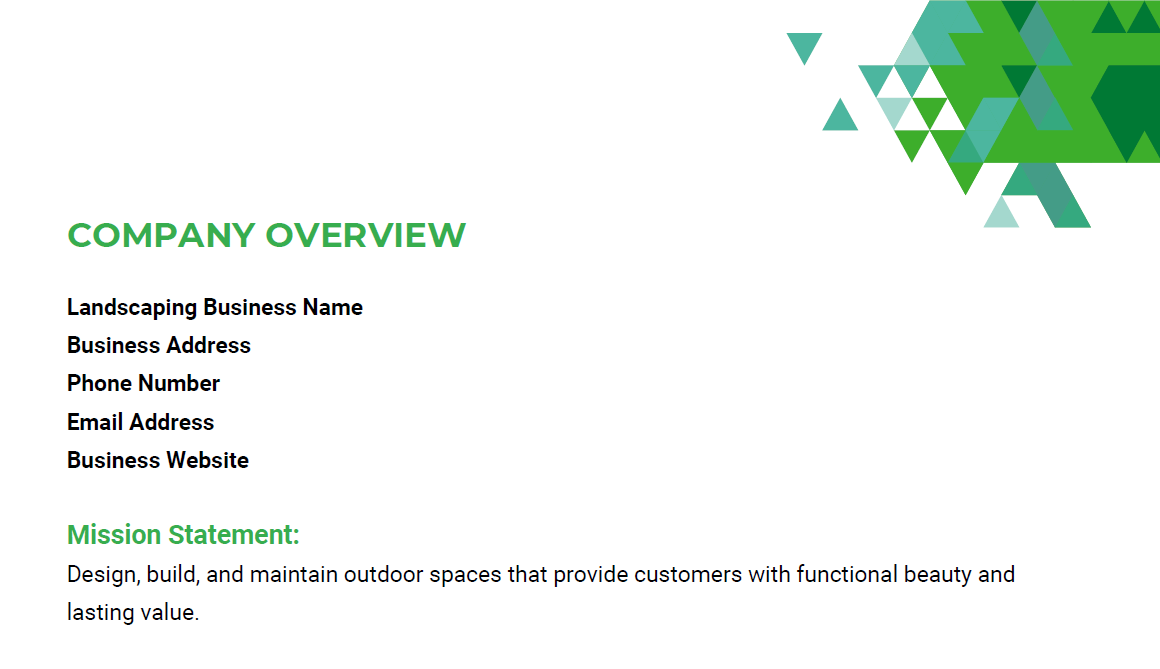
The company overview is where you start to dig into the details of your landscaping or lawn maintenance business. It should include specifics, such as:
Landscaping business name
Business address
Phone number
Email address
Business website
In addition to the nuts and bolts, a company overview is where business owners state their mission statement , vision statement , and core values . This gives the reader a comprehensive understanding of the company’s business identity.
In this section, list your various landscaping services, such as routine lawn care services, landscape design, or mulch installation. For each service type, detail the:
Potential profitability
Scalability
Industry relevance
Strategic importance
List any specialized equipment or certifications that enable you to perform unique services or differentiate you in the marketplace. Also, determine whether you plan to provide these services to homeowners, commercial clients, or both.
Some landscape companies in colder climates pivot to snow removal during the winter. If that’s a part of your business model, include the related services in this section. This demonstrates your capacity to diversify and sustain your business during off-peak seasons, contributing to overall revenue stability and client retention.
Next, outline your pricing strategy, including the pricing model or models your business uses, such as flat-rate , project-based , or hourly pricing. Note that pricing depends on factors like:
Market demand
Competition
You may also list prices from a few competitors to show where your business stands in the marketplace. Include how your pricing strategy positions your business, whether as a cost leader , a premium service provider , or a value-driven option .
Explain if your pricing strategy allows flexibility, such as offering package deals or customizing services based on client preferences. If applicable, discuss strategies to attract and retain clients, such as:
Discount programs
Seasonal promotions
Membership programs
Referral incentives
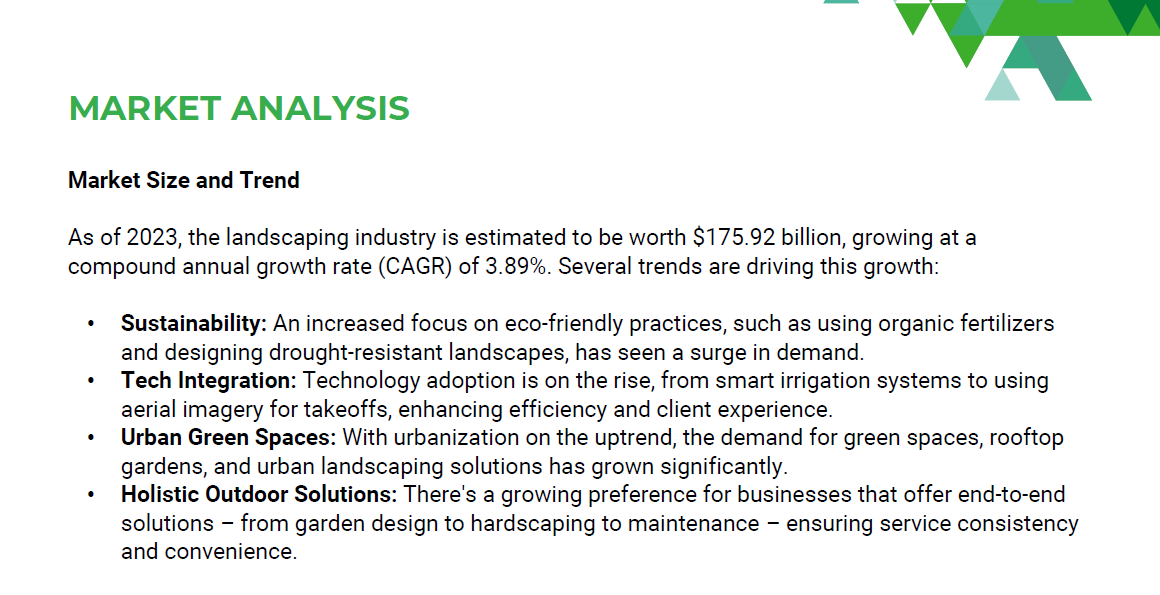
Include a market analysis within your business plan to show potential investors and partners what the landscape industry looks like in your area, such as:
Market size
Growth trends
Opportunities
Identify market gaps, whether certain services are not offered, or areas are not sufficiently served.
Discuss emerging trends and innovations within the landscaping industry. This could encompass:
Eco-friendly practices
Sustainable landscaping
Advancements in technology and equipment
Your awareness of industry trends indicates your readiness to adapt and stay competitive.
In addition, outline your target audience or buyer persona , including demographics and psychographics. If your key target market includes discerning families, this could help determine specific service offerings, such as organic cleaning products and methods.
In the competitor analysis section of your business plan, list the top landscape industry players in your service area and their strengths and weaknesses. Discuss competitive advantages that set the business apart and strategies for outperforming competitors, which may include capitalizing on the weaknesses of your peers.
→ When performing a competitive analysis, due diligence requires consulting market research and industry benchmarks. This guides strategic decision-making .
In addition, detail the marketing and promotional tactics employed by competitors, including their:
Online presence
Social media engagement
Advertising campaigns
Customer acquisition strategies
Explain how your marketing efforts aim to stand out or compete effectively.
You’ve already established your target audience. Now, outline how you plan to reach potential customers and convert them into new customers. List your marketing channels and tactics, like direct mail, email marketing, and social media marketing.
When crafting a marketing strategy , consider each step of the buyer journey and how your company will effectively target customers through those steps, which include:
For your sales strategy, define your approach, such as value-based or consultative selling .
In addition, define your follow-up strategy for unsold estimates–consider what will convert them–and how to utilize customers you’ve serviced to garner reviews and referrals.
Your management plan provides an overview of the company’s business structure and key personnel responsible for executing the business plan. It acts as a roadmap for:
Making staffing decisions
Defining internal processes
Developing leaders
You may start with an organizational chart, which provides an overview of the company hierarchy from the management team on down. Then, go into further detail, listing the roles and responsibilities of each team member.�
A company’s recruitment and retention relies on quality management. Discuss strategies for attracting and retaining talent and your plans for talent development and growing your landscape business . This could include mentorship programs , career pathing , and feedback mechanisms .
The financial plan breaks down the numbers side of your landscaping business, outlining the company’s economic viability and the leadership’s financial acumen.
For businesses seeking funding, outline the capital requirements to start the company and how the money will be used. Include personal income statements for each owner and major stockholder, showing assets and liabilities outside the business and personal net worth.
A financial plan should include financial statements, such as:
12-month profit-and-loss projection
Cash flow statement projection
Projected balance sheet
Break-even calculation
Take into account the average profit margins for a landscaping business . Also, list financial risks and mitigation strategies.
→ Your financial plan is a moving target, as you can’t always predict and plan for changing economic landscapes. Regularly r evisiting and updating this section of your business plan is crucial .
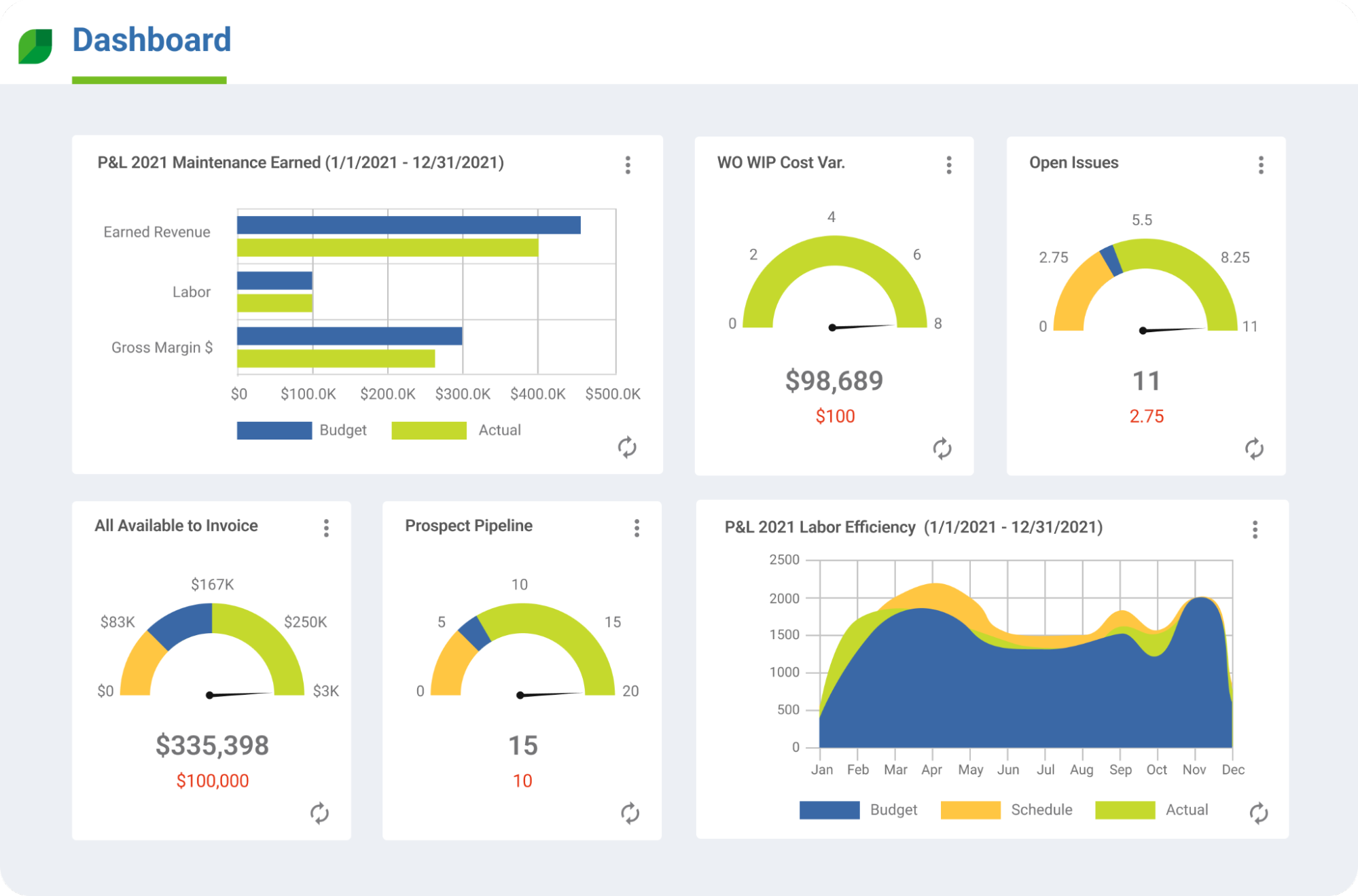
You might use resources to help implement your financial plan, such as landscape business software like Aspire, which provides visibility into every aspect of operations.
With real-time data readily accessible via custom reports and dashboards , and features to accurately and immediately calculate job costs, Aspire helps landscaping businesses make informed decisions to improve:
Productivity
Accountability
A landscape or lawn care business plan helps secure funding, uncover your business differentiators, and guide day-to-day landscape business operations. Check out our sample business plan to get started.
Field service software helps implement the business plan, leading to growth, profitability, and landscape business success .
Aspire ’s end-to-end business management software delivers industry-leading features for:
Job costing
Labor management
Purchasing
For more than a decade, landscape contractors have trusted Aspire’s tools to help them operate profitably and efficiently.
The latest articles from Aspire Software
Practical advice and tools to help you run your field service business.

June 4, 2024 1 min read
Navigating the Snow Business: Emerging Trends and Strategies
Get an in-depth analysis of the industry's trends of snow & ice management, and...
Commercial cleaning

May 25, 2024 1 min read
Unlock Next-Level Efficiency & Growth
Download your whitepaper today to gain a competitive edge with tech adoption strategies.

May 23, 2024 1 min read
Simplifying the switch: Your guide to upgrading operations software

March 29, 2024 5 min read
Cleaning Subcontractor Agreement Template (+Free PDF Download)
Streamline your cleaning business with a comprehensive subcontractor agreement template, ensuring top-quality service and...

March 29, 2024 8 min read
Cleaning Business Plan Template (+Free PDF Download)
Discover the essential elements of a cleaning business plan and leverage our free cleaning...

March 26, 2024 5 min read
Cleaning Inventory Template (+Free PDF Download)
Optimize your inventory management with a free template that allows you to track and...

March 6, 2024 5 min read
Cleaning Estimate Template (+Free PDF Download)
Download our free cleaning estimate template to streamline your estimating process and ensure accurate...

February 28, 2024 8 min read
Landscaping Equipment List: Top 21 Essential Tools (Hand Picked)
Explore our curated list of key landscaping tools and equipment, from hand tools and...

January 17, 2024 5 min read
Cleaning Work Order Template (+Free PDF Download)
Download this free template to automate your cleaning work order process and improve workflow...

December 13, 2023 8 min read
Landscaping Equipment Maintenance Checklist Template (+Free PDF Download)
Keep your landscaping equipment in top condition with our free downloadable landscaping equipment maintenance...

December 13, 2023 5 min read
Cleaning Invoice Template (+Free PDF Download)
Get this free cleaning invoice template and improve monthly cash flow with professional-looking, accurate...

December 11, 2023 5 min read
Landscaping Appointment Reminder Template (+ Free PDF Download)
Nothing is more frustrating than a property owner who doesn’t attend the scheduled appointment.
Subscribe to Aspire news & insights
By submitting the form, you agree to our Terms of Use , Privacy Policy , and that we may contact you, by SMS, at the phone number and email address you provide in this form in accordance with our Terms of Use.
- Crew Control
- PropertyIntel
- Landscaping
- Marketing Pro
- Job Costing
- Accounting & Payroll
- Implementation
- Events & Webinar
- Case Studies
- Comparisons
- Partner Marketplace
- Integrations
©2024 Aspire Software. All rights reserved.
- Sample Business Plans
Landscaping Business Plan

Beautiful and well-maintained lawns are a treat to look at. But with today’s hectic lifestyle, few people have the time and energy required to maintain one.
And with more income at their disposal, people like to outsource this task to professionals who can manage their gardens well and design them in a way that enhances their house’s beauty.
With artistic lawns cropping up at every corner of our cities, the demand for landscaping architects is at its peak. Be it offices, residential spaces, or public areas, every space needs an aesthetically pleasing lawn.
But not everyone has the amount of creativity and precision that goes into maintaining beautiful gardens. And if you have it, then a landscaping business might be the right choice for you.
All you need is a little bit of groundwork and a proper landscaping business plan .
Industry Overview
According to recent statistics, the landscaping industry employs over 1 million people and has grown 4.9 percent since 2020.
So, if you are a creative individual who can think out of the box, a landscaping business can help you reach your maximum potential. The best part about the landscaping business is that it takes minimum entry conditions and minimal costs to set up.
Now, you may wonder, why do so many landscaping businesses owned by highly creative individuals fail? The reason is as simple as it gets; The lack of a proper business plan.
Although creativity is essential to help you stand out, a landscaping business plan is of utmost importance for the sustenance of your business.
Here, we’ll share a few tips to make your setup process smoother.
Say goodbye to boring templates
Build your business plan faster and easier with AI
Plans starting from $7/month

Things to Consider Before Writing a Landscaping Business Plan
Decide what services you want to offer.
Landscaping comes with a lot of sub-niches and additional services. Deciding what you can and should offer as per the needs and requirements of your target audience is essential.
It helps you stay prepared for the service, including getting the right equipment and hiring the right people. Picking your niche is also a great help while formulating business strategies.
Get the required permits
Although the landscaping business does not have strict entry conditions, there are a few licenses and permits that you should have before getting started.
The easiest way of doing this is by checking out all the permits required by your state and area and making a checklist for keeping track of what you have got and what not.
Having all the necessary permits helps you stay on the right side of the law.
Develop a pricing strategy
As you have a service that is mostly based on skill and equipment cost, you’ll have to give your pricing strategy a serious thought before getting started.
It is essential to ensure that your pricing is neither too much for your customers nor too little for your business to make any profit. There are several ways you can set a pricing strategy, depending on your competitor’s pricing, your market position, and the demand for your services.
Know your target audience
Knowing your target audience is crucial to business success. Researching who your target audience is, what are their motivations to avail landscaping services, how they avail such services, what kind of service they prefer (This can also help in deciding your niche and additional services), what prices they are willing to pay, etc.
How Can a Landscaping Business Plan Help You?
A business plan can become a constant guide in your business journey. It’ll aid you while sailing through the roadblocks, prevent you from having chaotic finances, help you in knowing the market and your competitors better, and save you from the trap of having a static business model that becomes irrelevant as the industry changes.
Apart from that, in the landscape business, it would help you in developing your unique style and technique that sets you apart from your peers.
How to Write a Landscaping Business Plan?
As we have discussed the benefits of a business plan , it brings us to our next question.
How do you write one? Moreover, how do you know if you have written a good one?
Don’t worry! There are several quick and cost-effective solutions to your problem.
If you find writing a business plan intimidating, there are several options like business consultants, premade templates, and online business plan software which can help you create a complete and evolving business plan anywhere and at any time.
We have created this sample landscaping business plan for you to get a good idea of what a perfect landscaping business plan should look like and what details you need to include in your stunning business plan.
Landscaping Business Plan Outline
This is the standard landscaping business plan outline which will cover all important sections that you should include in your business plan.
- Mission Statement
- Vision Statement
- 3 Year profit forecast
- Products and Services
- Startup cost
- Market Trends
- Target Market
- Market share
- Sales Strategy
- Marketing strategies
- Personnel Plan
- Average Salary of Employees
- Important Assumptions
- Brake-even Analysis
- Profit Yearly
- Gross Margin Yearly
- Projected Cash Flow
- Projected Balance Sheet
- Business Ratios
Now Let’s Understand How You Should Complete Each Section.
1. Executive Summary
The executive summary is one of the most crucial sections of your business plan, as it is the first and foremost document in it and serves as a pitch to your prospective investors. Hence, this section should sum up your business idea and function with utmost precision.
It should also consist of a mission statement and clearly state your vision for the business. For a landscaping business, it would consist of your growth model, your source of labor and raw material, as well as how your style of design sets you apart from the others.
2. Description of your niche
Next up, you’ll need to define the niche your business functions in. As landscaping consists of several areas like,
- Commercial Landscaping
- Residential Landscaping
- Art-based designs(for public and tourist spaces)
It is necessary to define what kind of services you’ll offer and who would be your primary client base. So, how can you select a niche? We’ll discuss that in the competitive and market analysis section.
3. Competitive and Market Analysis
Before you enter any market, it is the wisest thing to carry out an analysis of the current market situation and the recent trends in the industry. Also, it is a good practice to know what your competitors are doing, because if you are aware of what’s going on, deciding what you should do and what gaps you can fill through your services becomes easier. Hence, this helps you in identifying what your niche would be.
For example, if there is a dearth of good landscape architects for office spaces in your area, you can accordingly modify your skills and marketing strategy to serve the purpose of capturing that market.
4. Website Strategy
In today’s fast-paced environment, most people prefer getting their work done online. Hence, having a website is necessary for your business to be discovered. Thus, including a website strategy in your plan is essential. Also, as a creative business, your website needs to lean on a more artistic side and represent what your style stands for.
5. Management Summary
In this section, you are supposed to include important information about people responsible for a company’s management, the tasks they have been delegated, their roles and responsibilities, etc. As a landscaping business has a large scale of functioning, you need to include this section in your plan.
6. Financial Plan
Writing a financial plan is a necessary step toward creating a well-rounded business plan. A financial plan helps your business in becoming cost-effective and profitable. It also helps you pre-plan and stay afloat in times of recession and instability in the market. Hence, this section is necessary for the sustenance of your business.
Download a sample landscaping business plan
Need help writing your business plan from scratch? Here you go; download our free landscaping business plan pdf to start.
It’s a modern business plan template specifically designed for your landscaping business. Use the example business plan as a guide for writing your own.
The Quickest Way to turn a Business Idea into a Business Plan
Fill-in-the-blanks and automatic financials make it easy.
Landscaping Business Plan Summary
In conclusion, a business plan can turn to conduct your landscaping business a hassle-free activity. Moreover, a well-planned business with clearly defined goals and dynamic strategies has a higher chance of succeeding than one which doesn’t have either of these things.
Besides the above things, in the landscaping business, it is also important to have a thorough knowledge of advanced technology and newly improved techniques to improve the efficiency of your business’s day-to-day activities.
After getting started with Upmetrics , you can copy this sample landscaping business plan template into your business plan and modify the required information and download your landscaping business plan pdf or doc file. It’s the fastest and easiest way to start writing your business plan.
So, are you ready to reach far and wide in the landscape market with your well-written business plan?
Related Posts
Amusement Park Business Plan
Campground Business Plan
400+ Sample Business Plans Template
General Contractor Business Plan
About the Author

Vinay Kevadiya
Vinay Kevadiya is the founder and CEO of Upmetrics, the #1 business planning software. His ultimate goal with Upmetrics is to revolutionize how entrepreneurs create, manage, and execute their business plans. He enjoys sharing his insights on business planning and other relevant topics through his articles and blog posts. Read more
Plan your business in the shortest time possible
No Risk – Cancel at Any Time – 15 Day Money Back Guarantee

Create a great Business Plan with great price.
- 400+ Business plan templates & examples
- AI Assistance & step by step guidance
- 4.8 Star rating on Trustpilot
Streamline your business planning process with Upmetrics .


How To Write a Successful Landscaping Business Plan + Template

Creating a business plan is essential for any business, but it can be especially helpful for landscaping businesses that want to improve their strategy and/or raise funding.
A well-crafted business plan not only outlines the vision for your company, but also documents a step-by-step roadmap of how you are going to accomplish it. In order to create an effective business plan, you must first understand the components that are essential to its success.
This article provides an overview of the key elements that every landscaping business owner should include in their business plan.
Download the Ultimate Landscaping Business Plan Template
What is a landscaping business plan.
A landscaping business plan is a formal written document that describes your company’s business strategy and its feasibility. It documents the reasons you will be successful, your areas of competitive advantage, and it includes information about your team members. Your business plan is a key document that will convince investors and lenders (if needed) that you are positioned to become a successful venture.
Why Write a Landscaping Business Plan?
A landscaping business plan is required for banks and investors. The document is a clear and concise guide of your business idea and the steps you will take to make it profitable.
Entrepreneurs can also use this as a roadmap when starting their new company or venture, especially if they are inexperienced in starting a business.
Writing an Effective Landscaping Business Plan
The following are the key components of a successful landscaping business plan:
Executive Summary
The executive summary of a landscaping business plan is a one to two page overview of your entire business plan. It should summarize the main points, which will be presented in full in the rest of your business plan.
- Start with a one-line description of your landscaping company
- Provide a short summary of the key points in each section of your business plan, which includes information about your company’s management team, industry analysis, competitive analysis, and financial forecast among others.
Company Description
This section should include a brief history of your company. Include a short description of how your company started, and provide a timeline of milestones your company has achieved.
If you are just starting your landscaping business, you may not have a long company history. Instead, you can include information about your professional experience in this industry and how and why you conceived your new venture. If you have worked for a similar company before or have been involved in an entrepreneurial venture before starting your landscaping firm, mention this.
You will also include information about your chosen landscaping business model and how, if applicable, it is different from other companies in your industry.
Industry Analysis
The industry or market analysis is an important component of a landscaping business plan. Conduct thorough market research to determine industry trends and document the size of your market.
Questions to answer include:
- What part of the landscaping industry are you targeting?
- How big is the market?
- What trends are happening in the industry right now (and if applicable, how do these trends support the success of your company)?
You should also include sources for the information you provide, such as published research reports and expert opinions.
Customer Analysis
This section should include a list of your target audience(s) with demographic and psychographic profiles (e.g., age, gender, income level, profession, job titles, interests). You will need to provide a profile of each customer segment separately, including their needs and wants.
For example, landscaping business customers may include residential homebuilders, commercial developers, and residential homeowners.
You can include information about how your customers make the decision to buy from you as well as what keeps them buying from you.
Develop a strategy for targeting those customers who are most likely to buy from you, as well as those that might be influenced to buy your products or landscaping services with the right marketing.
Competitive Analysis
The competitive analysis helps you determine how your product or service will be different from competitors, and what your unique selling proposition (USP) might be that will set you apart in this industry.
For each competitor, list their strengths and weaknesses. Next, determine your areas of competitive differentiation and/or advantage; that is, in what ways are you different from and ideally better than your competitors.
Below are sample competitive advantages your landscaping business may have:
- Established industry relationships
- Comprehensive services
- Wide range of landscaping services
- Customized services
- Use of the latest technology
Marketing Plan
This part of the business plan is where you determine and document your marketing plan. . Your plan should be clearly laid out, including the following 4 Ps.
- Product/Service : Detail your product/service offerings here. Document their features and benefits.
- Price : Document your pricing strategy here. In addition to stating the prices for your products/services, mention how your pricing compares to your competition.
- Place : Where will your customers find you? What channels of distribution (e.g., partnerships) will you use to reach them if applicable?
- Promotion : How will you reach your target customers? For example, you may use social media, write blog posts, create an email marketing campaign, use pay-per-click advertising, or launch a direct mail campaign. Or you may promote your landscaping business via a mix of these channels.
Operations Plan
This part of your landscaping business plan should include the following information:
- How will you deliver your product/service to customers? For example, will you do it in person or over the phone only?
- What infrastructure, equipment, and resources are needed to operate successfully? How can you meet those requirements within budget constraints?
The operations plan is where you also need to include your company’s business policies. You will want to establish policies related to everything from customer service to pricing, to the overall brand image you are trying to present.
Finally, and most importantly, in your Operations Plan, you will lay out the milestones your company hopes to achieve within the next five years. Create a chart that shows the key milestone(s) you hope to achieve each quarter for the next four quarters, and then each year for the following four years. Examples of milestones for a landscaping business include reaching $X in sales. Other examples include adding new services, expanding to a new location, or hiring new employees.
Management Team
List your team members here including their names and titles, as well as their expertise and experience relevant to your specific landscaping industry. Include brief biography sketches for each team member.
Particularly if you are seeking funding, the goal of this section is to convince investors and lenders that your team has the expertise and experience to execute on your plan. If you are missing key team members, document the roles and responsibilities you plan to hire for in the future.
Financial Plan
Here you will include a summary of your complete and detailed financial plan (your full financial projections go in the Appendix).
This includes the following three financial statements:
Income Statement
Your income statement should include:
- Revenue : how much revenue you generate.
- Cost of Goods Sold : These are your direct costs associated with generating revenue. This includes labor costs, as well as the cost of any equipment and supplies used to deliver the product/service offering.
- Net Income (or loss) : Once expenses and revenue are totaled and deducted from each other, this is the net income or loss.
Sample Income Statement for a Startup Landscaping Company
| Revenues | $ 336,090 | $ 450,940 | $ 605,000 | $ 811,730 | $ 1,089,100 |
| $ 336,090 | $ 450,940 | $ 605,000 | $ 811,730 | $ 1,089,100 | |
| Direct Cost | |||||
| Direct Costs | $ 67,210 | $ 90,190 | $ 121,000 | $ 162,340 | $ 217,820 |
| $ 67,210 | $ 90,190 | $ 121,000 | $ 162,340 | $ 217,820 | |
| $ 268,880 | $ 360,750 | $ 484,000 | $ 649,390 | $ 871,280 | |
| Salaries | $ 96,000 | $ 99,840 | $ 105,371 | $ 110,639 | $ 116,171 |
| Marketing Expenses | $ 61,200 | $ 64,400 | $ 67,600 | $ 71,000 | $ 74,600 |
| Rent/Utility Expenses | $ 36,400 | $ 37,500 | $ 38,700 | $ 39,800 | $ 41,000 |
| Other Expenses | $ 9,200 | $ 9,200 | $ 9,200 | $ 9,400 | $ 9,500 |
| $ 202,800 | $ 210,940 | $ 220,871 | $ 230,839 | $ 241,271 | |
| EBITDA | $ 66,080 | $ 149,810 | $ 263,129 | $ 418,551 | $ 630,009 |
| Depreciation | $ 5,200 | $ 5,200 | $ 5,200 | $ 5,200 | $ 4,200 |
| EBIT | $ 60,880 | $ 144,610 | $ 257,929 | $ 413,351 | $ 625,809 |
| Interest Expense | $ 7,600 | $ 7,600 | $ 7,600 | $ 7,600 | $ 7,600 |
| $ 53,280 | $ 137,010 | $ 250,329 | $ 405,751 | $ 618,209 | |
| Taxable Income | $ 53,280 | $ 137,010 | $ 250,329 | $ 405,751 | $ 618,209 |
| Income Tax Expense | $ 18,700 | $ 47,900 | $ 87,600 | $ 142,000 | $ 216,400 |
| $ 34,580 | $ 89,110 | $ 162,729 | $ 263,751 | $ 401,809 | |
| 10% | 20% | 27% | 32% | 37% | |
Balance Sheet
Include a balance sheet that shows your assets, liabilities, and equity. Your balance sheet should include:
- Assets : All of the things you own (including cash).
- Liabilities : This is what you owe against your company’s assets, such as accounts payable or loans.
- Equity : The worth of your business after all liabilities and assets are totaled and deducted from each other.
Sample Balance Sheet for a Startup Landscaping Company
| Cash | $ 105,342 | $ 188,252 | $ 340,881 | $ 597,431 | $ 869,278 |
| Other Current Assets | $ 41,600 | $ 55,800 | $ 74,800 | $ 90,200 | $ 121,000 |
| Total Current Assets | $ 146,942 | $ 244,052 | $ 415,681 | $ 687,631 | $ 990,278 |
| Fixed Assets | $ 25,000 | $ 25,000 | $ 25,000 | $ 25,000 | $ 25,000 |
| Accum Depreciation | $ 5,200 | $ 10,400 | $ 15,600 | $ 20,800 | $ 25,000 |
| Net fixed assets | $ 19,800 | $ 14,600 | $ 9,400 | $ 4,200 | $ 0 |
| $ 166,742 | $ 258,652 | $ 425,081 | $ 691,831 | $ 990,278 | |
| Current Liabilities | $ 23,300 | $ 26,100 | $ 29,800 | $ 32,800 | $ 38,300 |
| Debt outstanding | $ 108,862 | $ 108,862 | $ 108,862 | $ 108,862 | $ 0 |
| $ 132,162 | $ 134,962 | $ 138,662 | $ 141,662 | $ 38,300 | |
| Share Capital | $ 0 | $ 0 | $ 0 | $ 0 | $ 0 |
| Retained earnings | $ 34,580 | $ 123,690 | $ 286,419 | $ 550,170 | $ 951,978 |
| $ 34,580 | $ 123,690 | $ 286,419 | $ 550,170 | $ 951,978 | |
| $ 166,742 | $ 258,652 | $ 425,081 | $ 691,831 | $ 990,278 | |
Cash Flow Statement
Include a cash flow statement showing how much cash comes in, how much cash goes out and a net cash flow for each year. The cash flow statement should include:
- Cash Flow From Operations
- Cash Flow From Investments
- Cash Flow From Financing
Below is a sample of a projected cash flow statement for a startup landscaping business.
Sample Cash Flow Statement for a Startup Landscaping Company
| Net Income (Loss) | $ 34,580 | $ 89,110 | $ 162,729 | $ 263,751 | $ 401,809 |
| Change in Working Capital | $ (18,300) | $ (11,400) | $ (15,300) | $ (12,400) | $ (25,300) |
| Plus Depreciation | $ 5,200 | $ 5,200 | $ 5,200 | $ 5,200 | $ 4,200 |
| Net Cash Flow from Operations | $ 21,480 | $ 82,910 | $ 152,629 | $ 256,551 | $ 380,709 |
| Fixed Assets | $ (25,000) | $ 0 | $ 0 | $ 0 | $ 0 |
| Net Cash Flow from Investments | $ (25,000) | $ 0 | $ 0 | $ 0 | $ 0 |
| Cash from Equity | $ 0 | $ 0 | $ 0 | $ 0 | $ 0 |
| Cash from Debt financing | $ 108,862 | $ 0 | $ 0 | $ 0 | $ (108,862) |
| Net Cash Flow from Financing | $ 108,862 | $ 0 | $ 0 | $ 0 | $ (108,862) |
| Net Cash Flow | $ 105,342 | $ 82,910 | $ 152,629 | $ 256,551 | $ 271,847 |
| Cash at Beginning of Period | $ 0 | $ 105,342 | $ 188,252 | $ 340,881 | $ 597,431 |
| Cash at End of Period | $ 105,342 | $ 188,252 | $ 340,881 | $ 597,431 | $ 869,278 |
You will also want to include an appendix section which will include:
- Your complete financial projections
- A complete list of your company’s business policies and procedures related to the rest of the business plan (marketing, operations, etc.)
- Any other documentation which supports what you included in the body of your business plan.
Writing a good business plan gives you the advantage of being fully prepared to launch and/or grow your landscaping company. It not only outlines your business vision but also provides a step-by-step process of how you are going to accomplish it.
This guide has provided you with a basic outline of what should be included in your landscaping business plan. Use this as a starting point and tailor it to fit the specific needs of your company.
Finish Your Landscaping Business Plan in 1 Day!
Other helpful articles.
How To Develop Your Landscaping Mission Statement + Examples
Landscaping Business Plan: How to Write It and What It Is

- Last Updated: October 27, 2022
A landscaping business plan is a document that outlines the goals, strategies, and financial projections for a landscaping company. It is important to have a business plan in place before starting a landscaping business, as it will help you to map out the potential growth and financial stability of the business.
Starting a landscaping company can be more difficult than it looks. If you have a plan, it can make the journey much easier. This blog will be your guide to start a landscaping business and write your landscaping business plan .
Table of Content
- How to Write an Effective Landscaping Business Plan?
Why Do You Need a Business Plan?
Landscaping business plan template, how to write an effective landscaping business plan.
A business plan is an essential tool for any business, and a landscaping business is no exception. Your plan should outline your business goals, strategies, and financial projections. It should be clear, concise, and easy to understand.
For your landscaping business to succeed, it’s important to put together a comprehensive lawn maintenance business plan. This should include a market analysis, an overview of the landscaping industry, your business goals and objectives, and a detailed plan for how you intend to achieve success.
Finally, your business planning should include a detailed action plan for how you intend to achieve your goals. This should include information on your marketing and advertising strategy, your sales and growth strategy, your competitor analysis, and your financial goals.
By taking the time to put together a comprehensive lawn maintenance business plan, you’ll be setting yourself up for success in the landscaping industry. There are a few key things to keep in mind when writing your landscape company business plan :
1. Define your business goals
When you’re putting together your landscaping business plan, one of the most important things to do is to define your business goals.
- What do you want to achieve with your landscape businesses?
- What are your long-term and short-term goals? Be specific and realistic in your goals.
- Are you hoping to grow your company to a certain size?
- Are you hoping to serve a certain number of clients?
- Are you hoping to achieve a certain level of profitability?
No matter what your specific goals may be, it’s important to write them down and make them a part of your business plan. Having clear and defined goals will help you to create a roadmap for your business, and it will also help you to measure your progress over time.
Also, make a company description that suits the market trends, covers all necessary information about your landscape business, and the lawn services you provide.
2. Outline your strategy
How are you going to achieve your business goals? What are your marketing plan and sales strategies? What are your operational plans?
This will give potential investors an idea of what you hope to achieve with your business, and who your target customers are. You will need to include a detailed business model, outlining how you plan on generating revenue and making a profit.
- A mission statement is a brief, clear statement of an organization’s purpose, goals, and priorities.
- A personal savings plan is a way to set aside money each month to reach your long-term savings goals. To be thorough, you need to have a complete understanding of all the details involved in your project. This will include things like pricing strategies, marketing initiatives, and operational costs. Using free project management templates can help you stay organized and ensure no key information gets overlooked.
- Your market analysis should take into account the current state of the economy and the landscaping industry, as well as your target market. Who will your new customers be? What are their needs and wants? What are the trends in the landscaping industry? This information will help you to determine your prices and position you for your business success.
3. Make financial projections
What are your revenue and expense projections? What are your capital requirements? Make sure your financial projections are realistic and achievable.
You will need to put together a solid financial plan, which will include your start-up costs, financial projections, and a strategy for securing funding. This is arguably the most important part of your business plan, as it will show potential investors whether or not your business is viable.
Many landscaping companies, to ensure they get repeat customers, keep their gross margin less for old customers compared to new customers. This method helps them retain old customers and maintain cash flow.
4. Write a clear and concise business plan
Your business plan should be easy to understand and free of jargon. Make sure to include all the key components outlined above. A company summary is a brief landscaping business description , its history, products and services, and your current situation which makes it easy to apply for bank loans.
As you sit down to write your landscaping business plan, keep in mind that its purpose is to communicate your vision and guide your business’s growth. With that in mind, here are a few tips to help you write a clear and concise business plan:
- Keep it short and sweet. No one wants to read a 100-page business plan. Keep your plan concise and to the point.
- Paraphrase sections of your business plan that sound less impactful. A paraphraser tool can help you avoid repetition in your write-up and allows you to express your ideas in a new way while maintaining the original meaning.
- Communicate your vision. Your plan of action should articulate your vision for your business. What are your long-term goals? What sets your business apart from the competition?
- Be realistic. Don’t over-promise and under-deliver. Be realistic in your projections and goals.
- Do your research. Make sure you have a good understanding of your market and your competition.
- Get help. If you’re not sure where to start, there are plenty of resources available to help you write your business plan.
By following these tips, you can be sure that your landscaping business plan is well-rounded and will give you the best chance of success.
If you’re thinking about starting a landscaping business, you need a solid business plan. This plan should include a summary of your business, your marketing plan, and a financial forecast.
Your business plan should be thorough and cover all aspects of your business, from your market analysis to your pricing strategy. Your marketing plan should detail how you plan to reach your target market, and what methods you’ll use to promote your business. And finally, your financial forecast should outline your expected expenses and income.
With a proper business plan that includes your landscaping business plan summary, you’ll be on your way to starting a successful landscaping business.
There are many reasons why you might need a business plan.
- Perhaps you are looking to start a new business and need to lay out your goals and strategies.
- Or maybe you are already running a business and need to take it to the next level.
Whatever the case may be, a business plan can be a helpful tool.
- A business plan can help you to articulate your business idea, set realistic goals, and map out a path to achieving them.
- It can also force you to think about potential risks and how to mitigate them.
- And if you are seeking financing from investors, a business plan can be essential in convincing them to invest in your business.
So, if you are thinking about starting a business, or taking your existing business to the next level, consider to write a business plan. Having a well-executed business plan is key to success.
Make sure you do your research and put together a plan that takes into account your start-up costs, marketing strategy, and financial goals. By taking the time to plan, you’ll put your business on the path to success.
TRY LANDSCAPING BUSINESS SOFTWARE FOR FREE
Schedule and dispatch jobs, Create invoices, Get paid, Generate service reports with our All-in-one Landscape Management Software.
A landscaping business plan template can be a great resource for those looking to start their own business.
- This type of template can help you to create a well-organized and professional-looking business plan. It can also provide you with a framework to follow as you develop your business plan.
- Additionally, a landscaping business plan template can help you to identify and assess the potential risks and opportunities associated with starting a landscaping company. Creating a business plan template for landscaping businesses can be a daunting task, but it doesn’t have to be.
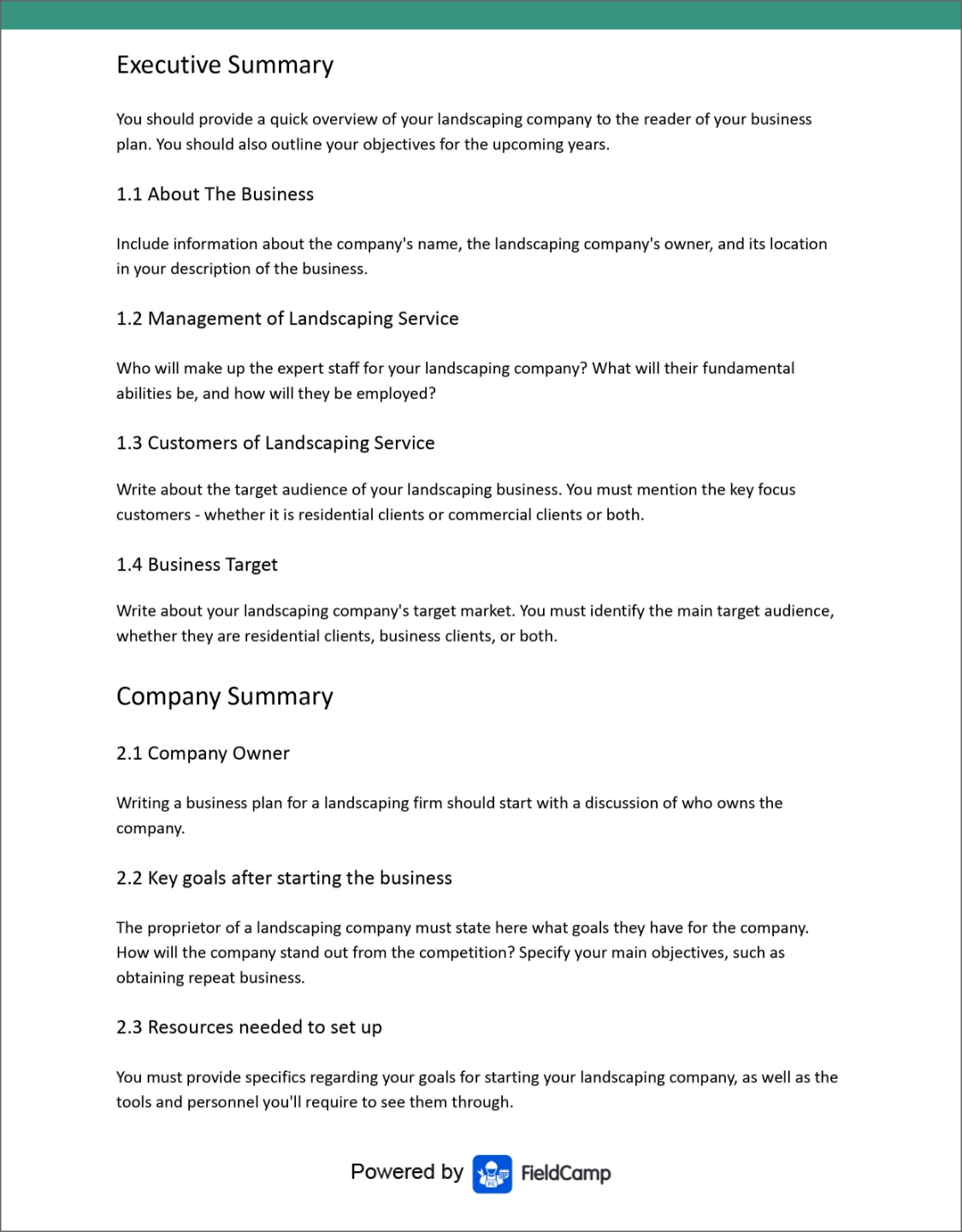
Free PDF Template of Landscaping Business Plan
When it comes to starting a successful lawn care business, having a well-thought-out business plan is essential. But what can you do to give your lawn care business a competitive advantage?
- One way to stand out from the competition is to offer landscaping services that they don’t. For example, if you’re starting a lawn care business in a suburban area, you could focus on offering organic lawn care services.
- Another way to set your business apart is to focus on customer service. This could mean offering a money-back satisfaction guarantee or providing free consultations to potential clients.
- In terms of detail, it is important to include enough information to give a clear overview of your landscaping business. However, you don’t want to include so much detail that the plan becomes cumbersome. A good rule of thumb is to keep the business plan to around 30 pages.
- As for frequency, it is generally a good idea to update your business plan on an annual basis. This ensures that your plan stays relevant and reflects any changes in your business. However, you may need to update it more frequently if your business is growing rapidly.
We hope our blog post on the landscaping business plan provided some guidance on the subject. You will get complete help in writing a business plan for your business. Once you start your landscaping business, all you need is a software solution to automate your business and its business operations.
FieldCamp is the best landscape business software for automating routine landscaping operations and is an essential component for the long-term success of the lawn maintenance business. The software helps businesses streamline all the operations, including job scheduling, invoicing, payments, and reporting. Know how this software solution helps your landscaping business streamline operations by starting your 7-day FREE trial.

Gaurang Bhatt
Sign up for weekly updates from Fieldcamp.
Related Blog
9 Best Window Washing Tools For Your Service Business
7 Crucial Reasons Why Service Company is Not Growing [Tips + How to Fix It]
How to Start a Chimney Sweep Business? 7 Easy Steps to Guide You
What are the Benefits of Having an App for Handyman Services?
10 Best Bankable Painting Business Ideas You Must Check Out Now
15 Customer Experience Best Practices & Tips
Schedule and Dispatch Jobs with FieldCamp
Automate Your Field Service Business Operations with Easy-to-Use Field Service Management Software.
Automate 90% of Daily Operations
Save up to 95% of Time on Scheduling and Reports
Track Technicians and Crews
No credit card details required
https://www.fieldcamp.com/blog/landscaping-business-plan/
ZenBusinessPlans
Home » Sample Business Plans » Real Estate
How to Write a Landscaping Business Plan [Sample Template]
Are you about starting a landscaping company? If YES, here’s a complete sample landscaping business plan template & feasibility report to help you get started. Okay, so we have considered all the requirements for starting a landscaping business. We also took it further by analyzing and drafting a sample landscaping marketing plan template backed up by actionable guerrilla marketing ideas for landscaping businesses. So let’s proceed to the business planning section.
A Sample Landscaping Business Plan Template
1. industry overview.
It is not enough to own a property that is well designed and built; the hallmark of any property is the beauty of the lawns and gardens. Landscapers are in the business of giving total esthetic effect in and around our neighborhoods. It is not enough to plant flowers or have a lawn in your compound and just watch them grow; you need to hire a professional landscaping company to help you bring out the beauty in your environment.
Landscape architecture is all about the art, planning, designing, management, preservation and rehabilitation of the land and the design of a large man – made concepts; it beautifies our environment. Landscaping business just like Lawn care business is not one of those businesses that you can start and make big money from without truly working pretty hard and smart.
Any entrepreneur who intends to start his or her own landscaping business with the aim of making huge profits from it must be very creative and ready to go the extra mile to convince clients that he or she can deliver an excellent job. Furthermore, you have got to prove beyond every reasonable doubt that you are competent.
In a publication released by a Professional Land-care Network (PLANET), an international association serving landscaping professionals, lawn care professionals, exterior maintenance contractors, installation/design/building professionals, and interior scapers, there are approximately 12,000 landscapers in the united states of America.
This statistics covers independent operators, franchises and large corporate chains. They also stated that the number of professional landscapers could actually be considerably higher because there are so many people doing landscape maintenance on part – time and on a pay as you go basis.
Lastly, according to the Occupational Outlook Handbook, published in 2006-2007 (U.S. Department of Labor), is that almost 1 out of every 4 landscaping, grounds – keeping, nursery, greenhouse and lawn service workers is self-employed and provides maintenance services directly to customers on a contract basis. Of these, about 1 out of every 6 works part time.
Although, landscaping business might not be amongst the money spinning businesses in the US, but they have a very large market that is readily available for them if they can convince property owners to patronize their services.
As a matter of fact, statistics has it that the United States green industry (landscape and lawn maintenance, landscape contractors, landscape architects, irrigation contractors, and lawn and landscape product suppliers) generates roughly $67 billion to $69 billion annually. PLANET estimates that the landscaping services sector alone generates about 704,000 jobs and $35.6 million in value-added services annually in the US; it is indeed a growing industry.
Landscaping business also falls in the category of seasonal businesses. The industry experiences downtime during the winter period and in most states in the US. In general, the demand for landscaping services is usually at its peak in the spring and generally between April and October. Which is why landscaping companies are always everywhere sourcing for business deals within this period of the year.
If you are familiar with the landscaping industry, you will notice that most landscaping companies do not restrict their services to only landscape architecture et al; they ensure that they add additional services such as lawn care services, snow plowing services (during winter season), fumigation services and any other similar services just to ensure that they maintain steady in – flow of income during peak and off peak periods.
As such; any entrepreneur who wants to start a landscaping business in the US should be aware that the landscaping and lawn care industry is a closely regulated industry that requires practitioners to earn certifications that permit them to handle hazardous compounds; most especially when they also offer fumigation services.
2. Executive Summary
Glover and Greenhouse Landscape Company is a licensed landscape architecture company that will be based in Miami Beach, Florida –United States of America and will have active presence in other cities such as; Greenacres City, Miami, Jacksonville, Clearwater, Tampa, Fort Lauderdale, North Miami, West Palm Beach, Palm Harbor, Deltona, Orlando, Palm Bay and Panama City et al.
We chose to operate in these cities because we know that our services will be in high demand due to the geographical nature of Florida. Glover and Greenhouse Landscape Company is in the business of beautifying in our environment by offering professional landscape architecture services. We know that the beauty of a city or property is not complete if the gardens or lawns are not properly designed and managed.
We know the importance of networking with the right set of people, which is why we have form partnership with stake holders (landlord associations, property managers and relevant government agencies) in Florida.
Glover and Greenhouse Landscape Company is specialized in handling golf courses, beach houses, major roads and streets as well as residential buildings and public facilities et al. As a matter of fact, when it comes to giving golf course the professional outlook it deserves, we are on top of the game.
We have some of the finest landscapers, who are gifted and also have gone ahead to acquire the relevant trainings that will make them create esthetic effect in the environment that will be second to none.
Glover and Greenhouse Landscape Company is fully aware of the seasonal nature of the business which is why we have made provision to engage in complimentary services during off peak period. We will engage in snow plowing during winter, sale of flowers, tree cutting, fumigation and other related services.
We will also provide consultancy services to homeowners, property managers and the government when it comes to creating the esthetic effect that will bring out the beauty in our environment.
Glover and Greenhouse Landscape Company is a private registered company landscape company that is owned by Glover Carrington and family. The company will be fully and single handedly financed by the owner – Glover Carrington. The business will be managed by his son Gordon Carrington; he is a member of the American Society of Landscape Architects (ASLA).
Mr. Gordon Carrington (Master of Landscape Architecture – MLA) is a core professional who has experience in sensitivity to landscape quality, ability to analyze problems in terms of design and physical forms, understands the arts and humanistic approach to design and he has skills in all aspects of professional practice including management and professional ethics. He has well over 7 years of experience in the industry.
3. Our Products and Services
Glover and Greenhouse Landscape Company is in the business of bring out the beauty in our environment and our services will be carried out by highly trained professionals who know what it takes to give our highly esteemed customers value for their money.These are the services that Glover and Greenhouse Landscape Company will be offering;
- Landscape architecture services
- Landscape care/maintenance services
- Trimming Landscaping
- Landscape design/contracting services
- Lawn mowing/maintenance
- Sod installation/hydro – seeding
- Weeding or fertilizer and/or pest control application
- Weekly lawn cut
- Weeding Beds
- Sale of flowers
- Spring Cleanup
- Fall Cleanup
- Chemical Treatment
- Snow Plowing
- Consultancy and Advisory Services
4. Our Mission and Vision Statement
- Our Vision is to become the number one choice of homeowners, property managers and government agencies when it comes to landscaping services in Florida, U.S.
- Glover and Greenhouse Landscaping Company is a business positioned to be the become the leaders when it comes to bringing out the beauty (esthetics) in our environment by offering top notch landscaping architectural services and other related services in Miami Beach and other cities in Florida, U.S.
Our Business Structure
Glover and Greenhouse Landscaping Company will be headquartered in Miami Beach, but will operate in other cities in Florida which is why we designed our business structure to support the nature of our operations. We want to create a team of dedicated workforce that will help the organization achieve its aim of becoming the number one landscape company in the whole of Florida.
Because we don’t have the required finance to manage the numbers of workforce that we would need, we have made provisions to hire some freelance landscapers to help us handle some contracts when the need arises. Here is the business structure of Glover and Greenhouse Landscape Company;
- Chief Operating Officer (Owner)
- Sales and Marketing Executive
Landscape Architect / Landscapist
- Field Staff
- Front Desk Officer
5. Job Roles and Responsibilities
Chief Operating Officer:
- Responsible for providing direction for the business
- Creates, communicates, and implements the organization’s vision, mission, and overall direction – i.e. leading the development and implementation of the overall organization’s strategy.
- Responsible for the day to day running of the business
- Responsible for handling high profile clients and deals
- Responsible for fixing prices and signing business deals
- Responsible for signing checks and documents on behalf of the company
- Evaluates the success of the organization at regular interval
- Responsible for the planning, management and coordinating all projects on behalf of the company
- Supervises projects
- Ensures compliance during project executions
- Provides advice on the management of projects
- Responsible for carrying out risk assessment
- Uses IT systems and software to keep track of people and progress of ongoing projects
- Responsible for overseeing the accounting, costing and billing of every project
- Represents the organization’s interest at various stakeholders meetings
- Ensures that project desired result is achieved, the most efficient resources are utilized and different interests involved are satisfied. Responsible for preparing financial reports, budgets, and financial statements for the organization
- Responsible for overseeing the smooth running of HR and administrative tasks for the organization
- Handles all financial transactions for the company
- Defines job positions for recruitment and managing interviewing process
- Carries out staff induction for new team members
- Responsible for training, evaluation and assessment of employees
- Oversees the smooth running of the daily office activities.
Sales and Marketing Officer
- Identifies, prioritizes, and reaches out to new partners, and business opportunities et al
- Develops, executes and evaluates new plans for expanding increase sales
- Documents all customer contact and information.
- Represents the company in strategic meetings
- Helps increase sales and growth for the company
- Lists the property for rent / lease to the public
- Markets space; finds tenants; participates in lease negotiations.
- Provides property owners with a real property condition disclosure (if required by law) and other necessary forms.
- Prepares necessary papers describing the property for advertising, pamphlets, open houses, etc.
- Holds an open house to show the property.
- Serves as a contact available to answer any questions about the property and schedule showing appointments.
- Responsible for planning and designing of places such as residential development area, parks, campuses, cemeteries, resorts, commercial centers, water fronts and corporate and institutional centers.
- Responsible for designing and implementing projects that respect both the needs of people and our environment
- Offers training and consultancy services
- Responsible for analyzing problems in terms of design and physical form
- Responsible for translating designs into a built work
- Responsible from training of field workers and freelancers
Field Workers
- Responsible for Lawn mowing/maintenance
- Handles Sod installation/hydro – seeding
- Handles Landscape care/maintenance services
- Carries out task in line with the stated job description
- Handles snow plowing
- Handles tree cutting
- Assists in transport working tools and equipment from the office (store) to site and back to the office
- Handles any other duties as assigned my the line manager
Front Desk / Customer’s Service Officer
- Receives Visitors / clients on behalf of the organization
- Receives parcels / documents for the company
- Handles enquiries via e-mail and phone calls for the organization
6. SWOT Analysis
Glover and Greenhouse Landscape Company is in business for the purpose of making profits and building long lasting relationship with its clients and we know that in order for us to achieve these, we must be able to leverage on our strengths and take hold of all the opportunities that we come across.
We are aware that if effective strategies are not put in place, the weakness of a company and the threats that the business will be exposed to can strangulate the business which is why we have decided to take out time to conduct a SWOT analysis for Glover and Greenhouse Landscape Company.
As a company, we look forward to maximizing our strength and opportunities and also to develop strategies that will help us effectively handle our weaknesses and threats. Here is a summary from the result of the SWOT analysis that was conducted on behalf of Glover and Greenhouse Landscape Company;
Our strength as a landscape company is the fact that we have healthy relationships with key stakeholders in Florida. We have some of the latest equipment that will help us deliver neat and excellent jobs. Our management team and workforce are highly trained and qualified to deliver excellent jobs within record time. We are well positioned and we have active presence in major cities in Florida.
Our weakness could be that we are a new landscaping company in Miami Beach, Florida and it will require consistency for us to gain the confidence of our prospective clients (homeowners, property managers and even the government).
- Opportunities:
The opportunities that are available to us cannot be quantified; we know that there are loads of homeowners, property managers and government establishment that will require our services in Miami Beach and other cities in Florida.
Some of the threats that we are likely going to face as a landscaping company are global economic downturn that can impact negatively on household spending, bad weather cum natural disasters and the arrival of a competitor ( a company that offer same service as we do ) within same location. There is hardly anything we could do as regards these threats other than to be optimistic that things will continue to work for our good.
7. MARKET ANALYSIS
- Market Trends
It is a common trend in landscaping and lawn care industry to see loads of landscapers struggle to meet ends meet. This is so because a larger percentage of people who are supposed to patronize their services are reluctant when it comes to paying the true worth of the services rendered.
It is also a common trend to see landscape companies engage in other complimentary services to makes meet. The fact that there are off peak periods in the business makes it of necessity for landscape companies to look for other sources of income in order to maintain steady flow of income throughout the year.
If you are conversant with the landscape industry, you will realize that one of their major challenges is the challenge of accurately pricing services It takes a landscape company that has been in the business for a while to effectively charge clients in such a way that they will have enough resources to carry out the project, pay for labor and still make enough profits. It is important for any landscape company to first inspect the area they are to carry out their job so that they will be able to properly submit a quotation that will be favorable to both parties.
Usually, most landscaping companies ensure that they send their quotations to prospective clients only when they have been able to do their calculations based on per square foot of the property. Over and above, the creativity of the landscape architect will go a long way to determine the amount that can be charged and the inflow of business.
8. Our Target Market
Glover and Greenhouse Landscape Company was deliberately located in Miami Beach simply because we have a wide range of people and businesses that can hire our services; the geographical nature of Miami Beach is highly suitable for the kind of services we render. Our target market as a landscape company is not just restricted to only homeowners and property managers but also government establishment.
We are quite aware that the state government is one of the biggest clients in the industry, which is why we have structured our business to meet the expectations and requirements of the government when it comes to bidding for government contracts. This is the group of people that we will market our landscape business to;
- Facility managers for botanical gardens, historic buildings, municipalities and other government entities, universities, cemeteries and other public places with green spaces
- Homeowners who plan to put their home on the market and want to improve its curb appeal with fresh or updated landscaping
- Builders of both residential and commercial properties who don’t already have their own landscaper or staff
- New homeowners who wish to update the existing landscape of their property
- Homeowners who are frequently out of town on business
- Retirees who don’t care to do their own maintenance any longer
- “Snowbirds” with winter homes in warmer climates
- Golf course managers who may need help with maintenance
- Rental property or condominium association managers who are personnel-impaired
- Homeowners who don’t have the vision, skill or tools to design their own landscaping
- Managers of public facilities
- Government establishment
Our Competitive Advantage
Glover and Greenhouse Landscape Company is fully aware that there is competition in the industry, which is why we decided to carry out thorough research and draft a killer landscaping marketing plan; so as to know how to take advantage of the available market in the cities where we want to operate.
We have done our homework and we have been able to highlight some factors that will give us competitive advantage in the marketplace; some of the factors are competence, trust, honesty, good network and excellent relationship management. One of the positive that we have as a company is the fact that we have some of the best hands in the industry under our payroll; our manager has a robust experience in the industry.
Another competitive advantage that we are bringing to the industry is the fact that we have designed our business in such a way that we can comfortably work with both the highly placed clients and the lowly placed clients; our prices are designed to fit into the budget of the lower class, the middle class and the upper class.
We are quite aware of the importance of taking proper care of our workforce which is why we have created welfare packages that will make all our employers willing to stay longer with us and also to always put in their best when carrying out their jobs.
9. SALES AND MARKETING STRATEGY
- Sources of Income
Glover and Greenhouse Landscape Company will ensure that we do not only generate income from our core service delivery but also from complementary services that we will render. Below are the sources we intend exploring to generate income for Posh Lawn Care and Landscape Company;
- Tree Cutting
10. Sales Forecast
From the survey conducted, we were are able to discover that the average landscaping business owner rakes in about $5,000 to $ 50,000 in their first year of active business, and a steady increase of $160,000 to $250,000 from subsequent year as long as they are consistent in what they do and have been able to create additional sources of income.
Glover and Greenhouse Landscape Company have perfected her sales and marketing strategies and we are set to deliver excellence services and designs. We know that if we structure our business properly and we have highly trained and motivated employees, we are likely going to meet or even surpass our set target of generating enough income / profits from our first three months of operations.
With the help of experts, we have been able to critically examine the landscape industry with more emphasis on Miami Beach, Florida and we have analyzed our chances in the industry and we have been able to come up with the following sales forecast. The sales projection is based on information gathered on the field and some workable assumptions as well.
Below are the projections that we were able to come up with for the first three years of operations;
- First Year-: $150,000
- Second Year-: $250,000
- Third Year-: $500,000
N.B : This projection is done based on what is obtainable in the industry and with the assumption that there won’t be any major economic meltdown and natural disasters within the period stated above.
- Marketing Strategy and Sales Strategy
Glover and Greenhouse Landscape Company will do all it can to ensure that we become the preferred choice as far as landscaping services is concerned in Florida. We know the effectiveness of properly positioning a business which is why we have chosen a corner piece location in a busy road in Miami Beach to locate our business.
We will ensure that we leverage on all available networks to source for business deals. In view of that, we will continue to find local real estate clubs and connect with them and also we will locate gathering where we can find homeowners within the locations where we intend operating and then connect with them.
We will ensure that we bid at the appropriate time whenever there is the opportunity to handle government contracts both at the community and state level. We will also enter business partnership with local contractors and property managers since they also interface with property owners regularly; through them we can secure business deals.
Over and above, we have perfected strategies to network with people who are likely to refer business our way. In summary, Glover and Greenhouse Landscape Company will adopt the following strategies in sourcing for clients for our business;
- Introduce our business by sending introductory letters alongside our brochure to stake holders in the real estate industry, government institution and also property owners.
- Promptness in bidding for contracts
- Advertise our business in real estate / properties magazines and websites
- List our business on yellow pages ads
- Attend related real estate expos, seminars, and business fairs et al
- Create different packages for different category of clients in order to work with their budgets and still deliver quality job for them.
- Leverage on the internet to promote our business
- Direct marketing
- Word of mouth marketing (referrals)
11. Publicity and Advertising Strategy
We are quite aware that any business that wants to grow beyond the corner of the street they are operating from must be ready and willing to utilize every available means (conventional and non – conventional means) to advertise and promote the business.
We intend growing our business which is why we have perfected plans to build our brand via every available means. Below are the platforms Glover and Greenhouse Landscape Company intend to leverage on to promote and advertise her business;
- Encourage our loyal customers to help us use Word of Mouth mode of advertisement (referrals)
- Advertise our landscaping business in relevant magazines (real estate magazines), local newspaper, local TV stations and local radio station
- Promote our landscaping business online via our official website
- List our landscaping business on local directories (yellow pages ads)
- Leverage on the internet and social media platforms like; Instagram, Google+, LinkedIn, Badoo, Facebook , twitter, et al to promote our landscaping business
- Install our Bill Boards on strategic locations around Miami Beach and other key cities in Florida.
- Direct coupon mailing approach to introduce our landscaping business to residence and property managers
- Engage in road show from time to time to create awareness of our landscaping business.
- Distribute our fliers and handbills in target areas in Miami Beach, and other key cities in Florida
- Maximize our company’s website to promote our business
- Attend landlord and residence association meetings with the aim of networking and introducing our landscaping business.
These are some of the equipment that we would need to fully launch our lawn care and landscaping business;
- String Trimmer
- Edging Shears
- Turfing Iron
- Half Moon Cutter
- Leveling Rake
- Spring – tined Rake
- Wheel Barrow
12. Our Pricing Strategy
From our findings, the average cost of landscape services varies and it is dependent on loads of factors. For example, normal landscaping services include prices for services such as regular lawn maintenance which includes edging, mowing and blowing, fertilization, weeding beds, hedge trimming, shrub removal, replacement or moving, grass replacement, lawn care, irrigation among other landscape related services that may be required by a client.
Usually, these services are priced separately in most cases and in some instances; they may be priced together into one monthly service price.
We have been able to conduct effective survey and we were able to adopt a price format that is ideal for the kind of services we are going to be rendering. Part of our business strategy is to ensure that we work within the budget of our clients to deliver excellent landscape services. At Glover and Greenhouse Landscape Company, every client will find packages that will suite their budget.
- Payment Options
The payment policy adopted by Glover and Greenhouse Landscape Company is all inclusive because we are quite aware that different people prefer different payment options as it suits. Here are the payment options that are available to all clients of Glover and Greenhouse Landscape Company;
- Payment via bank transfer
- Payment with cash
- Payment via online bank transfer
- Payment via check
- Payment via bank draft
In view of the above, we have chosen banking platforms that will enable our client make payment for services rendered to them without stress on their part.
Generating Funding / Startup Capital for Glover and Greenhouse Landscape Company ®
Glover and Greenhouse Landscape Company is a privately owned business and it will be financed by the owner of the company; Mr. Glover Carrington. These are the areas where we intend sourcing for fund for Glover and Greenhouse Landscape Company;
- Generate part of the start – up capital from personal savings and sale of his stocks
- Generate part of the start – up capital from family members and friends (soft loans and gifts et al)
- Generate a larger chunk of the startup capital from the banks (loan facility).
N.B: Mr. Glover Carrington has been able to generate $30,000 ($20,000 from his personal savings and $10,000 as soft loan from his family members and friends. 50% of the start – up capital ($30,000 will be generated from the bank as loan)
13. Startup Expenditure (Budget)
- The Total Fee for incorporating the Business in Florida: $750.
- The budget for Liability insurance, permits and license: $1,500
- The Amount needed to acquire a small Office facility with space for storage of working tools and equipment in Miami Beach, Florida for 6 months (Re – Construction of the facility inclusive): $30,000.
- The Cost for equipping the office (computers, printers, fax machines, furniture, telephones, filing cabins, safety gadgets and electronics et al): $3,000
- The cost for acquiring the required working tools and equipment (walk-behind mower, a back pack blower, an edger, a weed eater and hand tools): $10,000
- The Cost of Launching our official Website: $600
- Additional Expenditure (Business cards, Signage, Adverts and Promotions et al): $1,000
Going by the report from our research and feasibility studies, we will need about $60,000 to set up a standard landscaping business in Long Beach, CA.
14. Sustainability and Expansion Strategy
Although Mr. Glover Carrington is the founder if the business, he is over 60 years old and since he intends building a business that will last, grow and expand, he decided to invest in training his son who is going to be the manager of the business. That is part of his sustainability and expansion strategy.
Glover and Greenhouse will ensure that the right foundation, structures and processes are put in place to ensure that staff welfare is well taken of. Our company’s corporate culture is designed to drive our business to greater heights and training and re – training of our workforce is at the top burner.
Integrity, competence, trust and good relationship management are major factor that can guarantee steady growth for any business and we will ensure that we are known for such qualities.
Check List / Milestone
- Business Name Availability Check:>Completed
- Business Incorporation: Completed
- Opening of Corporate Bank Accounts various banks in the United States: Completed
- Opening Online Payment Platforms: Completed
- Application and Obtaining Tax Payer’s ID: In Progress
- Application for business license and permit: Completed
- Purchase of All form of Insurance for the Business: Completed
- Renting of Office Facility in Miami Beach, Florida: Completed
- Conducting Feasibility Studies: Completed
- Start – up Capital Generation: Completed
- writing of business plan: Completed
- Drafting of Employee’s Handbook: Completed
- Drafting of Contract Documents and other relevant Legal Documents: In Progress
- Design of The Company’s Logo: Completed
- Graphic Designs and Printing of Packaging Marketing / Promotional Materials: Completed
- Recruitment of employees: In Progress
- Purchase of the Needed furniture, office equipment, electronic appliances and facility facelift: In progress
- Purchase of the needed working tools and equipment: Completed
- Creating Official Website for the Company: In Progress
- Creating Awareness for the business (Business PR): In Progress
- Health and Safety and Fire Safety License Arrangement: In Progress
- Establishing business relationship with key players in the industry (networking and membership of relevant real estate bodies, landlord association): Completed
More on Real Estate

Landscaping Business Plan Template & Guidebook
How to write a landscaping business plan in 7 steps:, 1. describe the purpose of your landscaping business..
It also helps to include a vision statement so that readers can understand what type of company you want to build.
Our mission at ABC Landscaping is to create a beautiful and healthy outdoor environment for our clients that is both functional and affordable. We strive to provide excellent customer service and the highest quality of innovative landscaping design solutions to ensure that our clients' landscapes exceed their expectations.
2. Products & Services Offered by Your Landscaping Business.
You may want to do a comparison of your business plan against those of other competitors in the area, or even with online reviews. This way, you can find out what people like about them and what they don’t like, so that you can either improve upon their offerings or avoid doing so altogether.
3. Build a Creative Marketing Stratgey.
Target market, customer base , product or service description, competitive analysis, marketing channels, form an llc in your state, 4. write your operational plan..
Next, you'll need to build your operational plan. This section describes the type of business you'll be running, and includes the steps involved in your operations.
What equipment, supplies, or permits are needed to run a landscaping business?
5. management & organization of your landscaping business., 6. landscaping business startup expenses & captial needed..
Startup costs are typically the first expenses you will incur when beginning an enterprise. These include legal fees, accounting expenses, and other costs associated with getting your business off the ground. The amount of money needed to start a landscaping business varies based on many different variables, but below are a few different types of startup costs for a landscaping business.
7. Financial Plan & Projections
A financial plan is an important part of any business plan, as it outlines how the business will generate revenue and profit, and how it will use that profit to grow and sustain itself. To devise a financial plan for your landscaping business, you will need to consider a number of factors, including your start-up costs, operating costs, projected revenue, and expenses.
Frequently Asked Questions About Landscaping Business Plans:
Why do you need a business plan for a landscaping business, who should you ask for help with your landscaping business plan.
An experienced business consultant, a financial advisor, an accountant, or a small business mentor are all good resources you could contact for help with your landscaping business plan.
Can you write a landscaping business plan yourself?
Related business plans, home inventory business plan template & guidebook, home inspection business plan template & guidebook, home decor business plan template & guidebook, health and wellness business plan template & guidebook, hauling business plan template & guidebook, hardware business plan template & guidebook, handyman business plan template & guidebook, hair extension business plan template & guidebook, handbag business plan template & guidebook.
I'm Nick, co-founder of newfoundr.com, dedicated to helping aspiring entrepreneurs succeed. As a small business owner with over five years of experience, I have garnered valuable knowledge and insights across a diverse range of industries. My passion for entrepreneurship drives me to share my expertise with aspiring entrepreneurs, empowering them to turn their business dreams into reality.
How To Create A Landscaping Business Plan
For those who love hard work, spending time outside, and being your own boss, starting a landscaping business may be a great fit.
But where do you start?
This guide will show you how to write a landscaping business plan, and address other important factors to consider when starting a landscaping business.
Try Hubstaff free for 14 days
Plan for success.
Having a business plan is important for several reasons. It serves as your guide for everything you need to run a profitable landscaping business .
Business plans help you avoid costly mistakes by forcing you to go over all the tough aspects of starting a business, not just the fun ones.
Three big reasons why landscaping businesses fail
A landscaping business isn’t guaranteed success. In fact, 20% of small businesses fail within their first year.
Here are some of the reasons why landscaping businesses don’t make it.

1. Too much overhead or underestimating jobs
Operational inefficiencies can bog down business. This could be too much overhead, such as buying a lot of equipment, but not having enough jobs to keep it in use.
Bad estimates also are frequent issues for landscapers. Underpricing a job could win you work, but you also want to make enough money to stay in business. On the other hand, overpricing a job could result in lost work. It’s a fine line to straddle.
Pro tip: Looking at past job hours and expenses using a landscaping time tracker can help you prepare better estimates.
Schedule and track landscaping jobs
Automated GPS time and location tracking

2. Not enough customers
The failure to get repeat customers leads many businesses to sputter out. Consistent jobs pay the bills and are a reliable source of income.
Without it, owners spend too much of their time working to find new customers. This is a lot more expensive than keeping the current ones happy.
3. Cash flow
Cash flow problems plague businesses that are growing fast. If you need more equipment to get more jobs done, you’ll need more cash to make that happen and still be able to pay your team.
Those are the most common problems that landscaping business owners run into.
Now let’s see how to write a great plan so you can avoid these pitfalls.

Writing your landscaping business plan: Step-by-step
A business plan is made up of a common set of sections that can vary in length. The more you add, the better suited you’ll be for the ups and downs that come with running a company.
The following sections are the most important, and could be considered the minimum to include in your landscaping business plan.
1. Executive Summary
This is the first thing someone will read in your business plan. It describes what you want to do and why you will be successful in doing it.
Keep this simple but powerful. If you are looking for money from a bank or other investors, this summary will set the stage for them to trust in your plan.
2. Company Description
This includes your mission statement, history, and an overview of team members.
This mission statement is an easy-to-read message that lets people know why your business exists.
For example “To grow and maintain naturally healthy lawns and gardens,” may be a mission statement for a landscaping company. Overall, keep it simple.
In your company history, describe how long you’ve been around, what services you offer, and what reputation you already have as a landscaper.
The last part of this section is an overview of team members. You’ll want to explain who will be part of the company, why they are skilled, and how they will contribute to the success of the business.
3. Market and Competitor Analysis
This is your chance to establish the status of the landscaping market in your area, and determine where you can stand out.
If there are already 30 tree removal companies in your area, you may not want to focus on that specific service.
On the other hand, you may find that many of those companies have bad reviews, and there is a need for higher quality work to be done.
This is all part of your analysis of the market, so you can find out where there is the greatest need and set up your services to meet that need.
Also consider how services are being priced so you don’t stand out for charging too much. See if your area has a need for more high-end work like gardening, or if there are more potential customers out there that just need lawn services.
Your objective here is to find out where you best can position your company to be successful.
If you’re looking for an easy way to research and document the competition, you can build a simple competitor analysis project board using Hubstaff Tasks simple project management tool .
Manage landscaping projects better
Assign tasks, add due dates, comments, and more
4. Services and Product
This section details the services you’re going to offer and details about them. Here’s what you’ll want to:
- Explain your services in detail
- Explain your pricing model
- Talk about which type of customer will use these services
- Describe how much time it takes to complete services
- Describe what makes your offering unique
5. Marketing Strategy
When you “open the doors” to your new landscaping business, customers won’t be able to find you if they’ve never heard of you. A marketing plan will put you in a position to get noticed.
Talk about the brand you are creating. Think about why it will be special. Describe what it will look like, display any logos or designs, and show the slogans or phrases you’ll use as a brand.
Your marketing plan should include, at minimum, how you plan to use social media, customer referrals, online ratings, in-person events like lawn and garden shows, and direct mail .
6. Financial Plan
The way you spend and manage money is one of the most important aspects of survival and growth as a business. Your financial plan needs to consider the following:
- Startup costs, or the amount of money you need to operate. You’ll need equipment like shovels and lawnmowers, but you also need cash for gasoline, car payments, or fertilizers.
- Employee wages should be broken down by position and skill level. This will keep you on budget when you start hiring.
- Funding sources are the places where you’re going to get the money needed to start. This could be personal savings, friends and family, bank loans, credit cards, or investors.
- Sales projections should be drafted to predict how much money you will spend and earn for at least the first three years of operation. This is an educated guess based upon all the other research you’ve done to build this plan. This should be an honest look at the earning potential of your company.

Drafting your business plan
Creating a landscaping business plan is a vital part of starting a landscaping business. Those who prepare and plan will stand a better chance of profiting and growing their operation for many years to come.
It can feel tedious going through each of the steps of this plan. Keep in mind the reasons why you wanted to start this business as you build your plan.
Subscribe to the Hubstaff blog for more posts like this
Most popular, how to reduce labor costs: 7 proven strategies.
In corporate America, where every dollar counts, labor costs often stand out as the elephant in the room. They’re necessary,...
What is Time Mapping? Benefits and Steps to Create an Effective Schedule
“Time is what we want most, but what we use worst.” – William Penn. Have you ever ended your day feeling like time s...
Unlock Success with the Rapid Planning Method (RPM)
Amid the crowded field of productivity hacks, the Rapid Planning Method (RPM) emerges as a game-changer with a twist. Developed by...
Remote Workers and Job Burnout: How Do You Prevent It?
In Neil Young’s My My, Hey Hey (Out of the Blue), he utters the line, “It’s better to burn out than to fade away.” About 1...
Limit time — not creativity
Set limits, turn tracked time into automated timesheets, and send invoices with Hubstaff.
All articles
How to Estimate a Landscaping Job Properly to Get The Client
Landscaping is a $102 billion industry. That’s great news for you, but it also means that there’s plenty of competition for every job. The first step to landing any new job is...
Top Software for Growing Cleaning Businesses
If you’re in the commercial cleaning services space, you’re no stranger to bringing order and clarity to mess and chaos — if you have the right tools, that is. That’s w...


Crafting a Successful Lawn Care Business Plan: Your Step-by-Step Guide
A well-crafted lawn care business plan is the cornerstone of a successful venture in the landscaping industry. With the growing demand for professional lawn care services, it’s essential for entrepreneurs to have a clear roadmap for their business. This step-by-step guide will walk you through the process of creating a comprehensive and effective business plan for your lawn care company.
From defining your target market and competitive analysis to outlining your services and marketing strategies, this article will provide you with the essential tools and insights to build a strong foundation for your business. Whether you’re a seasoned entrepreneur looking to expand your lawn care business or a newcomer to the industry, this information will help you navigate the intricacies of the market and build a roadmap for sustainable growth and success. Quick Summary To write a lawn care business plan, start by outlining your business concept, target market, and services offered. Include a detailed marketing and sales strategy, operational plan, and financial projections. Clearly define your competitive advantage and growth plans. Additionally, research local regulations and obtain necessary permits and licenses. Outline your pricing strategy, customer acquisition, and ongoing maintenance plans. Finally, regularly review and update your business plan to adapt to changing market conditions and opportunities.
Table of Contents
Defining Your Lawn Care Business Vision And Mission
When defining your lawn care business vision and mission, it’s essential to clearly outline the purpose and goals of your company. Your vision should encapsulate the long-term aspirations for the business, reflecting what you ultimately aim to achieve. This could include becoming a market leader in your region, providing exceptional service, or promoting environmental sustainability through your practices.
On the other hand, your mission statement should succinctly convey the fundamental reason for your company’s existence. It should outline the specific actions and qualities that set your business apart from competitors and establish the value you aim to bring to your customers. This could encompass providing high-quality lawn care services, fostering a positive work environment for employees, or contributing to the local community through your work.
By defining a clear vision and mission, you will provide a guiding light for your business, aligning your efforts, and setting the stage for strategic decision-making. This helps create a strong foundation that resonates with both your team and your target audience, setting the tone for the development of your business plan.
Understanding The Market And Identifying Your Target Audience
Before you delve into your lawn care business plan, it is crucial to have a comprehensive understanding of the market and identify your target audience. Start by conducting thorough market research to assess the demand for lawn care services in your target area. Understand the demographics, income levels, and homeowner profiles to tailor your services to meet specific needs within the market.
Identifying your target audience is essential for crafting effective marketing strategies and delivering tailored services. Consider factors such as residential versus commercial clients, geographic location, and specific lawn care needs. By understanding the market and identifying your target audience, you can create a business plan that addresses the unique demands of your potential customers and positions your services competitively.
Furthermore, understanding the market and target audience will help you determine pricing strategies, service offerings, and promotional efforts to effectively reach and serve your ideal customers. This knowledge will also guide your business development efforts and help you differentiate your lawn care business in a competitive market.
Developing A Unique Value Proposition And Competitive Analysis
To craft a successful lawn care business plan, it’s crucial to develop a unique value proposition that sets your business apart from the competition. Start by identifying what makes your lawn care services distinctive, such as specialized expertise, unique service offerings, or exceptional customer service. Your value proposition should clearly communicate the benefits that customers can expect when selecting your business over others in the market.
In addition, conducting a comprehensive competitive analysis is essential to understand the landscape of the lawn care industry. Evaluate your competitors’ strengths and weaknesses, pricing strategies, target markets, and service offerings. This analysis will help you identify potential opportunities and threats, allowing you to position your business more effectively in the market. By understanding the competitive landscape, you can also determine how to differentiate your business and capitalize on gaps in the market, ultimately creating a more compelling value proposition for your customers.
Ultimately, developing a strong value proposition and conducting a thorough competitive analysis will provide the foundation for your lawn care business to stand out in a crowded market, attract more customers, and achieve long-term success.
Designing Your Services And Pricing Strategy
When designing your lawn care services and pricing strategy, it’s crucial to think about the specific needs and preferences of your target customers. Consider offering a range of services, including mowing, fertilization, weed control, landscaping, and irrigation system maintenance. By diversifying your service offerings, you can cater to a wider customer base and increase your revenue potential.
When determining your pricing strategy, it’s essential to conduct market research to understand the pricing landscape in your area. Consider your costs, including equipment, labor, and materials, and factor in a reasonable profit margin. Offering package deals or seasonal promotions can also help attract and retain customers. Additionally, providing transparent pricing and clearly outlining your services can build trust and loyalty with your clients.
Remember that your pricing strategy should be flexible and adaptable to market changes and customer demands. Regularly review and adjust your pricing strategy as necessary to remain competitive and profitable in the lawn care industry.
Creating A Marketing And Sales Plan
Crafting a comprehensive marketing and sales plan is crucial for the success of your lawn care business. Start by identifying your target market and understanding their needs and preferences. This will help you tailor your marketing efforts to effectively reach and engage potential customers. Utilize various channels such as social media, local advertising, and word-of-mouth referrals to promote your services and build brand awareness within the community.
Develop a sales strategy that outlines how you will convert leads into paying customers. Consider offering promotions or package deals to incentivize new clients to try your services. Furthermore, establish a customer relationship management system to track leads, follow up with inquiries, and nurture existing customer relationships. Creating a strong marketing and sales plan will enable you to effectively promote your lawn care services and drive sustainable business growth.
Building An Operations And Management Plan
When building an operations and management plan for your lawn care business, it is essential to outline the daily tasks and responsibilities involved in running the business. This includes creating job descriptions for each role, establishing standard operating procedures, and setting clear expectations for performance. Additionally, defining the organizational structure and lines of communication within your business will help ensure smooth operations and effective management.
Furthermore, it’s important to consider the tools and technologies that will support your operations, such as scheduling software, customer relationship management systems, and productivity tools for your team. Implementing efficient and streamlined processes will not only improve productivity but also enhance customer satisfaction and retention. Moreover, developing a contingency plan for unexpected events or challenges will help your business stay agile and adaptable in the face of unforeseen circumstances.
Overall, creating a strong operations and management plan is crucial for the long-term success of your lawn care business. By establishing clear processes, leveraging technology, and preparing for contingencies, you can build a foundation for efficient operations and effective management, ultimately leading to a thriving business.
Financial Projections And Budgeting
In your lawn care business plan, financial projections and budgeting are crucial components for achieving long-term success. This section outlines your anticipated revenue, expenses, and cash flow projections over a specified period, typically the first 3-5 years of your business. Start by creating an income statement, cash flow statement, and balance sheet, which will help you determine your profitability and sustainability.
It’s essential to forecast your expenses accurately, including equipment purchase or leasing costs, employee wages, marketing expenses, and overhead costs such as insurance and utilities. Additionally, consider potential variables like seasonal fluctuations and how they may impact your revenue and expenses. By having a well-structured budget and solid financial projections, you can make informed decisions to ensure your business remains financially stable and has the resources to grow and expand.
When presenting your financial projections and budgeting in your lawn care business plan, be sure to provide detailed explanations for your assumptions and methodologies. Potential investors and lenders will want to see that you have a thorough understanding of the financial aspects of your business and a clear plan for managing resources effectively.
Establishing A Growth And Expansion Strategy
In establishing a growth and expansion strategy for your lawn care business, it’s essential to first evaluate your current market position and identify potential areas for growth. Consider diversifying your service offerings, expanding into new geographical areas, or targeting new customer segments. Conduct thorough research to understand the demand for your services in these new areas and create a detailed plan for expansion.
Investing in marketing and advertising efforts can also play a significant role in driving growth. Utilize digital marketing techniques, such as social media advertising and search engine optimization, to increase your business’s visibility and attract new customers. Additionally, consider forming strategic partnerships with complementary businesses, such as landscaping companies or garden centers, to tap into new customer bases and expand your service capabilities.
Moreover, developing a robust financial plan is crucial for supporting your growth and expansion efforts. Secure funding if needed, and carefully manage your cash flow to ensure sustainable growth. Set clear milestones and performance metrics to track the success of your expansion strategy and make adjustments as necessary to achieve your long-term business goals.
Final Words
In a competitive market, having a well-crafted lawn care business plan is essential for success. By following this step-by-step guide, entrepreneurs can develop a comprehensive strategy to establish and grow their business. From conducting market research and identifying target customers to outlining marketing and operational plans, each aspect plays a crucial role in shaping a successful venture.
Ultimately, a carefully crafted business plan serves as a roadmap for entrepreneurs, providing direction and clarity as they navigate the complexities of the lawn care industry. By leveraging the insights and strategies outlined in this guide, budding lawn care business owners can position themselves for long-term growth and sustainable success in a dynamic market landscape. With a solid plan in place, entrepreneurs can confidently pursue their business goals and establish a strong presence in the industry.
Leave a Comment Cancel reply
Save my name, email, and website in this browser for the next time I comment.

Item added to your cart
How to write a business plan for your landscaping company.

Starting a landscaping company is a great idea because it provides an opportunity to create beautiful outdoor spaces for clients while also providing a steady source of income.
Additionally, it is a relatively low-cost business to start, making it an attractive option for entrepreneurs.
But, first thing first, you need to write a business plan.
A business plan is essential for any new project, as it outlines the goals and objectives of the project, and provides a roadmap for success. Writing a business plan for a landscaping company will help ensure that the project is managed efficiently and effectively.
In short, a good business plan will help ensure the profitability of your landscaping company .
What are the essential parts of a business plan for a landscaping company? What's the basic outline for the structure? What metrics should be considered for the financial assessment? What are some tips for writing a business plan in the most efficient way possible?
Prepare yourself for a satisfying read, as all your questions will find answers in this article!
One last thing: starting your business plan from scratch is optional.
Instead, you can download our customizable business plan for a landscaping company and modify it to meet your specifications.

How to map out a business plan for a landscaping company
Is it necessary to create a business plan for your landscaping company.
Yes, you should create a business plan for your landscaping company.
Creating an effective business plan will help you to:
- gain knowledge of the landscaping market
- stay abreast of emerging trends and apply them to your project
- narrow down success factors for a landscaping company
- understand the landscaping goals, preferences, and budget constraints of clients
- create a solid value proposition for your outdoor design and maintenance business
- research competitor pricing strategies
- find competitive advantages for your landscaping company
- find a business model that optimizes cash flow generation
- establish a foolproof strategy to foster business growth
- evaluate risks associated with operating a landscaping company, including worker safety, equipment maintenance, and weather conditions
Our team has drafted a business plan for a landscaping company that is designed to make it easier for you to achieve all the elements listed.
How to organize a business plan for a landscaping company?
In a business plan, you'll find an abundance of facts, figures, and indicators. There should be a clear structure, so it does not look messy.
When we designed our business plan for a landscaping company , we ensured it was properly organized.
We've organized it into 5 distinct sections (Opportunity, Project, Market Research, Strategy and Finances).
1. Market Opportunity
The section number one is titled "Market Opportunity."
Our team has compiled vital data and metrics about the landscaping company, providing insights and trends for entrepreneurs in the outdoor design, gardening, and landscaping industry.
The data here is always up to date; we update it twice a year.
2. Project Presentation
In the "Project" section, you can showcase your landscaping company, detailing the range of services you offer, such as landscape design, installation, maintenance, hardscaping, and irrigation. You can highlight your expertise, use of sustainable practices, client satisfaction guarantee, and the unique value proposition that creates beautiful and sustainable outdoor spaces.
Remember to introduce yourself at the end of this section.
Discuss your experience in landscaping, your creative approach to outdoor design, and how you plan to provide exceptional landscaping services. Highlight your range of landscaping services, your use of sustainable practices, and your dedication to creating beautiful and functional outdoor spaces that enhance the aesthetics and value of properties through your landscaping company.
We formulated some language in our business plan. Customize it to fit your concept perfectly.
3. Market Research
After that, comes the "Market Research" section.
In this section, you will find a market segmentation analysis for your landscaping company.
It includes a study of competing landscaping businesses and emphasizes your company's competitive advantages. A tailored SWOT analysis is also provided.
4. Strategy
In the "Strategy" section, a detailed 3-year action plan is provided, which highlights all the crucial steps and initiatives to transform your landscaping company into a highly profitable venture.
Moreover, you'll find a marketing plan, a strategy to handle risks, and a completed Business Model Canvas within this section.
5. Finances
In conclusion, the "Finances" section provides an in-depth analysis of the financial aspects and progress of your project.

How to make the Executive Summary for a landscaping company?
The Executive Summary gives a summarized glimpse into the business plan of your landscaping company.
Don't exceed 2 pages; emphasize only the most important components.
The objective of this document is to spark the reader's interest in your business plan.
In the Executive Summary of your landscaping company, answer these questions: what services does your landscaping company provide? what is your target market? who are your competitors in the industry? how do you differentiate from them? what is your budget?
How to do the market analysis for a landscaping company?
Analyzing the market for your landscaping company allows you to gain insights into factors such as customer preferences for outdoor aesthetics, competition within the landscaping industry, and emerging trends in landscaping design.
By conducting a comprehensive market analysis, a landscaping company can identify customer needs, provide creative and sustainable landscape solutions, optimize pricing strategies, and execute targeted marketing campaigns, ultimately leading to a loyal customer base, increased projects, and a prominent position in the local landscaping industry.
Here is what you can expect to find in the "Market Research" section of our business plan for a landscaping company :
- key insights and trends in the landscaping industry, including landscape design preferences, outdoor living trends, and sustainable practices
- a compilation of potential market segments for a landscaping company
- the competitive analysis
- the potential competitive advantages for a landscaping company

The key points of the business plan for a landscaping company
What's the business model of a landscaping company, business model of a landscaping company.
A landscaping company's business model revolves around providing landscaping services such as lawn maintenance, garden design, irrigation system installation, and hardscaping.
The company generates revenue through contracts with residential and commercial clients, charging fees based on project size and complexity.
The business model focuses on offering comprehensive landscaping solutions, utilizing skilled professionals, sourcing quality materials, and delivering exceptional customer service to create and maintain visually appealing and functional outdoor spaces.
Business model vs Business plan
Don't confuse "business plan" with "business model."
A business model is like a structure that explains how a company makes money and provides value.
In a business plan, you delineate your business model employing a resource called the Business Model Canvas.
Rest assured, there is a Business Model Canvas (already completed) in our business plan for a landscaping company .
How do you identify the market segments of a landscaping company?
Market segmentation for your landscaping company involves dividing your potential customers into different groups based on their landscaping needs, property types, and preferences.
These categories may include factors such as residential landscaping, commercial landscaping, garden design, or customers seeking specific landscaping services (e.g., lawn care, hardscaping).
By segmenting your market, you can offer a range of landscaping services and solutions that cater to each segment's specific requirements. For example, you might provide residential landscaping services, offering lawn care, garden design, and plant installations for homeowners, offer commercial landscaping solutions for businesses, property management companies, or homeowner associations, specialize in creating and maintaining gardens and outdoor living spaces, or focus on hardscaping services such as patio installations, walkways, or water features.
Market segmentation allows you to effectively target your marketing efforts, showcase your landscaping expertise, and deliver personalized and visually appealing outdoor environments that meet the unique needs and preferences of each customer segment.
In the business plan for a landscaping company , you will find a complete market segmentation that allows you to identify your potential customers effectively.
How to conduct a competitor analysis for a landscaping company?
It's clear that you won't be the only landscaping company in your area. There are other professionals offering landscape design, installation, and maintenance services to clients.
Develop a solid business plan by conducting an extensive competitor analysis that evaluates their strengths and weaknesses.
Address their weaknesses (such as limited service offerings, poor project management, or inadequate customer satisfaction).
Why should you pay attention to these factors? Because these weaknesses can impact customer satisfaction when utilizing landscaping services. By addressing these points, you can provide comprehensive landscaping solutions, offer creative design and maintenance services, and deliver exceptional customer support, positioning your landscaping company as a trusted partner for transforming outdoor spaces.
It's what we call competitive advantages—cultivate them to make your business shine.
Here are some examples of competitive advantages for a landscaping company: comprehensive landscaping services (design, installation, maintenance), skilled and experienced landscape architects, use of high-quality materials and plants, attention to detail, exceptional customer satisfaction.
How to draft a SWOT analysis for a landscaping service?
A SWOT analysis can help identify strengths, weaknesses, opportunities, and threats to a landscaping company, providing valuable insight to help create a successful business plan.
As you can guess, there is indeed a completed and editable SWOT matrix in our business plan for a landscaping company
The strengths for a landscaping company
The letter "S" in SWOT signifies Strengths, representing the project's strong areas or aspects.
For a landscaping company, potential strengths include expertise in landscaping design, a reliable team of experienced landscapers, access to high quality materials, and a commitment to providing excellent customer service.
The weaknesses for a landscaping company
The letter "W" indicates Weaknesses, representing the project's areas or aspects that need improvement.
For a landscaping company, potential weaknesses could include a lack of resources, limited access to materials, a lack of experienced staff, and a lack of marketing expertise.
The opportunities for a landscaping company
The letter "O" in SWOT signifies Opportunities, representing the favorable circumstances or chances for the project.
In the case of a landscaping company, potential opportunities include designing and constructing outdoor living spaces, providing lawn care services, installing outdoor lighting, and creating hardscaping features such as patios and retaining walls.
The threats for a landscaping company
When we use the "T" in SWOT, we're talking about Threats, which are the external factors that can impede the project's progress.
How to elaborate a marketing strategy for a landscaping service?
A marketing strategy is a plan that helps a business attract customers and sell its products or services.
It should be included in a business plan to make sure the business reaches the right customers, stands out from competitors, and gets the most out of its marketing efforts.
A well-executed marketing strategy will draw in homeowners and businesses in need of expert landscaping services to your company.
Homeowners won't hire your landscaping company without proper marketing; showcasing your creative designs, expert gardening, and efficient maintenance services is crucial.
Have you considered creative marketing initiatives to promote your landscaping company? Organize garden makeover contests, create visually appealing before-and-after photos for social media, and collaborate with local home improvement stores for joint marketing efforts.
No need to panic if you're struggling to come up with ideas for your project's marketing strategy.
How to build a solid financial plan for a landscaping service?
A solid business plan must include financial data to provide an accurate assessment of the business's potential success.
As you prepare your business plan, it is important to include revenue forecasts for your landscaping company.
By presenting a revenue forecast that is relevant and credible in your business plan, you establish a strong foundation for investor confidence.
Our financial plan for a landscaping company is designed to be user-friendly, incorporating automatic verifications that assist in identifying and correcting any assumptions. This ensures you can build credible projections with confidence.
Of course, you will need to create a preliminary budget for your landscaping company. Make sure to include every expense (by the way, they are all listed in the financial plan we've made).
The break-even analysis is vital for your financial plan because it tells you if you whether your landscaping company will generate profits or not.
- Choosing a selection results in a full page refresh.
- Opens in a new window.
Need a business plan? Call now:
Talk to our experts:
- Business Plan for Investors
- Bank/SBA Business Plan
- Operational/Strategic Planning
- L1 Visa Business Plan
- E1 Treaty Trader Visa Business Plan
- E2 Treaty Investor Visa Business Plan
- EB1 Business Plan
- EB2 Visa Business Plan
- EB5 Business Plan
- Innovator Founder Visa Business Plan
- UK Start-Up Visa Business Plan
- UK Expansion Worker Visa Business Plan
- Manitoba MPNP Visa Business Plan
- Start-Up Visa Business Plan
- Nova Scotia NSNP Visa Business Plan
- British Columbia BC PNP Visa Business Plan
- Self-Employed Visa Business Plan
- OINP Entrepreneur Stream Business Plan
- LMIA Owner Operator Business Plan
- ICT Work Permit Business Plan
- LMIA Mobility Program – C11 Entrepreneur Business Plan
- USMCA (ex-NAFTA) Business Plan
- Franchise Business Planning
- Landlord Business Plan
- Nonprofit Start-Up Business Plan
- USDA Business Plan
- Cannabis business plan
- eCommerce business plan
- Online Boutique Business Plan
- Mobile Application Business Plan
- Daycare business plan
- Restaurant business plan
- Food Delivery Business Plan
- Real Estate Business Plan
- Business Continuity Plan
- Buy Side Due Diligence Services
- ICO whitepaper
- ICO consulting services
- Confidential Information Memorandum
- Private Placement Memorandum
- Feasibility study
- Fractional CFO
- How it works
- Business Plan Examples
Landscaping Business Plan Template
Published Feb.10, 2021
Updated Apr.23, 2024
By: Cynthia Turner
Average rating 4.5 / 5. Vote count: 8
No votes so far! Be the first to rate this post.

Table of Content
Do you want to start a landscaping business?
Do you want to start a landscaping business? Well, this business primarily includes designing and maintaining peoples’ lawns by utilizing gardening skills and ideas to convert even the smallest spaces into impressive designs.
These days, lawns have become an integral part of houses, corporate buildings, and streets. Previously landscaping services were only utilized by people who loved to beautify their space. However, now more people are utilizing the service to also play their part in saving the climate.
Thus, opening a landscaping business plan is the right choice and it can become a profitable venture if you manage to plan and execute it effectively. If you don’t know how to open a landscaping business you can take help from this business plan for landscaping written for a startup, Land Care.
Executive Summary
2.1 the business.
Land Care will be a registered and licensed landscaping startup in Seattle . The business will aim at providing professional expertise to help people in installing and maintaining their lawns. In the initial phase, the business will serve its customers by providing the following services: lawn installation, sod laying, lawn care, and designing rock/ stone structures.
2.2 Management of Landscaping Business
To manage a landscaping business plan , you need to employ skillful gardeners and landscapers. Moreover, you’ll also need to invest in landscaping tools and machinery. Besides the general startup requirements, there is a lot more to manage to run your business plan landscape company successfully. For example, advertisement plan, online presence, sales management, and finance management.
If you are looking for how to set up a landscaping business you can take help from this landscape business plan . In this landscaping business plan on how to start a business plan landscape company , we have provided all the details of Land Care.
2.3 Customers of Landscaping Business
The customers of a landscaping business belong to various walks of life. They include residents, home builders, businesses & corporates, government agencies, and educational institutions.
2.4 Business Target
Our target is to become the most renowned and popular landscaping business in Seattle. Moreover, through our high-quality service, we aim to achieve and maintain a CSAT score above 95%. Besides, our financial targets to be achieved in the next three years are demonstrated here.
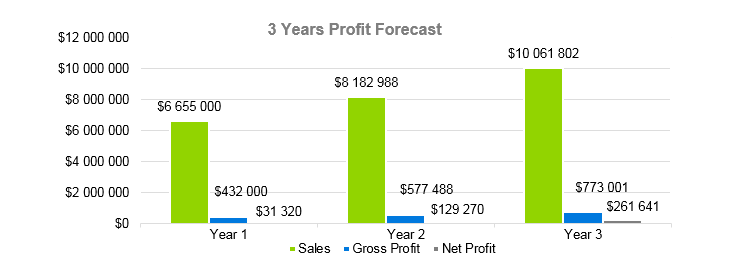
Company Summary
3.1 company owner.
Land Care is started and owned by Judi Smith. Judi has done her graduation in Horticulture. She is well known for her ideas of upkeeping garden spaces. During and after her academic years, she has won many landscaping competitions.
3.2 Why the landscaping business is being started
Judi was always an enthusiast of garden structure design. She decided to start a landscape business plan to utilize her skills and her passion for the benefit of her customers. As well as for earning a good living.
3.3 How the landscaping business will be started
Step1: Drafting landscaping business description
To ensure a successful startup it is essential to do everything with proper planning. Judi studied several landscaping business plan examples to make a landscaping business plan for her business. But due to a lack of experience in marketing and financial analysis, she decided to hire a professional to write a business plan landscape company for her. The landscape business plan she got written is provided in this lawn care business plan sample .
Step2: Define the brand
Judi acquired the licenses and permits required to start her own landscaping business plan . Meanwhile, she defined her services, business values & aims, and customer care policies to get identified by the target market.
Step3: Set up everything from machinery to workforce
After that, Judi started to back up her business with a strong workforce and the latest landscaping tools. She rented a building to set up her office. Meanwhile, she hired a co-manager to get some help in conducting interviews and tests to hire the most competent employees. Then she purchased the required inventory to run her business plan landscape company .
Step4: Promote, market, establish a web presence
The last thing to do was to reach out to the target market. Judi utilized the latest methods including online and social media campaigns to attract target customers. The detailed advertisement plan Judi employed to get introduced to a large audience will be provided in later sections.
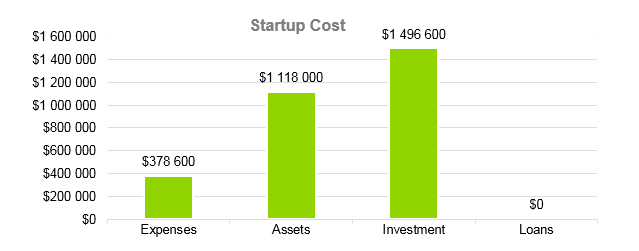
| Legal | $243,000 |
| Consultants | $0 |
| Insurance | $29,000 |
| Rent | $24,000 |
| Research and Development | $28,500 |
| Expensed Equipment | $50,000 |
| Signs | $4,100 |
| Start-up Assets | $318,000 |
| Cash Required | $326,000 |
| Start-up Inventory | $52,000 |
| Other Current Assets | $203,000 |
| Long-term Assets | $219,000 |
| Start-up Expenses to Fund | $378,600 |
| Start-up Assets to Fund | $1,118,000 |
| Assets | |
| Non-cash Assets from Start-up | $1,488,000 |
| Cash Requirements from Start-up | $357,000 |
| Additional Cash Raised | $51,200 |
| Cash Balance on Starting Date | $33,800 |
| Liabilities and Capital | |
| Liabilities | $30,000 |
| Current Borrowing | $0 |
| Long-term Liabilities | $0 |
| Accounts Payable (Outstanding Bills) | $39,000 |
| Other Current Liabilities (interest-free) | $0 |
| Capital | |
| Planned Investment | $1,496,600 |
| Investor 1 | $0 |
| Investor 2 | $0 |
| Other | $0 |
| Additional Investment Requirement | $0 |
| Loss at Start-up (Start-up Expenses) | $364,400 |
When you are owning your own landscaping business plan you can implement your creative ideas to the fullest. However, it is still necessary to write down the services you want to provide your customers in a landscape business plan template. As it will enable you to get the required inventory and to hire the employees with the relevant skills.
- Stone walls
- Ground cover
- Landscape stairs
- Plant anchors
- Turf installation
- Rotovating soil
- Hydroseeding
- Grasscycling
- Maintenance of rock and gravel landscape
- Planting Trees/ Shrubs/ Flowers/ Vegetables Our last service will include cultivating plants on your lawn. We’ll plant trees, shrubs, flowers, vegetables, and fruits that would be considered best for your soil.
Marketing Analysis of Landscaping Business
Before opening a business plan landscape company it is essential to carry out an accurate marketing analysis. This is to know the market opportunities and your target customers. Exploring the groups of your target customers should be done before even researching on how to write a business plan for landscaping. It is because a thorough knowledge of your customers will enable you in introducing the services that would interest them.
Marketing analysis is a stepwise process. If you are looking for a complete business plan for a landscaping company, you can take help from here. In this landscape business plan and landscaping business model we’re providing marketing analysis done for Land Care.
5.1 Market Trends
Landscaping services are in great demand. Firstly because they freshen and beautify the outdoor spaces. And second due to the awareness in people to keep their surroundings green. According to IBISWorld, the landscaping business plan has seen a growth rate of 1.8% during the past five years i.e. from 2016 to 2021. And the landscape business plan is expected to grow by another 1% in 2021.
The latest stats calculated in 2021 also reports the total market size of landscaping services as $99.7 billion. Thus, the market stats are satisfactory to initiate your startup.
5.2 Marketing Segmentation
The potential customers of Land Care are divided into the following groups:
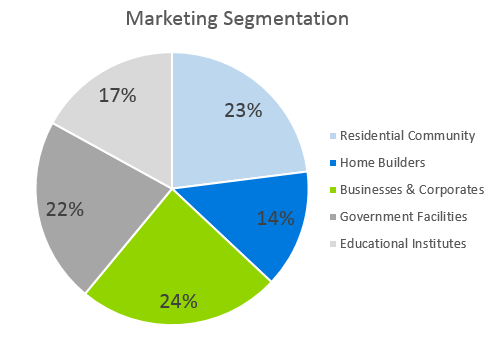
5.2.1 Residential Community
Our primary customers will be the residents living in our vicinity. In our city, most of the families belong to the working class and others do not have a great number of young enthusiasts to install a lawn themselves. Therefore, to beautify and maintain their outdoor they’ll need to hire professional services.
5.2.2 Home Builders
Our second target customers will be the construction companies and contractors who build homes. Landscaping and lawn installation increases the value of the property. Therefore, they are expected to avail of our landscape design services.
5.2.3 Businesses & Corporates
Nowadays, all small and large buildings of businesses and corporates contain decorative landscaped lawns. As that helps in creating a refreshing environment. This group is expected to become our potential customers as they’ll also need regular maintenance and care.
5.2.4 Government Facilities
Government properties, offices, public parks, bus stations, and even some streets are also marked by landscaped lawns and designs. Therefore, they will also be hiring our services.
5.2.5 Educational Institutes
Almost all educational institutions ranging from schools to universities contain beautiful lawns. This is to create a pleasant and natural atmosphere to promote learning. Thus, such institutions are also expected to avail of all our services.
| Potential Customers | Growth | ||||||
| Residential Community | 23% | 31,000 | 32,000 | 34,000 | 36,000 | 38,000 | 10.00% |
| Home Builders | 14% | 19,000 | 21,000 | 22,000 | 24,000 | 26,000 | 10.00% |
| Businesses & Corporates | 24% | 35,000 | 36,000 | 37,000 | 38,000 | 39,000 | 10.00% |
| Government Facilities | 22% | 30,000 | 31,000 | 32,000 | 33,000 | 34,000 | 10.00% |
| Educational Institutes | 17% | 27,000 | 28,000 | 29,000 | 31,000 | 32,000 | 11.00% |
| 10% |
5.3 Business Target
- To earn a net profit margin of $10.7k per month by the end of the second year and $21.8k per month by the end of the three years of our launch
- To achieve an average rating above 4.8 within a year of our launch
- To achieve a Net Promoter Score above 80%
- To achieve and maintain a CSAT score above 95%
Immigration business plan
5.4 product pricing.
Our prices are a little higher than our competitors. However, we still expect to get more customers as we provide a 50% discount on the maintenance of lawns that are installed/ designed by us.
Marketing Strategy
No matter how efficient and skillful you are, you can never get customers without an effective marketing plan for the landscaping business plan . Thus, to make sure that your customers know about you, you should start advertising before starting a business plan landscape company . Here we’re listing how Judi decided to market her startup.
6.1 Competitive Analysis
The competitive aspects we’ll have to outperform our competitors are listed here:
- We’ll establish a website and social media account to display our works and to facilitate our customers in booking our services and in giving feedback.
- We’ll use the latest tools to ensure quick work delivery.
- We are highly client-oriented. Our skillful workers will be working in collaboration with customers to ensure that they get what they wanted.
6.2 Sales Strategy
- We’ll set up four different forms of landscaped lawns in our workspace to give an idea of what to expect from us.
- We’ll advertise our services through Google Local ads service and social media sites.
- We’ll make our website SEO to get topmost positions in Google searches.
- We’ll offer a 50% discount on all of our services for the first 20 days of our launch.
- We’ll offer a 50% discount on lawn maintenance/ care services for the lawns that are installed/ designed by us.
6.3 Sales Monthly
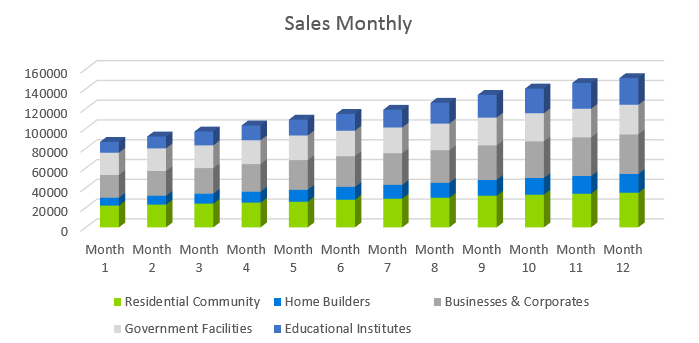
6.4 Sales Yearly
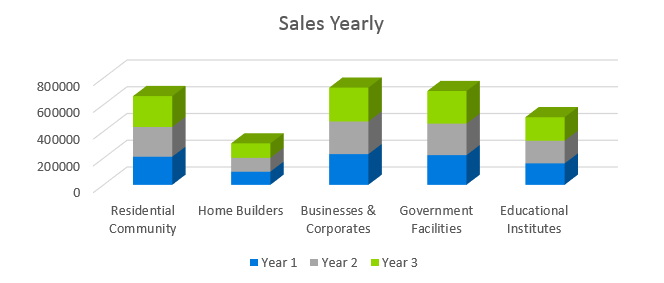
6.5 Sales Forecast
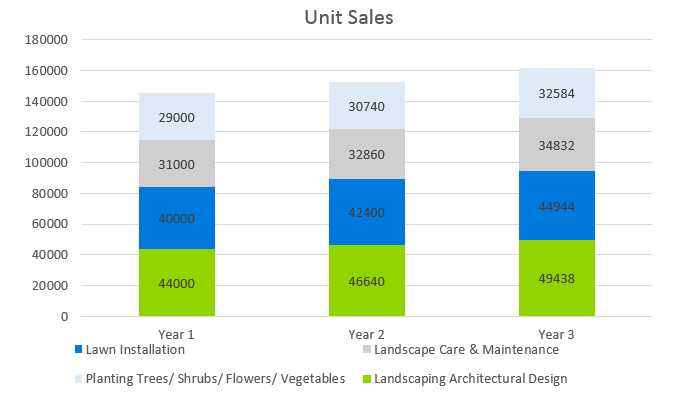
| Unit Sales | |||
| Landscaping Architectural Design | 44,000 | 46,640 | 49,438 |
| Lawn Installation | 40,000 | 42,400 | 44,944 |
| Landscape Care & Maintenance | 31,000 | 32,860 | 34,832 |
| Planting Trees/ Shrubs/ Flowers/ Vegetables | 29,000 | 30,740 | 32,584 |
| Unit Prices | Year 1 | Year 2 | Year 3 |
| Landscaping Architectural Design | $50.00 | $58.00 | $67.28 |
| Lawn Installation | $55.00 | $63.80 | $74.01 |
| Landscape Care & Maintenance | $40.00 | $46.40 | $53.82 |
| Planting Trees/ Shrubs/ Flowers/ Vegetables | $35.00 | $40.60 | $47.10 |
| Sales | |||
| Direct Unit Costs | Year 1 | Year 2 | Year 3 |
| Landscaping Architectural Design | $47.00 | $55.00 | $63.00 |
| Lawn Installation | $52.00 | $59.50 | $69.00 |
| Landscape Care & Maintenance | $37.00 | $42.00 | $48.00 |
| Planting Trees/ Shrubs/ Flowers/ Vegetables | $32.00 | $37.00 | $43.00 |
| Direct Cost of Sales | |||
Personnel plan
While writing a landscape business plan you should include a detailed list of the employees you’ll hire to run your business plan landscape company . The list should also include expected/ average salaries so that you can arrange for the finances accordingly.
The personnel plan developed for Land Care is provided here as an example.
7.1 Company Staff
- 1 Co-Manager to help in overall operations
- 5 Landscapers to design, construct & beautify the outdoor area
- 4 Gardeners to fertilize the soil, mow lawn & plant plants
- 1 Social Media Manager to manage company’s sites
- 1 Technician to upkeep the machinery
- 1 Accountant to maintain financial records
- 1 Sales Executive to execute the marketing strategy
- 1 Receptionist/ Call operator
7.2 Average Salary of Employees
| Co-Manager | $14,000 | $15,400 | $16,940 |
| Landscapers | $73,000 | $80,300 | $88,330 |
| Gardeners | $60,000 | $66,000 | $72,600 |
| Social Media Manager | $7,000 | $7,700 | $8,470 |
| Technician | $10,000 | $11,000 | $12,100 |
| Accountant | $9,000 | $9,900 | $10,890 |
| Cleaners | $15,000 | $16,500 | $18,150 |
| Drivers | $16,000 | $17,600 | $19,360 |
| Sales Executive | $8,000 | $8,800 | $9,680 |
| Receptionist/ Call Operator | $7,000 | $7,700 | $8,470 |
Financial Plan
The financial plan is a crucial component when you make a landscaping business plan. In your financial plan, you should analyze projected profits and losses, gross margins, cash flows, and balance sheets to find out
- Where to invest more in order to get the desired goals?
- What financial decisions should be taken to achieve long term success?
- How to ensure financial stability for your business plan landscape company ?
To help you in making a landscaping financial plan that satisfies all the above-mentioned requirements, we’re providing the financial plan sample made for Land Care.
8.1 Important Assumptions
| Plan Month | 1 | 2 | 3 |
| Current Interest Rate | 8.17% | 8.24% | 8.32% |
| Long-term Interest Rate | 8.30% | 8.35% | 8.42% |
| Tax Rate | 23.80% | 24.40% | 25.90% |
| Other | 0 | 0 | 0 |
8.2 Break-even Analysis
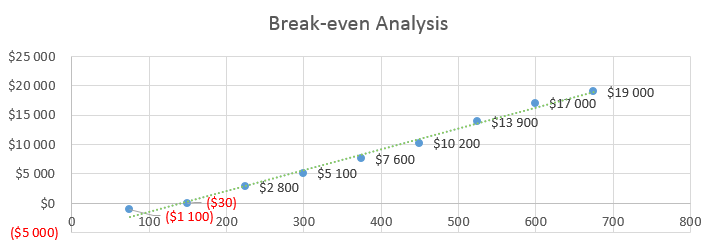
| Monthly Units Break-even | 5338 |
| Monthly Revenue Break-even | $130,000 |
| Assumptions: | |
| Average Per-Unit Revenue | $234.00 |
| Average Per-Unit Variable Cost | $0.63 |
| Estimated Monthly Fixed Cost | $168,000 |
8.3 Projected Profit and Loss
| Other | $0 | $0 | $0 |
| TOTAL COST OF SALES | |||
| Expenses | |||
| Payroll | $219,000 | $240,900 | $264,990 |
| Sales and Marketing and Other Expenses | $134,000 | $134,000 | $139,000 |
| Depreciation | $2,250 | $2,300 | $2,410 |
| Leased Equipment | $0 | $0 | $0 |
| Utilities | $2,600 | $2,800 | $2,900 |
| Insurance | $2,000 | $2,000 | $2,050 |
| Rent | $3,000 | $3,500 | $3,600 |
| Payroll Taxes | $30,000 | $30,400 | $31,000 |
| Other | $0 | $0 | $0 |
| Profit Before Interest and Taxes | $39,150 | $161,588 | $327,051 |
| EBITDA | $39,150 | $161,588 | $327,051 |
| Interest Expense | $0 | $0 | $0 |
| Taxes Incurred | $7,830 | $32,318 | $65,410 |
| Net Profit | $31,320 | $129,270 | $261,641 |
| Net Profit/Sales | 0.47% | 1.58% | 2.60% |
8.3.1 Profit Monthly
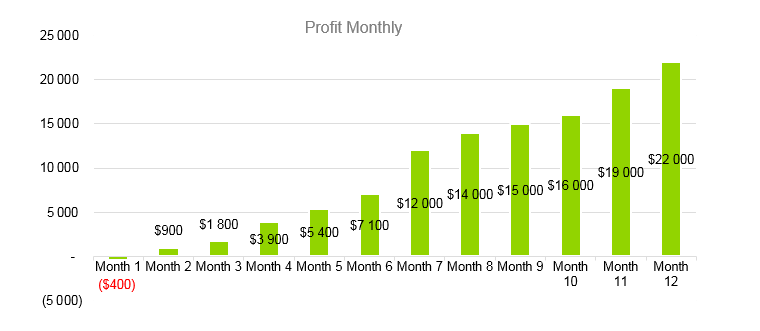
8.3.2 Profit Yearly
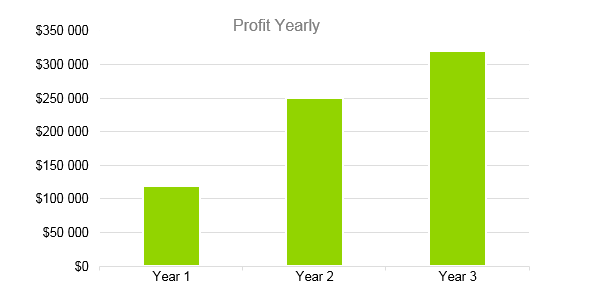
8.3.3 Gross Margin Monthly
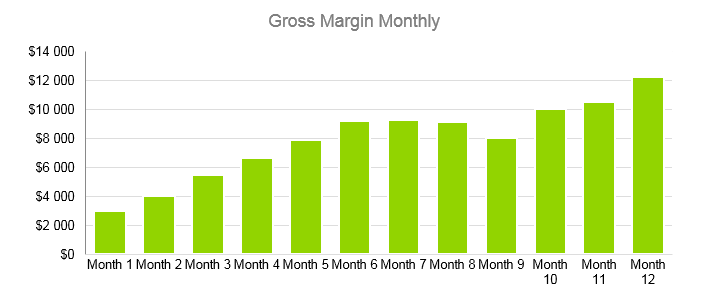
8.3.4 Gross Margin Yearly
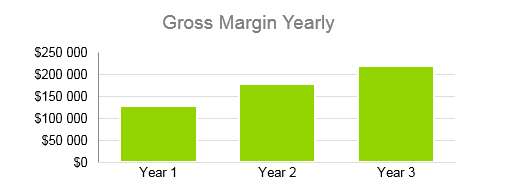
8.4 Projected Cash Flow
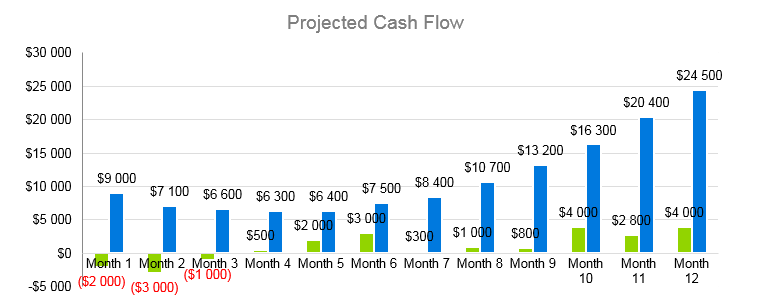
| Cash Received | |||
| Cash from Operations | |||
| Cash Sales | $52,000 | $56,160 | $60,653 |
| Cash from Receivables | $19,000 | $20,520 | $22,162 |
| SUBTOTAL CASH FROM OPERATIONS | |||
| Additional Cash Received | |||
| Sales Tax, VAT, HST/GST Received | $0 | $0 | $0 |
| New Current Borrowing | $0 | $0 | $0 |
| New Other Liabilities (interest-free) | $0 | $0 | $0 |
| New Long-term Liabilities | $0 | $0 | $0 |
| Sales of Other Current Assets | $0 | $0 | $0 |
| Sales of Long-term Assets | $0 | $0 | $0 |
| New Investment Received | $0 | $0 | $0 |
| SUBTOTAL CASH RECEIVED | |||
| Expenditures | Year 1 | Year 2 | Year 3 |
| Expenditures from Operations | |||
| Cash Spending | $33,000 | $34,500 | $35,000 |
| Bill Payments | $15,800 | $17,600 | $18,200 |
| SUBTOTAL SPENT ON OPERATIONS | |||
| Additional Cash Spent | |||
| Sales Tax, VAT, HST/GST Paid Out | $0 | $0 | $0 |
| Principal Repayment of Current Borrowing | $0 | $0 | $0 |
| Other Liabilities Principal Repayment | $0 | $0 | $0 |
| Long-term Liabilities Principal Repayment | $0 | $0 | $0 |
| Purchase Other Current Assets | $0 | $0 | $0 |
| Purchase Long-term Assets | $0 | $0 | $0 |
| Dividends | $0 | $0 | $0 |
| SUBTOTAL CASH SPENT | |||
| Net Cash Flow | $13,000 | $14,500 | $16,000 |
| Cash Balance | $24,000 | $25,000 | $26,000 |
8.5 Projected Balance Sheet
| Assets | |||
| Current Assets | |||
| Cash | $261,000 | $292,320 | $321,552 |
| Accounts Receivable | $23,700 | $26,544 | $29,835 |
| Inventory | $4,080 | $4,570 | $5,118 |
| Other Current Assets | $1,000 | $1,000 | $1,000 |
| TOTAL CURRENT ASSETS | |||
| Long-term Assets | |||
| Long-term Assets | $10,000 | $10,000 | $10,000 |
| Accumulated Depreciation | $18,200 | $20,384 | $22,932 |
| TOTAL LONG-TERM ASSETS | |||
| TOTAL ASSETS | |||
| Liabilities and Capital | Year 4 | Year 5 | Year 6 |
| Current Liabilities | |||
| Accounts Payable | $19,000 | $21,280 | $23,919 |
| Current Borrowing | $0 | $0 | $0 |
| Other Current Liabilities | $0 | $0 | $0 |
| SUBTOTAL CURRENT LIABILITIES | |||
| Long-term Liabilities | $0 | $0 | $0 |
| TOTAL LIABILITIES | |||
| Paid-in Capital | $29,000 | $30,000 | $31,000 |
| Retained Earnings | $54,000 | $58,860 | $64,746 |
| Earnings | $194,000 | $211,460 | $232,606 |
| TOTAL CAPITAL | |||
| TOTAL LIABILITIES AND CAPITAL | |||
| Net Worth | $280,000 | $305,200 | $335,720 |
8.6 Business Ratios
| Sales Growth | 7.28% | 8.07% | 8.94% | 3.00% |
| Percent of Total Assets | ||||
| Accounts Receivable | 9.22% | 10.22% | 11.32% | 9.80% |
| Inventory | 5.43% | 6.02% | 6.67% | 9.90% |
| Other Current Assets | 2.21% | 2.45% | 2.71% | 2.40% |
| Total Current Assets | 151.10% | 151.80% | 152.00% | 158.00% |
| Long-term Assets | 11.38% | 11.45% | 12.02% | 12.00% |
| TOTAL ASSETS | ||||
| Current Liabilities | 4.98% | 5.02% | 5.07% | 4.34% |
| Long-term Liabilities | 0.00% | 0.00% | 0.00% | 0.00% |
| Total Liabilities | 7.68% | 7.74% | 7.81% | 7.38% |
| NET WORTH | ||||
| Percent of Sales | ||||
| Sales | 100.00% | 100.00% | 100.00% | 100.00% |
| Gross Margin | 95.03% | 97.60% | 100.33% | 99.00% |
| Selling, General & Administrative Expenses | 95.60% | 98.18% | 100.93% | 97.80% |
| Advertising Expenses | 1.58% | 1.62% | 1.67% | 1.40% |
| Profit Before Interest and Taxes | 41.50% | 42.62% | 43.81% | 33.90% |
| Main Ratios | ||||
| Current | 33 | 34 | 35 | 32 |
| Quick | 31.5 | 32.8 | 33.62 | 33 |
| Total Debt to Total Assets | 0.17% | 0.16% | 0.16% | 0.40% |
| Pre-tax Return on Net Worth | 72.98% | 73.70% | 74.20% | 75.00% |
| Pre-tax Return on Assets | 95.76% | 100.55% | 105.58% | 111.30% |
| Additional Ratios | Year 1 | Year 2 | Year 3 | |
| Net Profit Margin | 33.67% | 34.71% | 35.79% | N.A. |
| Return on Equity | 55.47% | 57.19% | 58.96% | N.A. |
| Activity Ratios | ||||
| Accounts Receivable Turnover | 7.7 | 7.7 | 7.8 | N.A. |
| Collection Days | 100 | 100 | 100 | N.A. |
| Inventory Turnover | 31.8 | 33.39 | 34.1 | N.A. |
| Accounts Payable Turnover | 15.7 | 16.1 | 16.5 | N.A. |
| Payment Days | 27 | 27 | 27 | N.A. |
| Total Asset Turnover | 2.4 | 2.5 | 2.6 | N.A. |
| Debt Ratios | ||||
| Debt to Net Worth | -0.04 | -0.03 | -0.03 | N.A. |
| Current Liab. to Liab. | 1 | 1 | 1 | N.A. |
| Liquidity Ratios | ||||
| Net Working Capital | $238,000 | $251,328 | $265,402 | N.A. |
| Interest Coverage | 0 | 0 | 0 | N.A. |
| Additional Ratios | ||||
| Assets to Sales | 0.86 | 0.86 | 0.87 | N.A. |
| Current Debt/Total Assets | 1% | 0% | 0% | N.A. |
| Acid Test | 27 | 28.1 | 28.7 | N.A. |
| Sales/Net Worth | 2.1 | 2.2 | 2.3 | N.A. |
| Dividend Payout | 0 | 0 | 0 | N.A. |
Download Landscaping Business Plan in pdf
OGS capital professional writers specialized also in themes such as garden nursery business plan , janitorial services business plan , pressure washing business plan , real estate flipping business plan , handyman business plan and many other business plans.
OGSCapital’s team has assisted thousands of entrepreneurs with top-rate business plan development, consultancy and analysis. They’ve helped thousands of SME owners secure more than $1.5 billion in funding, and they can do the same for you.

Ice Vending Machine Business Plan

OGScapital at the National Citizenship and Immigration Conference

How to Start a Plumbing Business in 2024: A Detailed Guide

Vegetable Farming Business Plan

Trading Business Plan

How To Write A Textile Manufacturing Business Plan

Any questions? Get in Touch!
We have been mentioned in the press:
Leave a Reply Cancel reply
Your email address will not be published. Required fields are marked *
Save my name, email, and website in this browser for the next time I comment.
Search the site:
What Does It Cost to Start a Lawn Care Business?

You’ve heard the old saying: “you’ve got to spend money to make money.” Starting a lawn care business is no different. You have to purchase equipment, obtain a license and insurance, acquire customers — it can feel almost overwhelming.
This guide will walk you through the steps of starting your own lawn care business, and help you identify the least expensive options along the way.
We’ll look at three main areas of expense you’ll run into:
- Business license and fees
- Operation costs
How to save: buy used or in a bundle
Lawn mowers, string trimmers, leaf blowers, additional equipment, business license and fees, customer acquisition, business insurance, fuel and maintenance, to get started, buy your lawn equipment.
The cost of starting a lawn care business from scratch can range from $15,000 to over $50,000, depending largely on the quality of equipment you purchase. If you already have access to a pickup truck, garage space, or lawn mower, you can cut this cost dramatically.
If you don’t have access to that kind of cash upfront, dealer financing and small business loans are available to help your lawn care operation pay for itself. Even though starting a business seems daunting, a platform like LawnStarter can help you turn a profit quickly by connecting you to new customers, optimizing routes, and handling all your accounting and billing.
LawnStarter requires its pros to own three main tools: a lawn mower, a string trimmer, and a leaf blower. You’ll also need a truck or SUV capable of hauling those tools. For the most basic one- or two-person operation, this may be all you need to get started.
Our research has found that used lawn care equipment, or commercial equipment bundles from independent equipment dealers, can save you thousands of dollars as you start your business. Full packages including trailers, mowers, blowers, and trimmers are the most cost-effective way to start a commercial lawn care business.
3 essential lawn care tools
Let’s start simple. You’re going to need three essential tools to operate a lawn care company: a lawn mower, a string trimmer, and a leaf blower. All three of these tools come in a variety of brands, with different power sources, abilities, and price points. It’s important to choose the right options for the types of lawns you’ll encounter most.

Push or ride-on? Electric or gas? For a brand-new lawn care professional, the sheer number of choices can make finding the right mower a chore. Every option has its pros and cons.
For example, electric mowers cut down fuel costs, but can’t run all day without you changing the battery a few times. Riding mowers can handle larger yards, but require a trailer and a high towing capacity to transport them.
Time is money, as the saying goes, and a faster mower can significantly boost the number of yards you’ll get done in a typical day. While a commercial stand-on or zero-turn mower may come with a steeper price tag, it will significantly affect your income.
When buying new equipment, a commercial-grade walk-behind mower will cost between $1,000 and $5,000 , and a ride-on mower will cost $6,000-$10,000 or more.
However, a quick Google search for equipment bundles will turn up much less expensive results. A full commercial mower bundle, complete with trimmer, blower, and trailer, can cost as little as $6,000. Many equipment dealers will offer financing options, so you don’t need to front the entire cost.
Check out our Lawn Mower Pricing Guide for more information on purchasing a mower.

Clean-cut edges make the difference between an amateur mow and a professional lawn care service. A good string trimmer , also known as an edger, weed eater , or weed wacker, is a tool that will help you deliver lawn care that’s a cut above many of your competitors.
The cost of a commercial-grade weed wacker varies but generally runs between $100-$400.

A high-quality lawn care job isn’t over until you’ve cleaned up. A commercial leaf blower will clear grass clippings, leaves, and other debris from the yard and hardscapes. A backpack-style blower, the most popular type for pros, costs between $250 and $500 .
Transportation and storage
Lawn care is a field service industry. You need a reliable way to get you and your equipment to your customer’s property, and a place to store and maintain your equipment at the end of the day. Apart from a mower, your vehicle will likely be the biggest purchase you’ll make.
When you’re just starting in the lawn care industry, you’ll probably be looking at used vehicles to keep your costs down. Choosing a vehicle is a big decision. Factors such as fuel economy, mileage, and towing capacity should all be considered.
A new pickup truck will likely cost between $30,000 and $50,000 , while used trucks can be found for as little as $5,000 .
If you’re planning to purchase a larger mower, you’ll need a trailer to haul it. There are a variety of factors to consider when choosing a trailer, the most obvious being its design.
Flatbed trailers are less expensive than covered trailers, but leave your equipment exposed to the elements.
Covered trailers protect your equipment from theft and damage, and can save you money on storage.
On average, open trailers cost around $1,000 and enclosed trailers can run from $3,000 to $10,000.
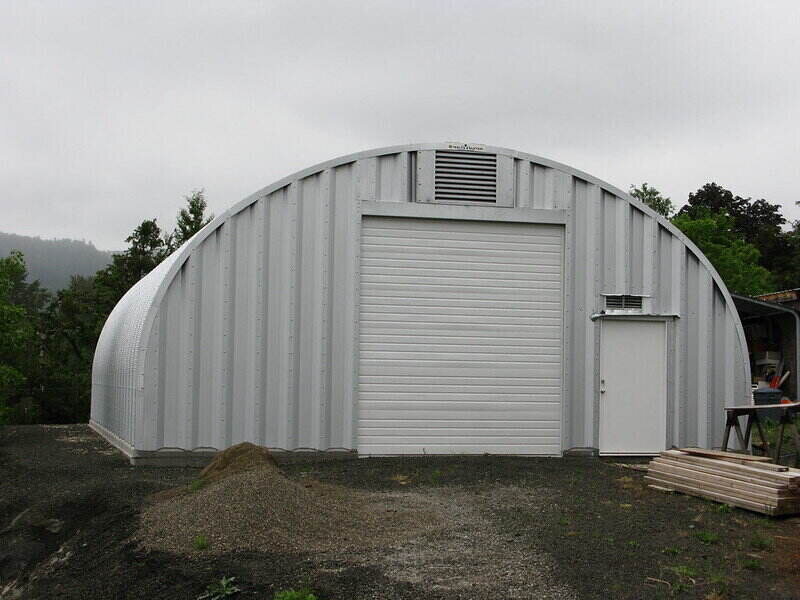
If you don’t have access to a garage, finding a place to store and maintain your equipment can be a challenge. For this reason, an enclosed trailer can serve as a garage and may be worth the extra investment.
Renting a storage unit is another option. Mobile storage units (like PODS) average around $150/month . Units at self-storage businesses are comparably priced, though larger units can cost up to $300/month .
As your business grows, you may want to offer other outdoor services to your customers. Services like pressure washing or aeration can set you apart from your competitors. Many lawn care companies also offer winter services , such as snow removal, to keep business flowing in the mowing off-season.
Here’s a list of additional lawn care and outdoor services equipment you may consider purchasing, and the average cost:
| Rakes, spades, , etc. | $10-$50 each |
| $100 | |
| $150 | |
| Aerator | $250 |
| $250 | |
| $800 |
Most states will require you to obtain a business license before operating a lawn care company. Generally, a business license costs between $50 and $100 to incorporate as a limited liability company or create a DBA (doing business as, also known as a fictitious name). If you plan to be a one-person lawn care service, a DBA is the easiest way to get started.
If you plan to hire employees, you’ll have to pay for workers’ compensation insurance, which is calculated as a percentage of total payroll.
Some states require additional certifications to begin operating a landscaping service. These may include courses in the proper use of safety equipment, first aid training, and environmentally responsible handling of pesticides and herbicides.
Check with your local state Department of Agriculture to learn what the local requirements are for starting a lawn care or landscaping business.
Operation Costs
Your business expenses don’t end after you’ve paid your startup costs. When you’re still building your customer base, the cost of operations may outweigh your income. Joining an organization like LawnStarter will help you build your customer base quickly so you can see profits sooner.

To acquire customers, you’ll need to invest in building your client base. Relying solely on word-of-mouth referrals to gain customers can make for slow growth.
For small lawn care operations, printing flyers and posting them in your neighborhood is an inexpensive way to advertise. Creating a presence on social media can also help spread awareness of your brand.
If you have the cash to hire a graphic designer, a company logo featuring your business name can attract potential customers. You also can use your lawn care company’s logo on truck wraps, business cards, T-shirts, and more.
Pro Tip: The easiest way to reach customers is by joining LawnStarter. We put new business owners in contact with a wide customer base where you live and work at no cost.
Lawn care companies use expensive equipment and vehicles, and pros are always at risk of injury. Whether you have one employee or a fleet, you need some form of insurance to stay in business when an emergency occurs.
Small lawn care businesses pay an average of $50/month for insurance.
If you don’t want to track all your business expenses on paper, there are a lot of software options aimed at making it easier to manage your lawn care business. Most business software suites for lawn care companies cost between $30-$50 per month, but there are free options.

You can save fuel costs to some extent by using battery-powered tools, but every successful lawn care business is going to rack up fuel expenses. A single-truck lawn care or landscaping company can expect to spend around $5,000/year on fuel, depending on gas prices.
Learning how to maintain small engines will save you money in the long run. Keeping your lawn care equipment in top shape isn’t difficult, and it will save you repair and replacement costs.
Even after a long, tiring day of mowing, it’s important to spend time making sure your machines are clean and properly stored.
It really does take money to make money, and you need to mow a lot of green grass to make a lot of green.
The biggest obstacle to overcome when starting a lawn care company is the cost of equipment. Buying used or bundled equipment and exploring financing options can be a game-changer for a prospective lawn care entrepreneur.
Here’s why: As long as you can build a customer base, your equipment will pay for itself.
LawnStarter is committed to helping pros build their customer base. We’ve made it possible for thousands of pros to turn profits. If you’re interested in starting a lawn care business, LawnStarter can help your lawn care company get off the ground successfully faster than if you were to go it alone.
If you have questions about LawnStarter’s platform and ways you can better use the services, call or text LawnStarter Pro Support at 855-800-4872 Monday through Saturday.
Main Photo Credit: TheDigitalWay / Pixabay
Related Posts

Stephen Kime
- Build your business
Business Tools
- Profit Margin Calculator
- Business Name Generator
- Slogan Generator
- Traffic Calculator
- Ecommerce Statistics
- Ecommerce Wiki
Free business tools
Start a business and design the life you want – all in one place.
- © 2015-2024 Oberlo

The 7 Best Business Plan Examples (2024)
As an aspiring entrepreneur gearing up to start your own business , you likely know the importance of drafting a business plan. However, you might not be entirely sure where to begin or what specific details to include. That’s where examining business plan examples can be beneficial. Sample business plans serve as real-world templates to help you craft your own plan with confidence. They also provide insight into the key sections that make up a business plan, as well as demonstrate how to structure and present your ideas effectively.
Example business plan
To understand how to write a business plan, let’s study an example structured using a seven-part template. Here’s a quick overview of those parts:
- Executive summary: A quick overview of your business and the contents of your business plan.
- Company description: More info about your company, its goals and mission, and why you started it in the first place.
- Market analysis: Research about the market and industry your business will operate in, including a competitive analysis about the companies you’ll be up against.
- Products and services: A detailed description of what you’ll be selling to your customers.
- Marketing plan: A strategic outline of how you plan to market and promote your business before, during, and after your company launches into the market.
- Logistics and operations plan: An explanation of the systems, processes, and tools that are needed to run your business in the background.
- Financial plan: A map of your short-term (and even long-term) financial goals and the costs to run the business. If you’re looking for funding, this is the place to discuss your request and needs.
7 business plan examples (section by section)
In this section, you’ll find hypothetical and real-world examples of each aspect of a business plan to show you how the whole thing comes together.
- Executive summary
Your executive summary offers a high-level overview of the rest of your business plan. You’ll want to include a brief description of your company, market research, competitor analysis, and financial information.
In this free business plan template, the executive summary is three paragraphs and occupies nearly half the page:
- Company description
You might go more in-depth with your company description and include the following sections:
- Nature of the business. Mention the general category of business you fall under. Are you a manufacturer, wholesaler, or retailer of your products?
- Background information. Talk about your past experiences and skills, and how you’ve combined them to fill in the market.
- Business structure. This section outlines how you registered your company —as a corporation, sole proprietorship, LLC, or other business type.
- Industry. Which business sector do you operate in? The answer might be technology, merchandising, or another industry.
- Team. Whether you’re the sole full-time employee of your business or you have contractors to support your daily workflow, this is your chance to put them under the spotlight.
You can also repurpose your company description elsewhere, like on your About page, Instagram page, or other properties that ask for a boilerplate description of your business. Hair extensions brand Luxy Hair has a blurb on it’s About page that could easily be repurposed as a company description for its business plan.

- Market analysis
Market analysis comprises research on product supply and demand, your target market, the competitive landscape, and industry trends. You might do a SWOT analysis to learn where you stand and identify market gaps that you could exploit to establish your footing. Here’s an example of a SWOT analysis for a hypothetical ecommerce business:

You’ll also want to run a competitive analysis as part of the market analysis component of your business plan. This will show you who you’re up against and give you ideas on how to gain an edge over the competition.
- Products and services
This part of your business plan describes your product or service, how it will be priced, and the ways it will compete against similar offerings in the market. Don’t go into too much detail here—a few lines are enough to introduce your item to the reader.
- Marketing plan
Potential investors will want to know how you’ll get the word out about your business. So it’s essential to build a marketing plan that highlights the promotion and customer acquisition strategies you’re planning to adopt.
Most marketing plans focus on the four Ps: product, price, place, and promotion. However, it’s easier when you break it down by the different marketing channels . Mention how you intend to promote your business using blogs, email, social media, and word-of-mouth marketing.
Here’s an example of a hypothetical marketing plan for a real estate website:

Logistics and operations
This section of your business plan provides information about your production, facilities, equipment, shipping and fulfillment, and inventory.
Financial plan
The financial plan (a.k.a. financial statement) offers a breakdown of your sales, revenue, expenses, profit, and other financial metrics. You’ll want to include all the numbers and concrete data to project your current and projected financial state.
In this business plan example, the financial statement for ecommerce brand Nature’s Candy includes forecasted revenue, expenses, and net profit in graphs.

It then goes deeper into the financials, citing:
- Funding needs
- Project cash-flow statement
- Project profit-and-loss statement
- Projected balance sheet
You can use Shopify’s financial plan template to create your own income statement, cash-flow statement, and balance sheet.
Types of business plans (and what to write for each)
A one-page business plan is a pared down version of a standard business plan that’s easy for potential investors and partners to understand. You’ll want to include all of these sections, but make sure they’re abbreviated and summarized:
- Logistics and operations plan
- Financials
A startup business plan is meant to secure outside funding for a new business. Typically, there’s a big focus on the financials, as well as other sections that help determine the viability of your business idea—market analysis, for example. Shopify has a great business plan template for startups that include all the below points:
- Market research: in depth
- Financials: in depth
Your internal business plan acts as the enforcer of your company’s vision. It reminds your team of the long-term objective and keeps them strategically aligned toward the same goal. Be sure to include:
- Market research
Feasibility
A feasibility business plan is essentially a feasibility study that helps you evaluate whether your product or idea is worthy of a full business plan. Include the following sections:
A strategic (or growth) business plan lays out your long-term vision and goals. This means your predictions stretch further into the future, and you aim for greater growth and revenue. While crafting this document, you use all the parts of a usual business plan but add more to each one:
- Products and services: for launch and expansion
- Market analysis: detailed analysis
- Marketing plan: detailed strategy
- Logistics and operations plan: detailed plan
- Financials: detailed projections
Free business plan templates
Now that you’re familiar with what’s included and how to format a business plan, let’s go over a few templates you can fill out or draw inspiration from.
Bplans’ free business plan template

Bplans’ free business plan template focuses a lot on the financial side of running a business. It has many pages just for your financial plan and statements. Once you fill it out, you’ll see exactly where your business stands financially and what you need to do to keep it on track or make it better.
PandaDoc’s free business plan template

PandaDoc’s free business plan template is detailed and guides you through every section, so you don’t have to figure everything out on your own. Filling it out, you’ll grasp the ins and outs of your business and how each part fits together. It’s also handy because it connects to PandaDoc’s e-signature for easy signing, ideal for businesses with partners or a board.
Miro’s Business Model Canvas Template

Miro’s Business Model Canvas Template helps you map out the essentials of your business, like partnerships, core activities, and what makes you different. It’s a collaborative tool for you and your team to learn how everything in your business is linked.
Better business planning equals better business outcomes
Building a business plan is key to establishing a clear direction and strategy for your venture. With a solid plan in hand, you’ll know what steps to take for achieving each of your business goals. Kickstart your business planning and set yourself up for success with a defined roadmap—utilizing the sample business plans above to inform your approach.
Business plan FAQ
What are the 3 main points of a business plan.
- Concept. Explain what your business does and the main idea behind it. This is where you tell people what you plan to achieve with your business.
- Contents. Explain what you’re selling or offering. Point out who you’re selling to and who else is selling something similar. This part concerns your products or services, who will buy them, and who you’re up against.
- Cash flow. Explain how money will move in and out of your business. Discuss the money you need to start and keep the business going, the costs of running your business, and how much money you expect to make.
How do I write a simple business plan?
To create a simple business plan, start with an executive summary that details your business vision and objectives. Follow this with a concise description of your company’s structure, your market analysis, and information about your products or services. Conclude your plan with financial projections that outline your expected revenue, expenses, and profitability.
What is the best format to write a business plan?
The optimal format for a business plan arranges your plan in a clear and structured way, helping potential investors get a quick grasp of what your business is about and what you aim to achieve. Always start with a summary of your plan and finish with the financial details or any extra information at the end.
Want to learn more?
- Question: Are You a Business Owner or an Entrepreneur?
- Bootstrapping a Business: 10 Tips to Help You Succeed
- Entrepreneurial Mindset: 20 Ways to Think Like an Entrepreneur
- 101+ Best Small Business Software Programs
Landscaping Business Plans
Construction irrigation business plan.
Hass Irrigation Systems is a subcontractor providing home and yard irrigation systems for residentail new home construction.
Lawn Landscaping Business Plan
Greens Manicure Service is a start-up company providing residential lawn-care services.
Wholesale Landscape Products Business Plan
Glen Mar Forest Products will use forest wood by-products to manufacture and wholesale a color enhanced mulch/landscape ground cover.
Landscape Design and Maintenance Business Plan
Emerald Outdoor Design is a full-service landscape design and implementation firm with the goal to bring beauty to your home that adds to serenity in your life.
If you’re ready to take your landscaping knowledge and turn it into a business, you need a plan. Before you start writing a business plan for your business, though, take a look at a few sample business plans for nurseries, landscaping, and lawn and garden businesses.

The quickest way to turn a business idea into a business plan
Fill-in-the-blanks and automatic financials make it easy.
No thanks, I prefer writing 40-page documents.

Discover the world’s #1 plan building software
English Use arrow key to access related widget.
- Customer Service
- My USPS ›
- Español
Top Searches
Alert: USPS.com is undergoing routine maintenance from 10 PM ET, Saturday, May 18 through 4 AM ET, Sunday, May 19, 2024. During this time, you may not be able to sign in to your account and payment transactions on some applications may be temporarily unavailable. We apologize for any inconvenience.
Alert: Some of our applications may be unavailable during routine maintenance from Saturday, May 11 through Sunday, May 12. We apologize for any inconvenience.
Alert: Severe weather in the South, Southeast, and Midwest may impact package delivery. Read More ›
Alert: The online Postal Store is currently unavailable. We are working to resolve the issue and apologize for the inconvenience.
Alert: We are currently experiencing issues with some of our applications. We are working to resolve the issues and apologize for the inconvenience.
Alert: USPS.com is undergoing routine maintenance from 10 PM ET, Saturday, March 9 through 4 AM ET, Sunday, March 10, 2024. During this time, you may not be able to sign-in to your account and payment transactions on some applications may be temporarily unavailable. We apologize for any inconvenience.
Alert: Severe weather conditions across the U.S. may delay final delivery of your mail and packages. Read more ›
Alert: USPS.com is undergoing routine maintenance from 11 PM ET, Saturday, March 2 through 4 AM ET, March 3, 2024. During this time, payment transactions on some applications will be temporarily unavailable. We apologize for any inconvenience.
Alert: We are currently experiencing issues with some of our applications. We apologize for the inconvenience.
Alert: Payment transactions on some applications will be temporarily unavailable from 11 PM ET, Saturday, January 6 through 3 AM ET, Sunday, January 7, 2024. We apologize for any inconvenience.
Alert: Some of our applications are undergoing routine maintenance on Monday, October 30 from 10-11 PM ET and may be unavailable. We apologize for any inconvenience.
Alert: Some of our applications are undergoing routine maintenance from Saturday, August 26 through Sunday, August 27 and may be unavailable. We apologize for any inconvenience.
Image of play button
Find out how to send mail. 1:53
Video Description: How to Send a Letter or Postcard (TXT 4 KB)
How to Send a Letter or Postcard: Domestic
Sending mail with USPS is easy! Our video will help you with most letters, cards, and postcards you send domestically (inside the U.S.), including U.S. territories and military bases in the U.S. and abroad.
For how to ship a package, see How to Send a Package: Domestic .
Send Mail: Step-by-Step Instructions

Step 1: Choose Envelope or Postcard
Envelopes are for sending flat, flexible things, like letters, cards, checks, forms, and other paper goods. For just 1 $0.68 First-Class Mail ® Forever ® stamp , you can send 1 oz (about 4 sheets of regular, 8-1/2" x 11" paper in a rectangular envelope) to anywhere in the U.S.!

Envelopes must be rectangular and made of paper to qualify for letter prices. Your envelope can be a maximum of 11-1/2" long x 6-1/8" high. (A standard No. 10 envelope is 9-1/2" long x 4-1/8" high.) You can fold what you put in your envelope, but it needs to stay flat—no more than 1/4" thick.
If you want to send letter-sized papers without folding them, you can use a large envelope (called a "flat"); the postage for flats starts at $1.39 . If your large envelope is nonrectangular, rigid (can't bend), or lumpy (not uniformly thick), you'll have to pay the package price.
TIP: If your envelope can't fit through USPS mail processing machines, or is rigid, lumpy or has clasps, string, or buttons, it's "nonmachinable" and you'll have to pay $0.44 more to send it. ( See additional postage in Step 3 .) You'll also have to pay more if your envelopes are square or vertical (taller than they are wide).
Postcards are for short messages that you don't need to put in an envelope. Save money using a $0.53 postcard stamp to send a standard-sized postcard anywhere in the U.S. Standard postcards are usually made of paper, are between 5" to 6" long and 3-1/2" to 4-1/4" high, and are between 0.007" and 0.016" thick.
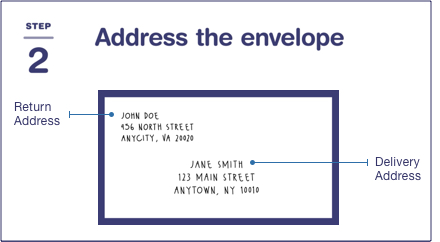
Step 2: Address Your Mail
Envelopes: Write your address (the "return" or "sender" address) in the top left corner. Write the delivery address (the "recipient" address) in the bottom center.
Postcards: Postcards come in different formats, so write the delivery address in the space it gives you (on the same side you write your message and put the stamp).
Print your return address and the delivery address clearly, in the correct spots, to make sure your mail is delivered on time.
Address Format Tips
- Use a pen or permanent marker.
- Do not use commas or periods.
- Include the ZIP+4 ® Code whenever possible.
Write Sender Address
Write your address (the "return address") in the top-left corner. Include the following on separate lines:
- Your full name or company name
- Apartment or suite number
- Full street address
- City, State, and ZIP+4 Code
Write Delivery Address
Write the delivery address (the "recipient" address) in the bottom center of the envelope. Include the following on separate lines:
- Recipient's full name or company name
If the apartment or suite number cannot fit on the delivery address line above the city, state, and ZIP+4 Code, place it on a separate line immediately above the delivery address line.
Write the sender's address in the top-left corner. Include the following on separate lines:
- Full street address and apartment or suite number, if applicable
Special U.S. Addresses
Puerto rico.
Some Puerto Rico addresses include an urbanization or community code for a specific area or development. Addresses with an urbanization code, abbreviated URB, should be written on 4 lines:
MS MARIA SUAREZ URB LAS GLADIOLAS 150 CALLE A SAN JUAN PR 00926-3232
More Puerto Rico Address Examples
U.S. Virgin Islands
Virgin Islands addresses have the same format as standard addresses. The right abbreviation for this territory is "VI," not "US VI" or "USA VI":
MS JOAN SMITH RR 1 BOX 6601 KINGSHILL VI 00850-9802
Military and Diplomatic Mail (APO/FPO/DPO)
Mail to military and diplomatic addresses is treated differently:
- Do not include the city or country name when you send something to an APO/FDO/DPO address in another country. This keeps your mail out of foreign mail networks.
- Do include unit and box numbers if they're assigned:
SEAMAN JOSEPH SMITH UNIT 100100 BOX 4120 FPO AP 96691
More Details on Military Addresses
When you're done addressing your envelope, put what you're sending inside the envelope, then close and seal it (using the envelope's glue or tape).
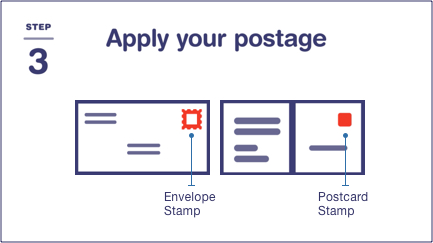
Step 3: Calculate Postage (& Add Insurance or Extra Services)
A First-Class Mail ® Forever stamp costs $0.68 and goes in the upper right corner of the envelope. (You can also use any combination of stamps that adds up to $0.68.)
If your letter is heavier or bigger, or if you want to add insurance or extra services like Certified Mail ® service, you'll pay more.
A standard postcard stamp costs $0.53 . (Large or square postcards will cost more.) Put the postcard stamp in the space provided near the delivery address.

Postage for letters mostly depends on weight and size/shape. You can weigh your letter with a kitchen scale, postal scale , at a self-service kiosk, or at the Post Office ™ counter.
TIP: As a rule of thumb, you can send 1 oz (4 sheets of printer paper and a business-sized envelope) for 1 First-Class Mail ® Forever ® stamp (currently $0.68).
The postage for a large envelope (or flat) starts at $1.39 for 1 oz.
Where Can I Buy Postage?
- The Postal Store ® Shop online for all stamps and add-on postage for oversized or heavier envelopes.
- Post Office Locations Buy stamps at Post Office locations , self-service kiosks , or at National Retailers such as grocery and drug stores.
TIP: If you're sending larger envelopes (flats) using Priority Mail ® or Priority Mail Express ® service, you can use Click-N-Ship ® service to pay for and print your own postage online.
Additional Postage
If your envelope weighs over 1 oz, you can buy additional postage in the amount you need:
- Each additional 1 oz is $0.24, for letters up to 3.5 oz and large envelopes up to 13 oz.
- Nonmachinable items, including envelopes that are lumpy or rigid, or have clasps, string, or buttons will cost $0.44 more to send. You'll also have to pay more if your envelopes are square or vertical (taller than they are wide).
- You can also buy 1¢, 2¢, 3¢, 4¢, 5¢, and 10¢ stamps at The Postal Store .
TIP: Put the stamp on last; that way, if you make a mistake at any other point, you won't waste a stamp.
Calculate a Price
Add-On Services
If you want insurance, proof of delivery, signature services, or other optional services, you'll have to pay extra.
Our Insurance & Extra Services page has more details; some of the more common add-on services for letters include:
- Certified Mail ® : Get proof that you mailed your item and that the recipient signed for it.
- Registered Mail ® : USPS's most secure mail service–mail is processed manually, handled separately and securely, and signed for along every step of its journey. The recipient must sign for the mail to confirm delivery (or attempted delivery).
- Return Receipt: You'll get a printed or emailed delivery record showing the recipient's signature. You can combine Return Receipt with other services, including Certified Mail, Registered Mail, Priority Mail Express ® service, and more.
- Adult Signature Required: Only an adult (age 21+) can sign for the mail after showing a valid government ID .
Postage Options
There are several ways to get postage for your envelope.
- The Postal Store ® --> ® and Priority Mail Express ® envelopes.
- Post Office ™ Locations --> ® such as grocery and drug stores.

Step 4: Send Your Mail
Once your envelope or postcard has the correct addresses and postage, you can send it several ways, including putting it in your mailbox or dropping it in a blue collection box or at a Post Office ™ location.

- Put your letter inside your mailbox and raise the flag (if you have one).
- If you have a cluster mailbox, drop it in the outgoing mail slot.
- Drop it off in a blue collection box.
- Take it to a Post Office lobby drop.
Important Note: If your envelope has postage stamps and weighs more than 10 oz or is thicker than 1/2", you can't put it in a collection box; you have to give it to an employee at a Post Office location. See more details on What Can and Cannot be Deposited in a Collection Box?
Bonus: Sending Mail Pro Tips
The Postal Service uses high-speed sorting machines to help process and deliver 425.3 million mail pieces each day. Here are some extra tips to improve your mail sending experience:
- Stay flexible : Don't send rigid (hard) objects in paper envelopes.
- Sending embellished invitations (for weddings, graduations, etc.)? Get them hand-canceled or put them inside another envelope.
- Need tracking? Learn about your options.

Stay Flexible
Postcards, letter envelopes, and large envelopes (flats) all need to bend to fit through USPS ® high-speed sorting machines.
- OK: Flexible, flat things like stickers, photos, trading cards, etc. should be okay—as long as your envelope stays flat, not lumpy, and less than 1/4" thick.
- Not OK: Don't put rigid objects (like flash drives, coins, keys, hard plastic card cases, etc.) loose in unpadded paper envelopes: They could get torn out of the envelope, jam the sorting machines, cause a delay, or even get lost.
Instead, for rigid and odd-shaped objects (or things you don't want to get bent), we recommend using a padded envelope or small box and sending it as a package .
Sending Embellished Invitations (for Weddings, Graduations, etc.)
If you want to send a specially decorated envelope (like some wedding invitations):
- You can pay the extra fee for nonmachinable First-Class Mail ® items, bring your mail to the Post Office™ counter, and ask the retail associate to hand-cancel your embellished invitations.
- For externally decorated invitations: If you use wax seals, strings, ribbons, etc. on your envelopes, don't try to send them exposed. Instead, to make sure your envelopes arrive looking the way your designer intended, put them inside another envelope .
Need Tracking?
Tracking is not available for First-Class Mail items. If you'd like to get tracking information for your letter:
- You can pay extra to send your letter using Priority Mail Express ® or Priority Mail ® service.
- You can get delivery confirmation by adding Certified Mail ® or Registered Mail ® service. (You can even combine it with Return Receipt if you want the recipient's signature.)
| You might be using an unsupported or outdated browser. To get the best possible experience please use the latest version of Chrome, Firefox, Safari, or Microsoft Edge to view this website. |
19 Small Business Ideas For 2024

Updated: Apr 19, 2024, 7:21pm

Table of Contents
1. tutoring, 2. music and voice lessons, 3. bookkeeper, 4. pet care services, 5. subscription box service, 6. dropshipping website, 7. dog grooming, 8. copywriter, 9. copy editor, 10. wedding or events planner, 11. photographer or videographer, 12. home cleaning, 13. personal trainer, 14. sewing and alterations, 15. virtual assistant, 16. college consultant, 17. antique sales, 18. life insurance agent, 19. life coach, frequently asked questions.
Every day, hardworking individuals choose to step away from their employers and start their own companies. Small businesses launched by everyday entrepreneurs have added over 12.9 million jobs to the United States. economy in the last 25 years. If you’re looking to join the fray but aren’t sure which path is best for you, here’s a list of 19 profitable small business ideas.
If you’re a master of a particular subject, you can help students struggling in their classes by becoming a tutor. No certification is required to become a tutor, but you should be an ace in the topic. Usually, a tutor has a college degree in the subject they are tutoring.
You can teach in person or online to expand your target market. You may want to invest in some teaching aid tools, such as Canvas or Blackboard. These will help you interact more effectively with online students. You can market yourself or join a tutoring platform, such as BuffTutor, that brings clients to you.

Tutoring is an excellent way to make some money while enriching the lives of the next generation.
Are you skilled with a musical instrument, or do you have golden pipes? Do you love teaching as well? Sharing those skills with others can help foster a love of the arts. You can either set up a studio at your home or travel to your clients’ homes, depending on what works best for your situation. The flexibility means the possibilities here are endless.
You can market yourself to local schools or community theaters where parents are looking to get their kids music or voice lessons. A good teacher quickly gets word-of-mouth referrals for new business, which helps reduce the amount of marketing that you need to do.
Learn more: Find the right scheduling app to keep your sessions organized.
If you’re someone who is great with numbers and pays attention to the little details, starting a bookkeeping business might be a viable idea. Bookkeepers sell their services to small businesses that need help managing the books, preparing payroll and gathering data for taxes. You would need to be very well-organized and understand the inherent liabilities that can come with handling someone’s finances; make sure you form an LLC if you choose this route.
While you don’t need specific credentials to become a bookkeeper, getting something, such as the QuickBooks Bookkeeping Certification, will not only teach you a lot but will also give potential clients confidence in your ability. However, it might cost you as much as $450 to obtain the certification.
A dog walking business is an excellent opportunity for someone who loves dogs and is good with other people’s dogs. You get out every day and enjoy fresh air with grateful pups. This business requires you to go to people’s homes to let their dogs out to play or go for a walk. You don’t need any special credentials to be a dog walker, and since you’ll be using your clients’ leashes, you don’t need to invest in much. Primarily, you should purchase items, such as dog treats and waste bags, so that you are prepared for any situation.
If you live in a rural area where clients are spread out, you could pursue the option of offering more generalized pet-sitting services for those who are on vacations or business trips. The income for this type of service may be less consistent, but it’s an excellent fit for someone with experience handling different types of animals. Many small critters, such as birds, reptiles and fish, require very detailed care that their owners don’t trust just anyone to handle. If you can build a reputation for taking good care of these pets, winning new clients will come with ease.

Getty Images
Subscription boxes are a hot trend right now. There are subscriptions for anything and everything, including vitamins and contraception. If you have an idea for a subscription box, you could have the next hot trend.
You’ll want to establish a website where customers buy your box. At the end of the month, you send each customer a curated box of goodies. While you can often purchase these items based on the demand, you may need to carry some inventory of certain products. It will all depend on your subscription box.
A dropshipping website promotes products that it doesn’t keep in stock. Instead, it has a deal with a distributor who will take your orders and mail them to your customers on your behalf. This eliminates the cost of having inventory and expands the number of products that a business owner can market and sell.
To start a dropshipping business , you’ll need to find relationships with dropshippers. There are big companies that have thousands of products, such as Oberlo and Alibaba, that do this. You’ll also need to create a website that features the products. Getting started may cost you $500 to $1,000 if you need help setting up a website.
Dogs’ coats need regular care, and dog grooming is a service that is in high demand. Washing dogs, trimming their nails and clipping their fur must be done as often as every 4-6 weeks for some breeds. While you can do this in a client’s home, most groomers have either a retail location or a mobile pet salon where they have all their supplies and tools.
To have a complete setup, a mobile pet grooming van may cost anywhere from $10,000 to $100,000. If you’d prefer clients bring their pups to you, converting a shed into a grooming salon may be a more convenient option.
Just about every business has an online presence, most with some sort of blog or distributed content. This content needs to be written, and most business owners don’t have the time to do this themselves. They hire a professional writer. If you have a passion for certain topics, an ability to do deep research and are a good writer, this can be a profitable business for you.
There are no startup costs other than having a computer with a good internet connection. Many writers market their services on LinkedIn or in business social media groups. You can also reach out to the marketing director of businesses to offer your services.
With hundreds of blogs and content streams starting every day, there’s a huge demand for reliable editors who can ensure high-quality content goes live. If you have an eye for grammar and punctuation, you might consider becoming an editor who reads and helps improve content. And you don’t have to be limited to blogs or social media; you can edit books and print articles as well.
Make sure that you are a grammar stickler and that you know the differences between AP and Chicago-style writing. You’ll want to invest in these manuals so that you can help your clients meet the right style guides. Other than that, you only need your computer to start this business. You’ll market yourself in online groups and may choose to invest in building a website to help promote your new business.
Featured Partners
$17 per month

On Wix's Website
$1.95 per month
Customizable templates, Easy drag-and-drop technology, SSL certificate

On Web.com's Website
Squarespace
$16 per month

On Squarespace's Website
$15 per month
AI Content Assistant, drag-and-drop editor, premium hosting, live chat

On Hubspot's Website
If you’d love to help make a special day as memorable as possible, the events business is very rewarding. Those who organize these events should have strong networking skills, pay close attention to details and be highly organized. It helps to have a creative edge that enables you to come up with new and exciting ideas for your clients.
If you want to focus on weddings, be prepared to help with all aspects of the wedding, from the decorations and venue to entertainment and food. While you don’t need any licensing or credentials to do this, you want to have a Rolodex of professionals who can fill certain roles at the event.
Learn more: Use CRM software to keep your vendors and your clients organized.
This is a great business for a creative person with an eye for composition. You can be a generalist or niche down as a wedding videographer or family photo session provider. You don’t need any specialized certifications to start a photography business or start producing videos.
However, you do need a high-quality camera and may also want to invest in lighting accessories. To start a videography business, you’ll need a good digital video camera, lights, microphones and bounce boards to help you get the best quality footage. You should also launch a website that shows potential clients your portfolio of work.
A home cleaning service business is an excellent idea for detail-oriented people who want to be solopreneurs or who want to grow to have a team. As a home cleaner, you go to people’s homes and clean the kitchen, bathrooms and all other rooms. You’ll dust, mop and vacuum rooms and make sure that sinks, toilets and tubs are clean.
You don’t need to be licensed to be a home cleaner, but it’s a good idea to get bonded and insured . This gives clients confidence that you are a professional. As far as investment goes, you will want to have your own cleaning tools and supplies so that you don’t rely on clients to provide them—though some will.
A personal trainer helps people meet their fitness goals. As a trainer, you are part workout expert and part motivational expert. You help develop workout plans to help people either lose weight, build muscle or meet other fitness goals. Certification is required if you plan to work at a gym and will also help you build your credentials to get new clients.
A certification might cost you anywhere from $500 to $1,000. Many fitness trainers also have degrees in kinesiology from a university, but this is not required.
If you’re talented with a needle and thread, you could have a business sewing and making alterations for others who don’t have this skill or the tools to do it. While you may be busy with alterations, the real money is in custom jobs for dresses and costumes. If you live near a thriving Renaissance fair or convention center, you can expect to find plenty of potential customers dressing up for events at these locations.
You don’t need any certification to become a seamstress or a tailor. You will need to invest in a good sewing machine and get materials and supplies that you use when working for clients. Advertising your services on-call or even setting up “emergency” booths at costumed events can bring you new clientele from those in a bind.

More business executives are turning to virtual assistants (VAs) to help them with certain business tasks. This saves the business money because they don’t need another full-time employee with benefits while still getting the work done. As a VA, you will do certain tasks, such as managing social media, coordinating travel and maintaining the calendar.
There is no prerequisite to becoming a VA. You just need to be good with people and have keen organizational skills. You’ll want a computer with a fast internet connection to service your clients.
Parents will do whatever they can to help their children get into the college of their dreams. This includes hiring a college consultant who can help prepare them for standardized tests, review personal statements and navigate the world of financial aid and scholarships.
There is little to no overhead as a college consultant. You simply need a computer and a good internet connection. While there are no required certifications, the College Consultant Certification from Heartland Institute can help give you credibility in a competitive market.
You might love going to garage sales and auctions. This hobby can become a business where you buy antiques and then resell them after freshening them up with some paint. You may even work on consignment for clients to limit your cash outlay.
This is a business where you can work from your garage or invest some money and open a storefront. The cost will depend on your location and the size of the store.
If you’re passionate about helping families prepare for the worst-case scenario, then you may be highly fulfilled working as an independent life insurance agent. You’ll work with people to help assess their life insurance needs and find the right type of coverage. You’ll become their main point of contact for sales and service.
To become a life insurance agent, you must pass a state licensing class and a standardized test. Once you do that, you’ll need to get appointed with life insurance companies to offer their products.
A life coach helps people navigate through difficult times in their lives. Coaching may come into play for relationships, parenting or other challenging life transitions. A life coach has a lot of experience and can bring that experience to the table to help people successfully navigate through their troubles and blocks.
While you don’t need a certification to become a life coach, it does help to give you credibility in what you do. A certification may cost you anywhere from $500 to $1,000, depending on where you get it from. The International Coach Federation offers a three-day, accredited program that is $995.
Bottom Line
If you’re ready to start a small business , start with what you’re passionate about and what you already have skills in. You may need a certification or to buy some tools and equipment, but many small businesses can be started for under $1,000 .
How do I start a small business with no money?
There are several funding sources for new businesses and most require a business plan to secure it. These include the SBA , private grants, angel investors, crowdfunding and venture capital.
How can you get money to start a business?
While it takes some work to apply and there’s no guarantee of funding, there are many different types of grants for small businesses available. Competition here can be fierce so make sure you send applications to a variety of sources. Usually, each state has its own programs, but there are also national foundations and organizations that offer grants specifically to minorities . If grants don’t work out, you can always pursue business loans or private investors.
What is the best way to get a business loan?
Online lenders tend to be more flexible than traditional banks, so you may consider shopping around for different rates before applying. Pay close attention to eligibility requirements and repayment terms, and carefully read consumer reviews to gauge the lender’s reputation. Check out our list of the best small business loans to see some of the top lenders.
What is the easiest SBA loan to get?
Small Business Administration (SBA) microloans are the easiest to get because they have little in terms of revenue requirements and are designed for new businesses needing a small amount of capital.
- Best LLC Services
- Best Registered Agent Services
- Best Trademark Registration Services
- Top LegalZoom Competitors
- Best Business Loans
- Best Business Plan Software
- ZenBusiness Review
- LegalZoom LLC Review
- Northwest Registered Agent Review
- Rocket Lawyer Review
- Inc. Authority Review
- Rocket Lawyer vs. LegalZoom
- Bizee Review (Formerly Incfile)
- Swyft Filings Review
- Harbor Compliance Review
- Sole Proprietorship vs. LLC
- LLC vs. Corporation
- LLC vs. S Corp
- LLP vs. LLC
- DBA vs. LLC
- LegalZoom vs. Incfile
- LegalZoom vs. ZenBusiness
- LegalZoom vs. Rocket Lawyer
- ZenBusiness vs. Incfile
- How To Start A Business
- How to Set Up an LLC
- How to Get a Business License
- LLC Operating Agreement Template
- 501(c)(3) Application Guide
- What is a Business License?
- What is an LLC?
- What is an S Corp?
- What is a C Corp?
- What is a DBA?
- What is a Sole Proprietorship?
- What is a Registered Agent?
- How to Dissolve an LLC
- How to File a DBA
- What Are Articles Of Incorporation?
- Types Of Business Ownership
Next Up In Business
- Best Online Legal Services
- How To Write A Business Plan
- Member-Managed LLC Vs. Manager-Managed LLC
- Starting An S-Corp
- LLC Vs. C-Corp
- How Much Does It Cost To Start An LLC?
- Commonly Overlooked Must-Haves For Small Business Week
- Small Business Statistics Of 2024

How To Start A Print On Demand Business In 2024
HR For Small Businesses: The Ultimate Guide
How One Company Is Using AI To Transform Manufacturing
Not-For-Profit Vs. Nonprofit: What’s The Difference?
How To Develop an SEO Strategy in 2024
How To Make Money On Social Media in 2024
Kimberlee Leonard has 22 years of experience as a freelance writer. Her work has been featured on US News and World Report, Business.com and Fit Small Business. She brings practical experience as a business owner and insurance agent to her role as a small business writer.

IMAGES
VIDEO
COMMENTS
In this article we go through, step-by-step, all the different sections you need in your landscaping business plan. Use this template to create a complete, clear and solid business plan that get you funded. 1. Executive Summary. This is the first part and the most important section of your business plan. This is the first thing lenders and/or ...
Pete's Perfect Landscaping provides a variety of landscaping services including pruning, trimming, planting, mulching, debris removal, and lawn maintenance. Easily complete your Landscaping Company business plan! Download the landscaping company business plan template (including a customizable financial model) to your computer here <-.
A landscaping business plan allows you to set your company up for success. It helps you figure out if you have a viable business idea, creates a roadmap for launching your business, and organizes your thoughts. Your landscaping business plan should include the following seven sections: Executive summary. Business description. Market analysis.
How to Write a Business Plan for a Landscaping Company. Your business plan should include 10 sections as follows: Executive Summary. Your executive summary provides an introduction to your business plan, but it is normally the last section you write because it provides a summary of each key section of your plan.
Annually reviewing and adjusting your company's business plan helps you to scale your landscape business strategically. This article describes what to include in a landscape business plan and provides a free landscape business plan template to get started. >> Download Aspire's FREE landscape business plan template. 1. Executive summary.
3. The products and services section. When writing a business plan for a landscaping company, it is important to include an accurate and thorough description of the products and services offered. You should provide potential investors or lenders with a clear picture of the scope of work that will be done by the company.
As a landscaping business has a large scale of functioning, you need to include this section in your plan. 6. Financial Plan. Writing a financial plan is a necessary step toward creating a well-rounded business plan. A financial plan helps your business in becoming cost-effective and profitable.
A landscaping business plan is a formal written document that describes your company's business strategy and its feasibility. It documents the reasons you will be successful, your areas of competitive advantage, and it includes information about your team members. Your business plan is a key document that will convince investors and lenders ...
In terms of detail, it is important to include enough information to give a clear overview of your landscaping business. However, you don't want to include so much detail that the plan becomes cumbersome. A good rule of thumb is to keep the business plan to around 30 pages. As for frequency, it is generally a good idea to update your business ...
Get your lawn care business plan template. Download your free template today. 1. Create a cover page and table of contents. If you're writing a lawn care business plan to attract potential investors, you'll need to include: A cover page with your lawn care business name, logo, address, and contact details.
1. Write a landscaping business plan. A business plan is like the map to your success. It keeps you moving in the right direction and helps attract investors to secure funding. Your landscaping business plan should include: A cover page that includes your landscaping business name, logo, and contact information.
5.2.1 Sales Forecast. The first month will be used to set up the office, purchase the necessary lawn care equipment, hire and train an employee. Additionally, during the last two weeks of the month, Steve will be canvassing the neighborhood to build up a customer list. Month two will see some business.
A Sample Landscaping Business Plan Template. 1. Industry Overview. It is not enough to own a property that is well designed and built; the hallmark of any property is the beauty of the lawns and gardens. Landscapers are in the business of giving total esthetic effect in and around our neighborhoods.
Having this context is key for the reader to form a view on whether or not they believe that your plan is achievable and the numbers in your forecast realistic. The written part of a landscaping company business plan is composed of 7 main sections: The executive summary. The presentation of the company.
1. Describe the Purpose of Your Landscaping Business. The first step to writing your business plan is to describe the purpose of your landscaping business. This includes describing why you are starting this type of business, and what problems it will solve for customers. This is a quick way to get your mind thinking about the customers' problems.
1. Don't worry about finding an exact match. We have over 550 sample business plan templates. So, make sure the plan is a close match, but don't get hung up on the details. Your business is unique and will differ from any example or template you come across. So, use this example as a starting point and customize it to your needs.
Your marketing plan should include, at minimum, how you plan to use social media, customer referrals, online ratings, in-person events like lawn and garden shows, and direct mail. 6. Financial Plan. The way you spend and manage money is one of the most important aspects of survival and growth as a business.
To write a lawn care business plan, start by outlining your business concept, target market, and services offered. Include a detailed marketing and sales strategy, operational plan, and financial projections. Clearly define your competitive advantage and growth plans. Additionally, research local regulations and obtain necessary permits and ...
Home office equipment: file cabinet, computer system (including printer, scanner, and fax software) Long-term assets: Vehicle: The owners are contributing a 1998 Toyota pickup to the business. Short-term assets. Two commercial mowers. Trimmer: used to reach grass around trees and other hard to reach areas.
Starting a landscaping company is a great idea because it provides an opportunity to create beautiful outdoor spaces for clients while also providing a steady source of income.. Additionally, it is a relatively low-cost business to start, making it an attractive option for entrepreneurs. But, first thing first, you need to write a business plan.
The landscape business plan she got written is provided in this lawn care business plan sample. Step2: Define the brand. Judi acquired the licenses and permits required to start her own landscaping business plan. Meanwhile, she defined her services, business values & aims, and customer care policies to get identified by the target market.
visualize how a professional landscaping business plan looks like. In addition, this sample business plan will allow you to see the necessary components of a professionally designed plan so that you can use as a reference for you own business planning process. Please remember that this sample business plan uses a fictional company and scenario.
Describe Your Services or Products. The business plan should have a section that explains the services or products that you're offering. This is the part where you can also describe how they fit ...
Business License and Fees. Most states will require you to obtain a business license before operating a lawn care company. Generally, a business license costs between $50 and $100 to incorporate as a limited liability company or create a DBA (doing business as, also known as a fictitious name). If you plan to be a one-person lawn care service, a DBA is the easiest way to get started.
Once you start your company, you will typically need to apply for an Employer Identification Number, especially if you plan to hire workers to staff your landscaping business. You can apply for an ...
The best way to accomplish any business or personal goal is to write out every possible step it takes to achieve the goal. Then, order those steps by what needs to happen first. Some steps may ...
Marketing plan: A strategic outline of how you plan to market and promote your business before, during, and after your company launches into the market. Logistics and operations plan: An explanation of the systems, processes, and tools that are needed to run your business in the background. Financial plan: A map of your short-term (and even ...
Landscape Design and Maintenance Business Plan. Emerald Outdoor Design is a full-service landscape design and implementation firm with the goal to bring beauty to your home that adds to serenity in your life. If you're ready to take your landscaping knowledge and turn it into a business, you need a plan. Before you start writing a business ...
Postage for letters mostly depends on weight and size/shape. You can weigh your letter with a kitchen scale, postal scale, at a self-service kiosk, or at the Post Office ™ counter. TIP: As a rule of thumb, you can send 1 oz (4 sheets of printer paper and a business-sized envelope) for 1 First-Class Mail ® Forever ® stamp (currently $0.68). The postage for a large envelope (or flat) starts ...
4. Pet Care Services. A dog walking business is an excellent opportunity for someone who loves dogs and is good with other people's dogs. You get out every day and enjoy fresh air with grateful ...